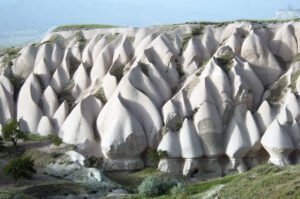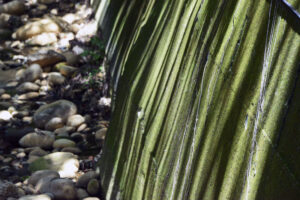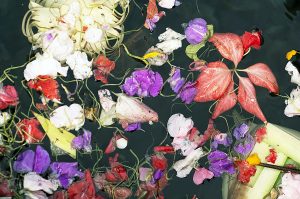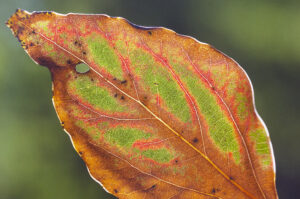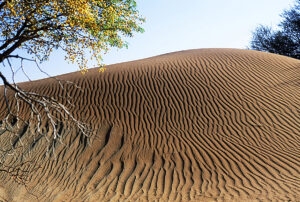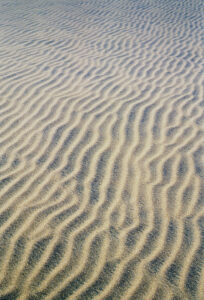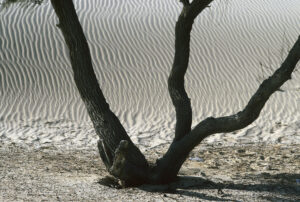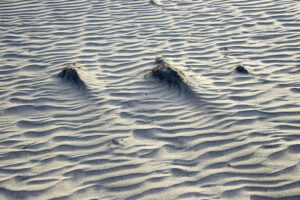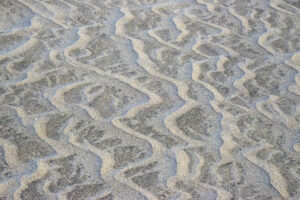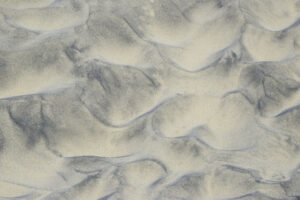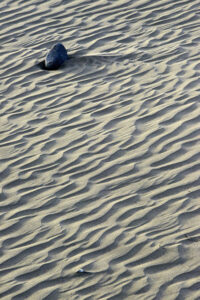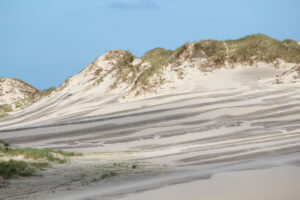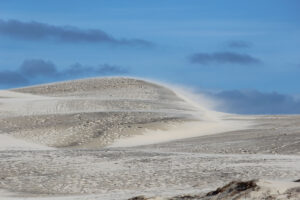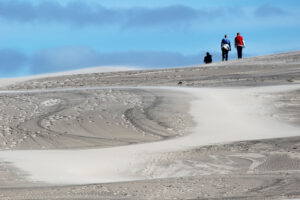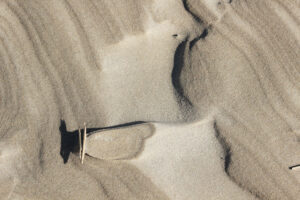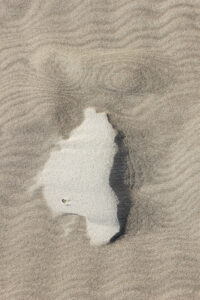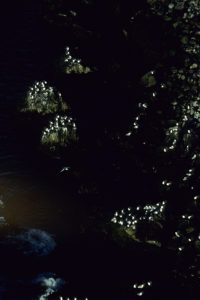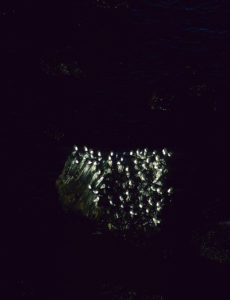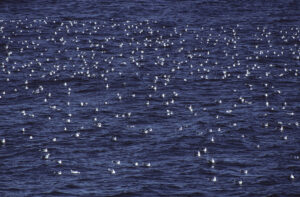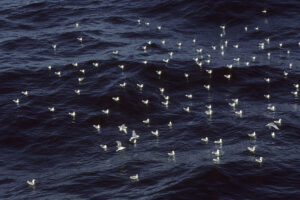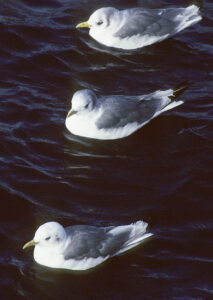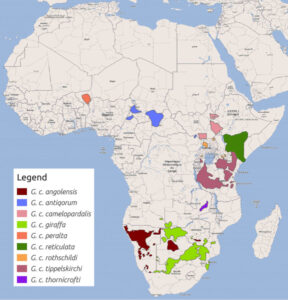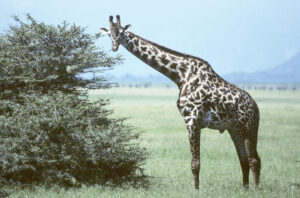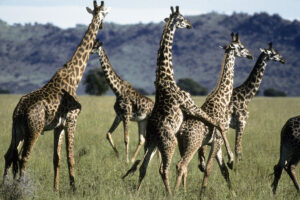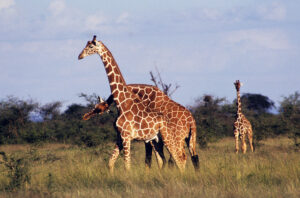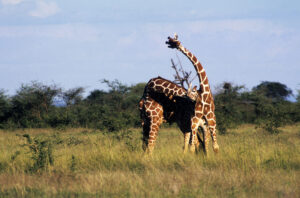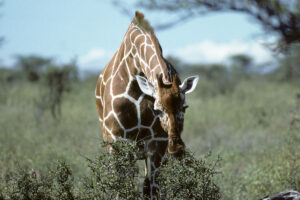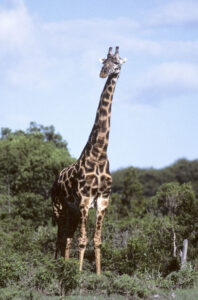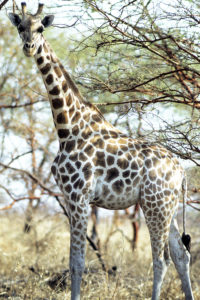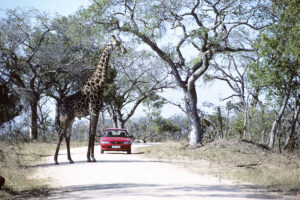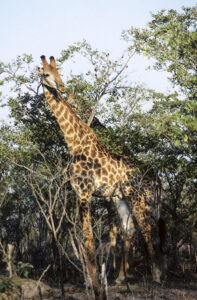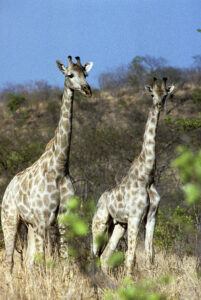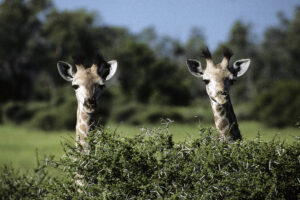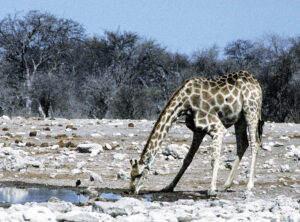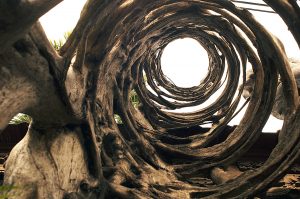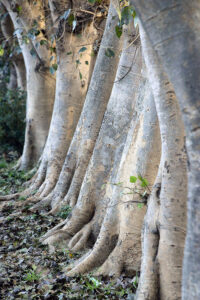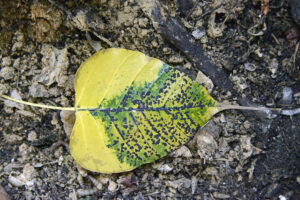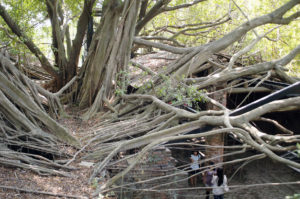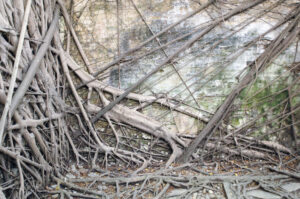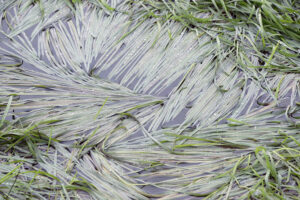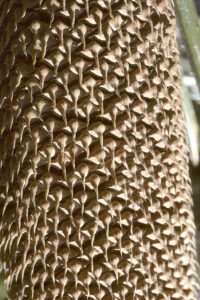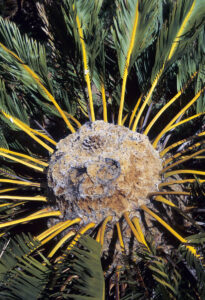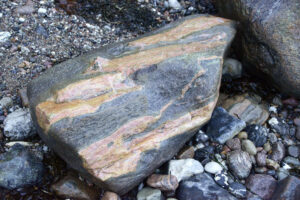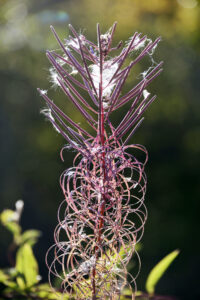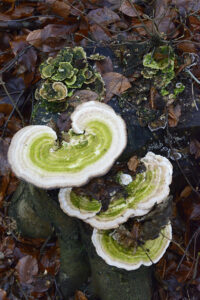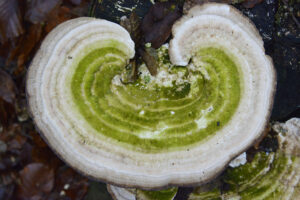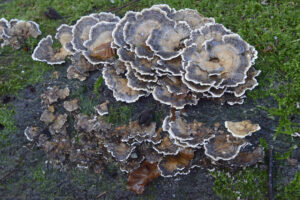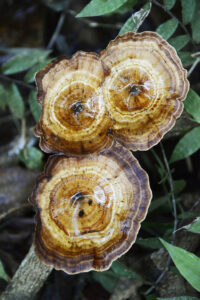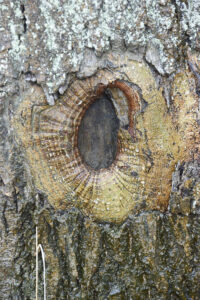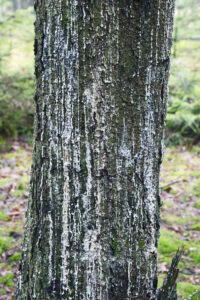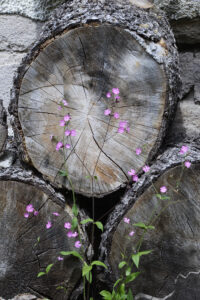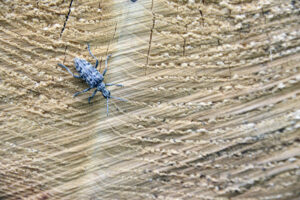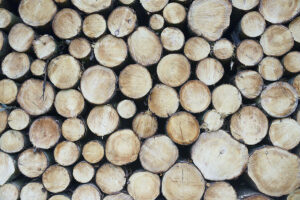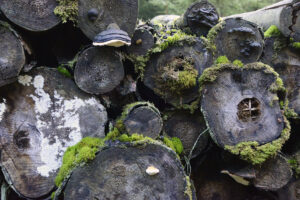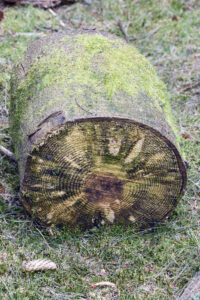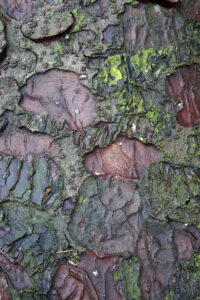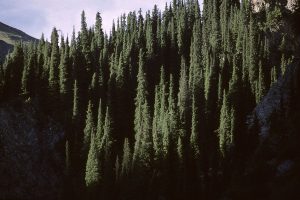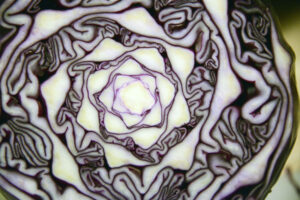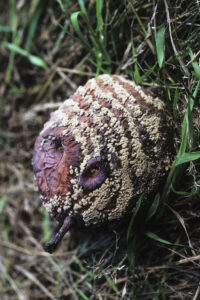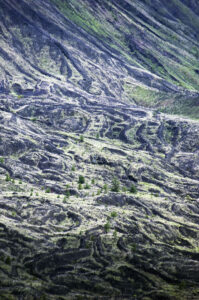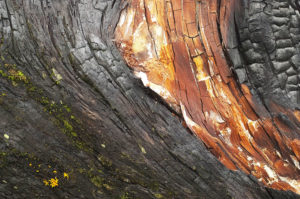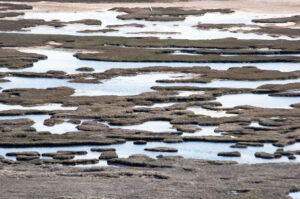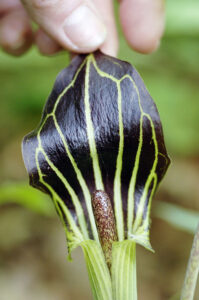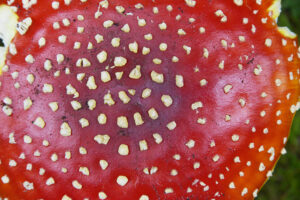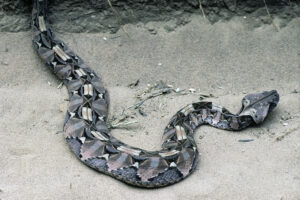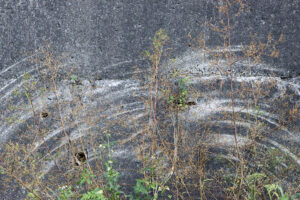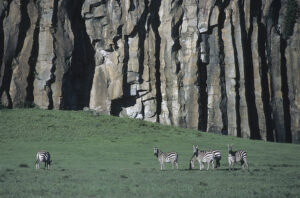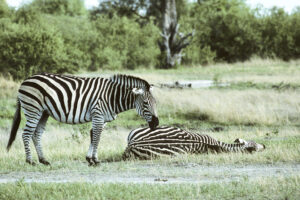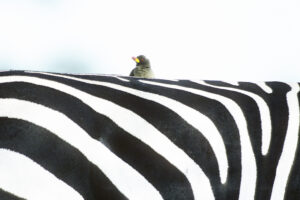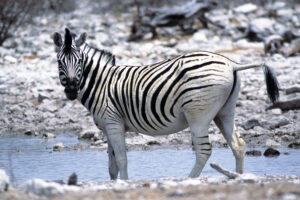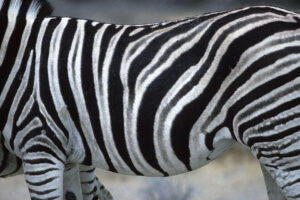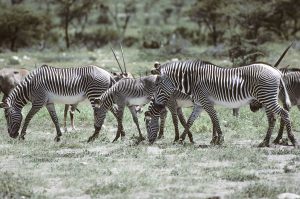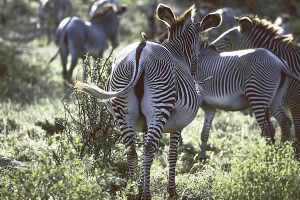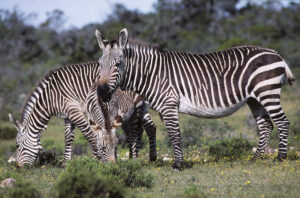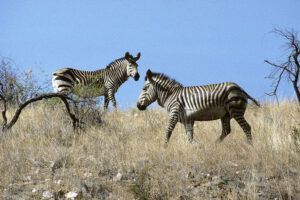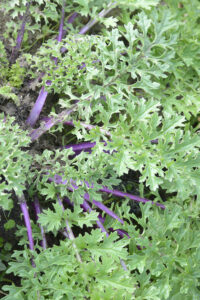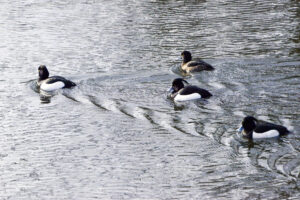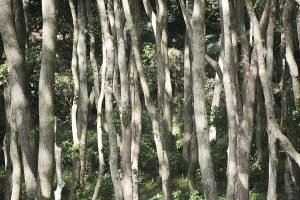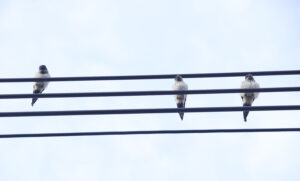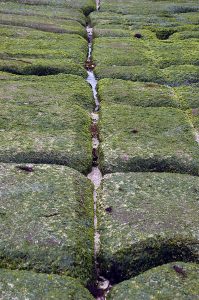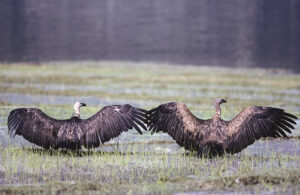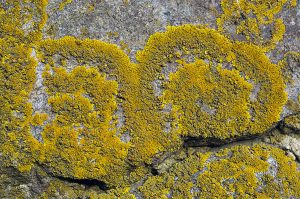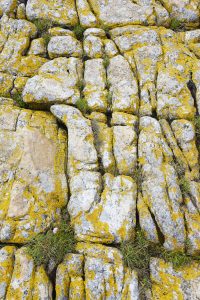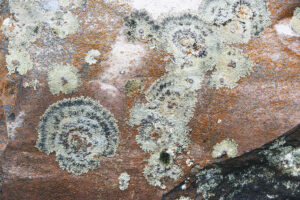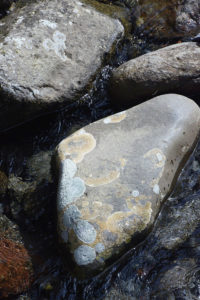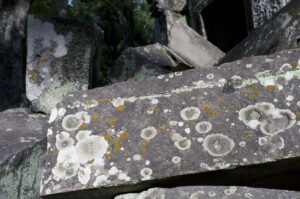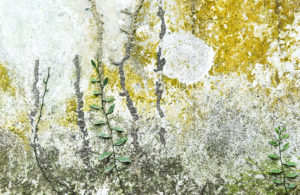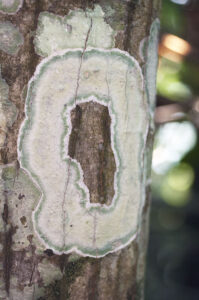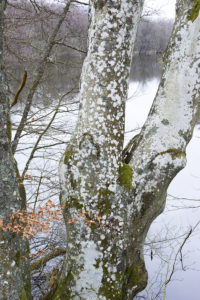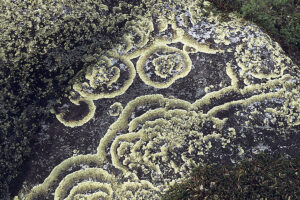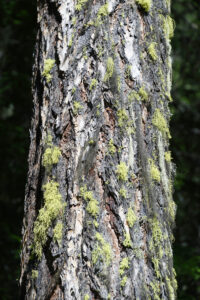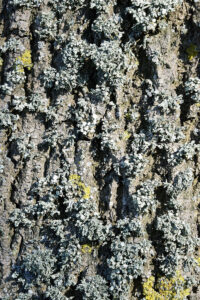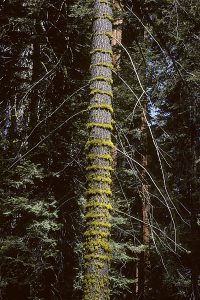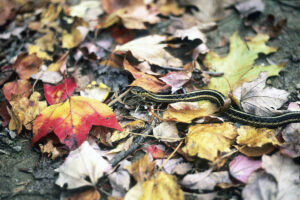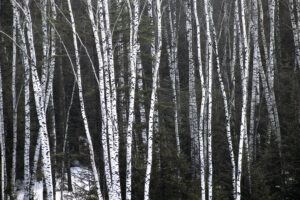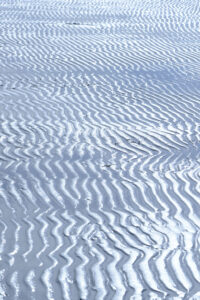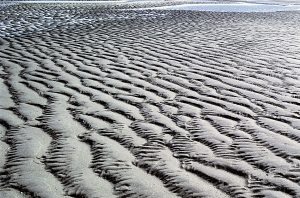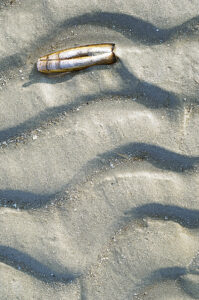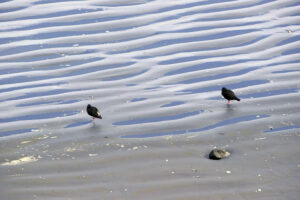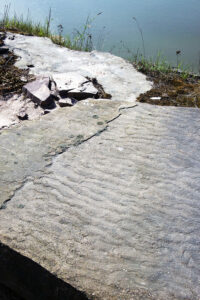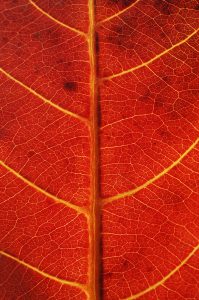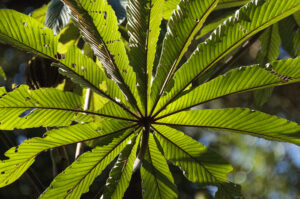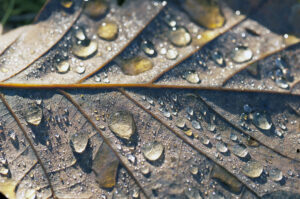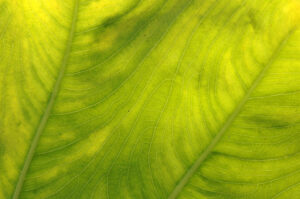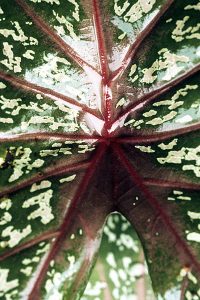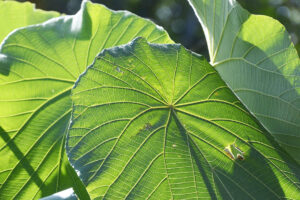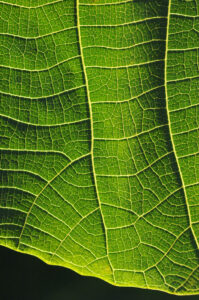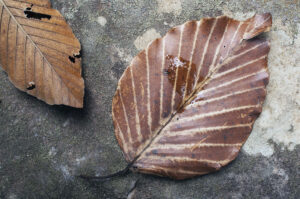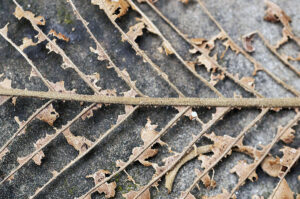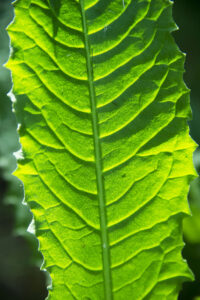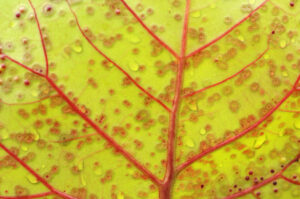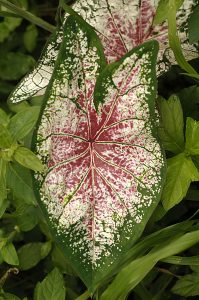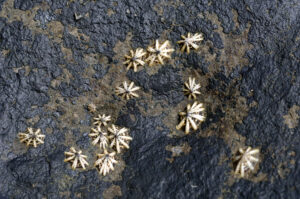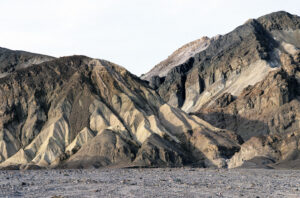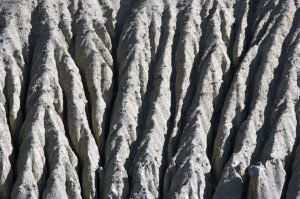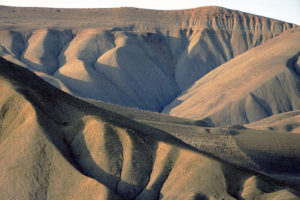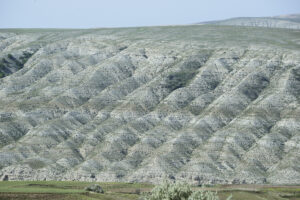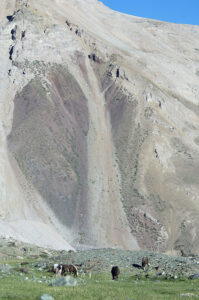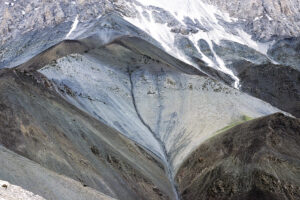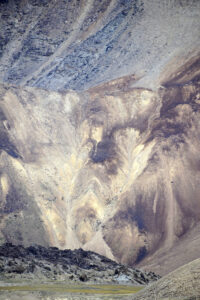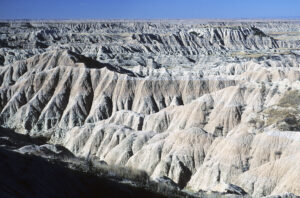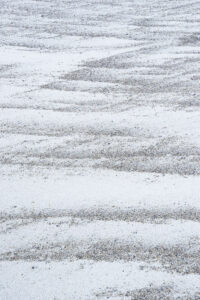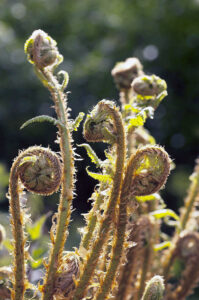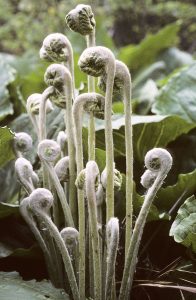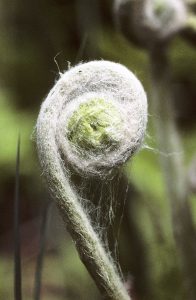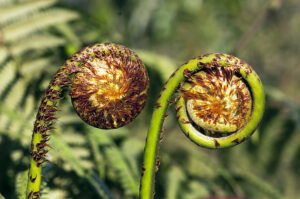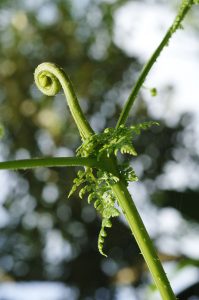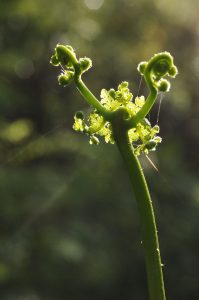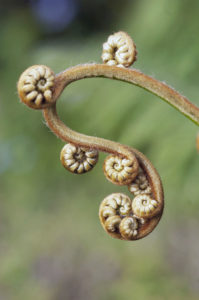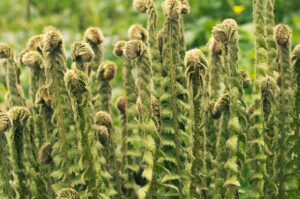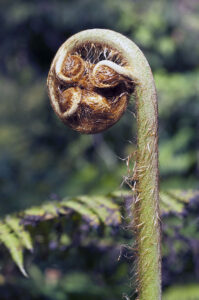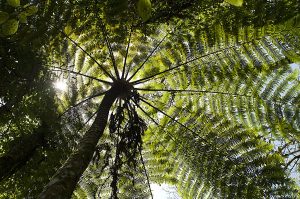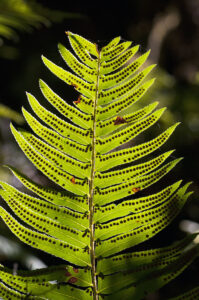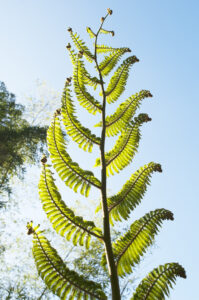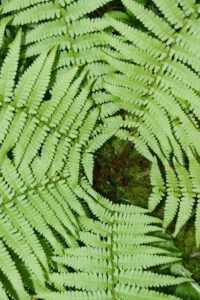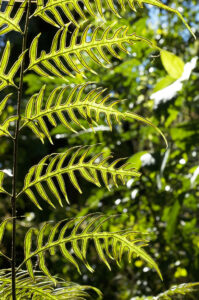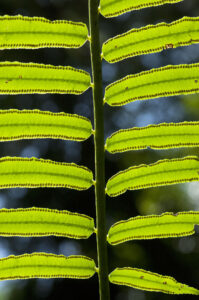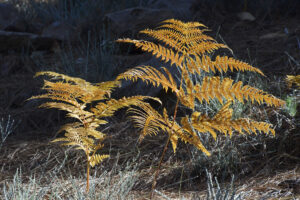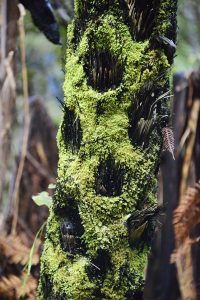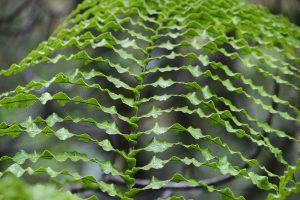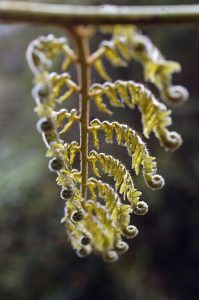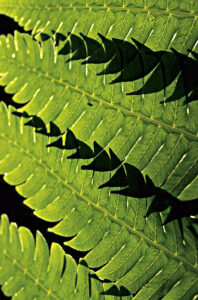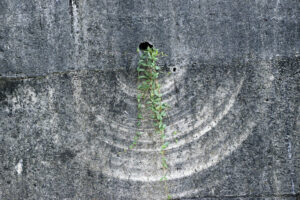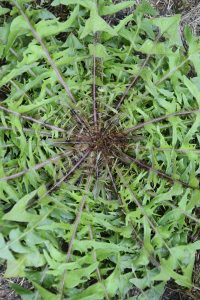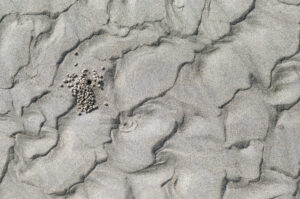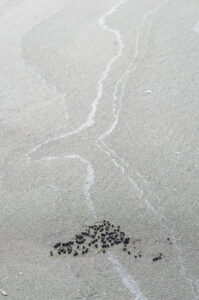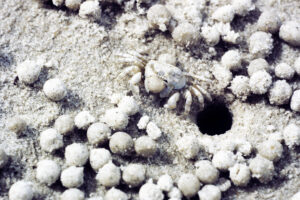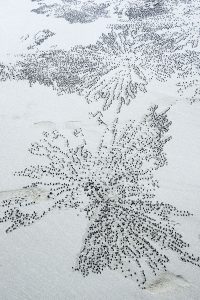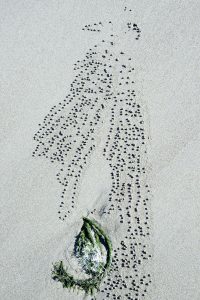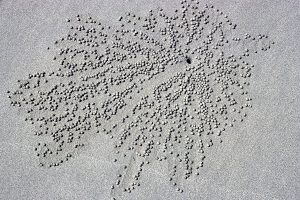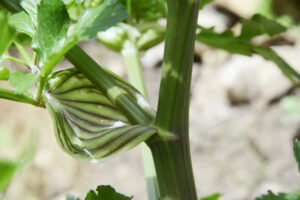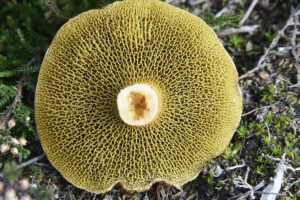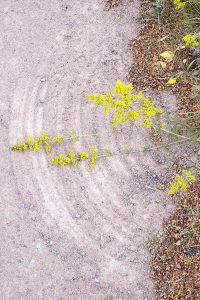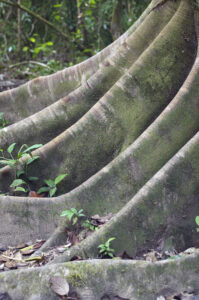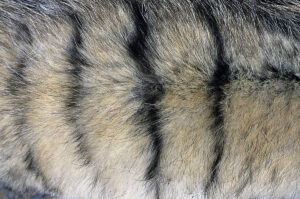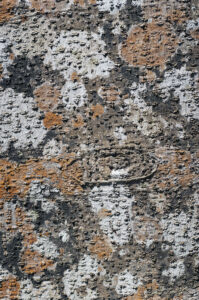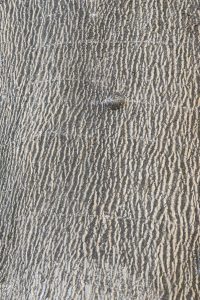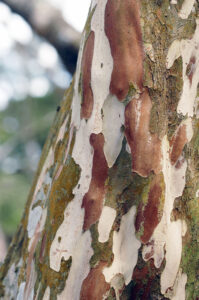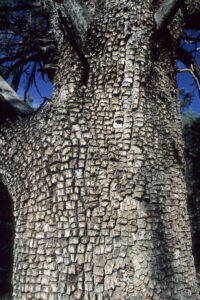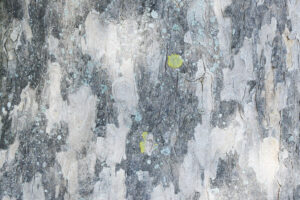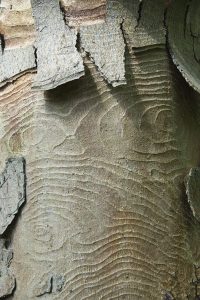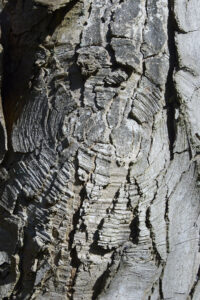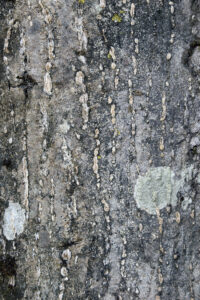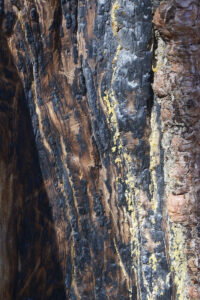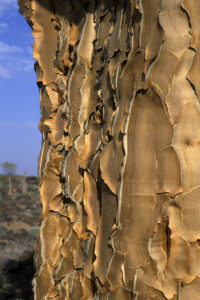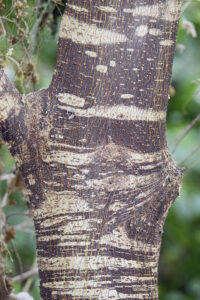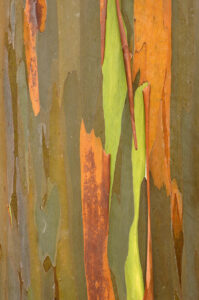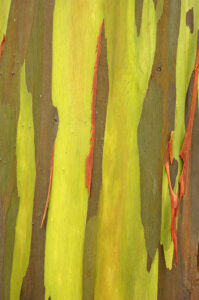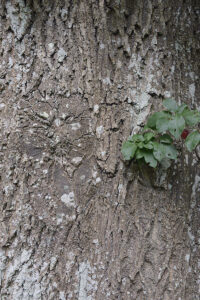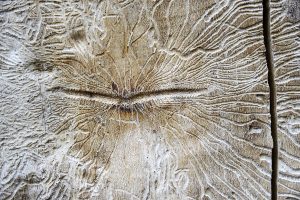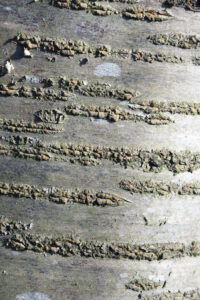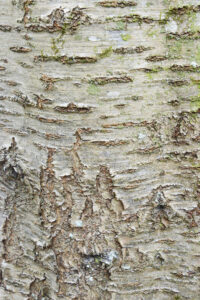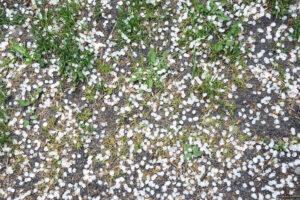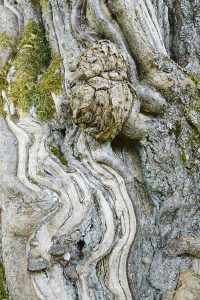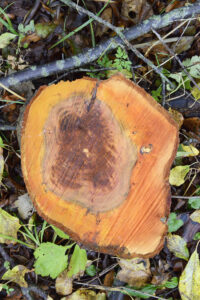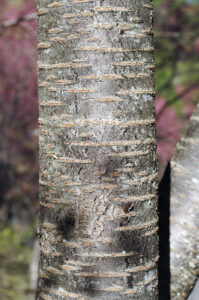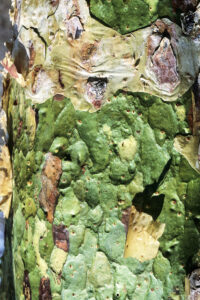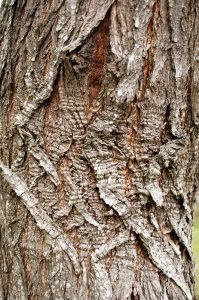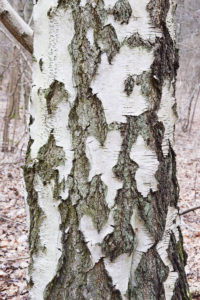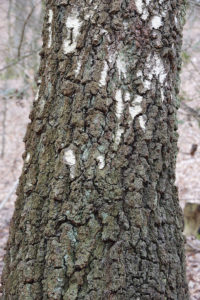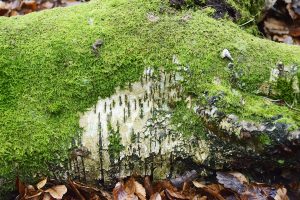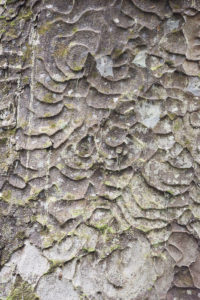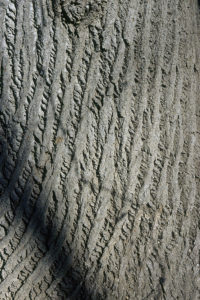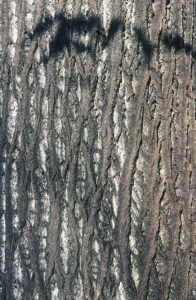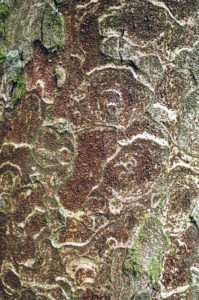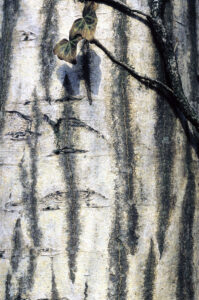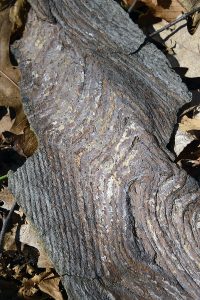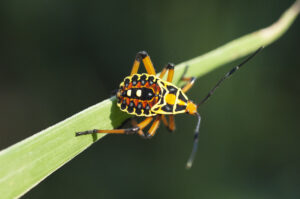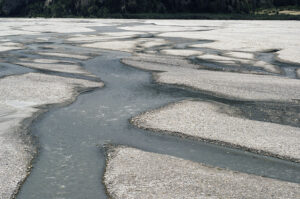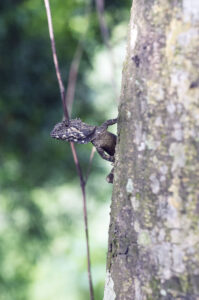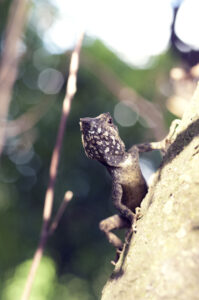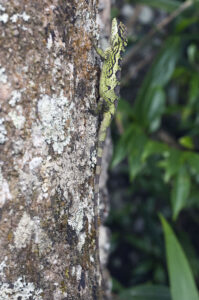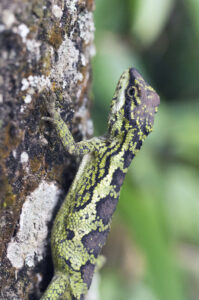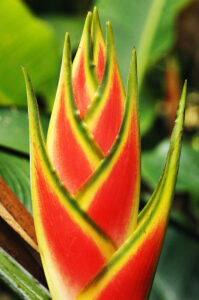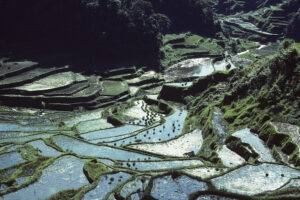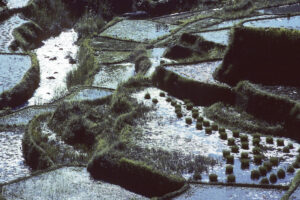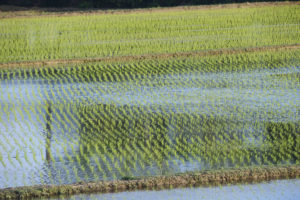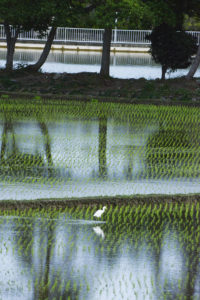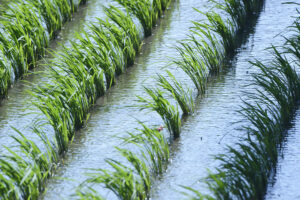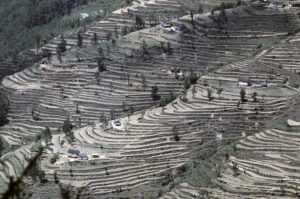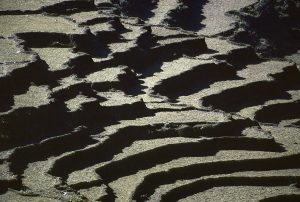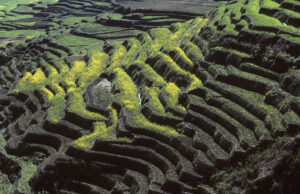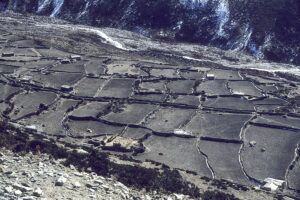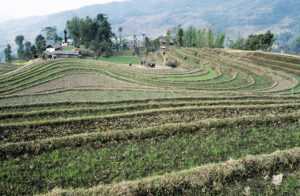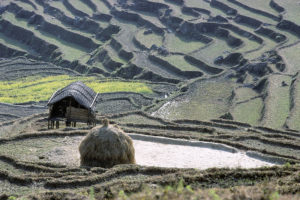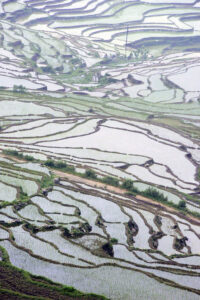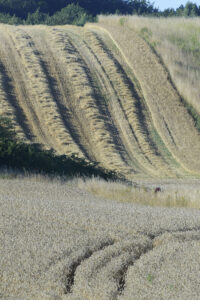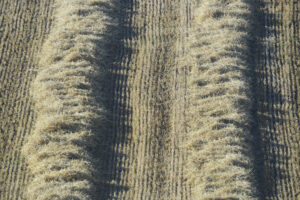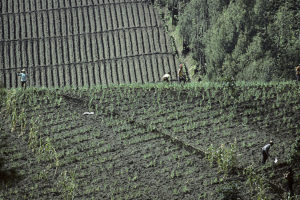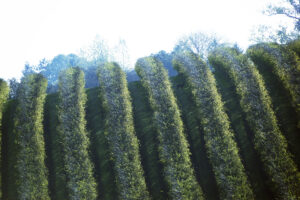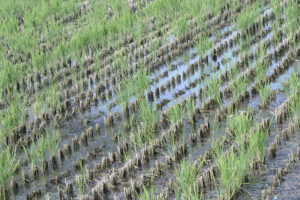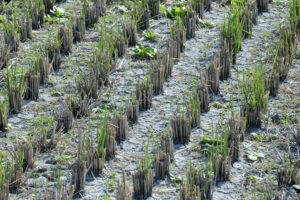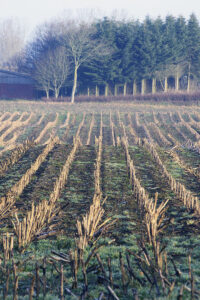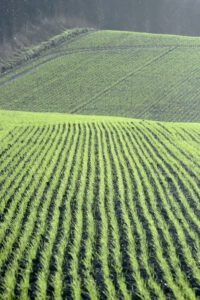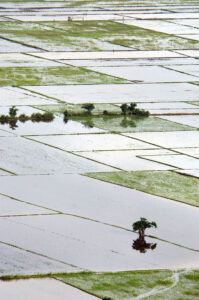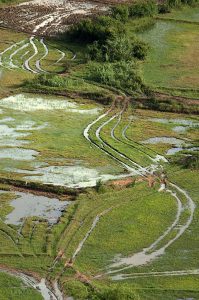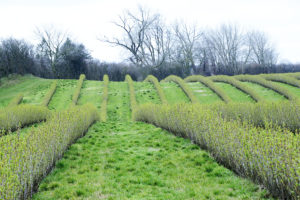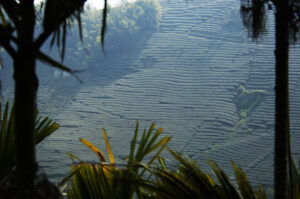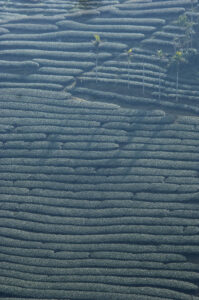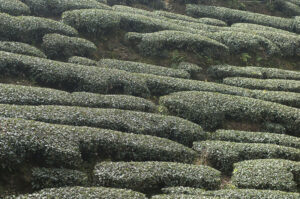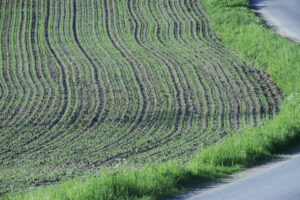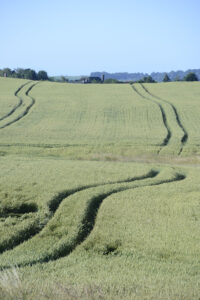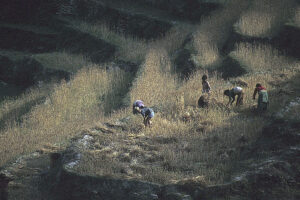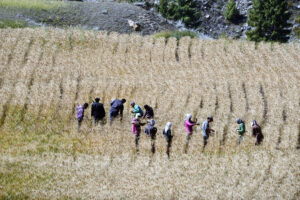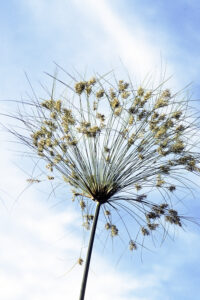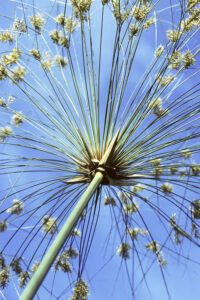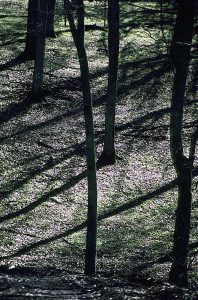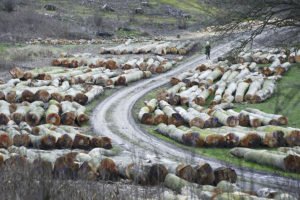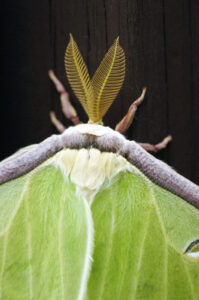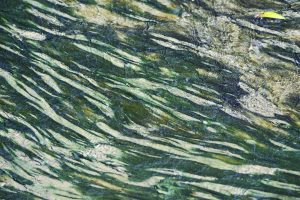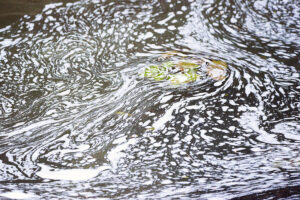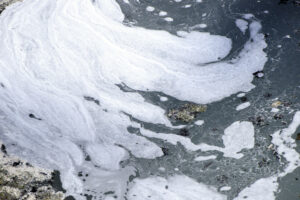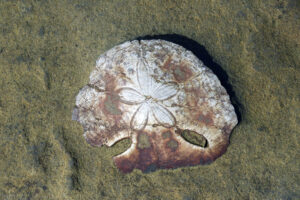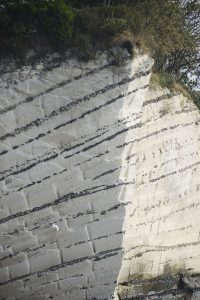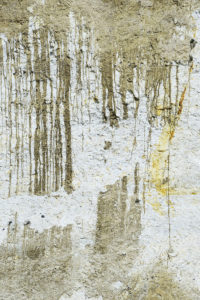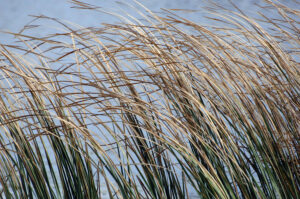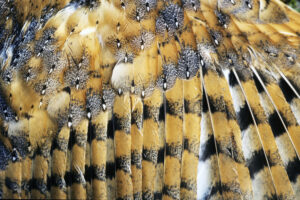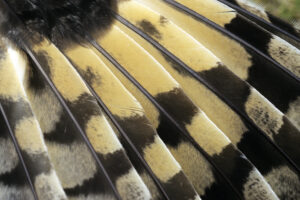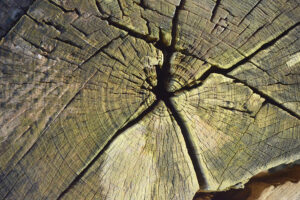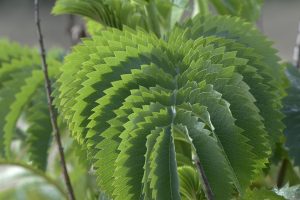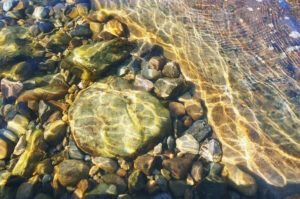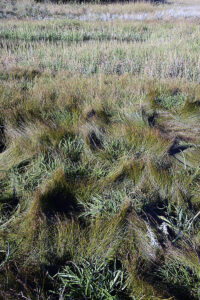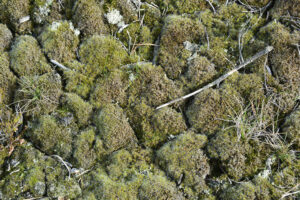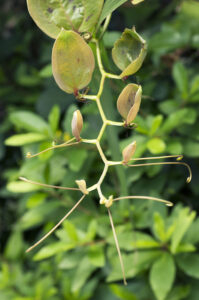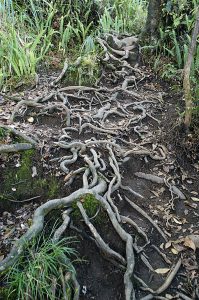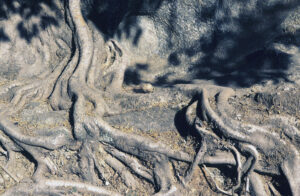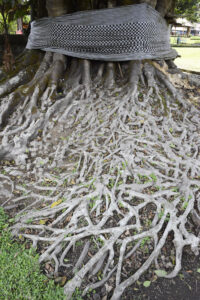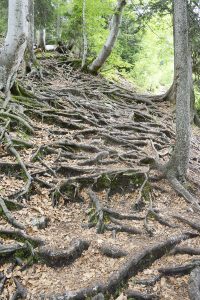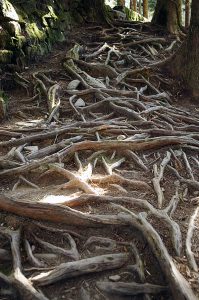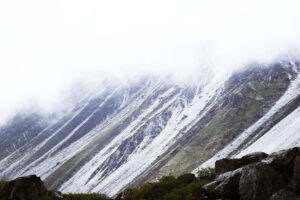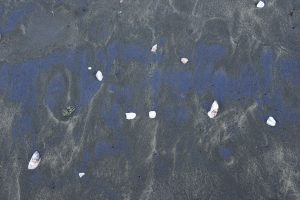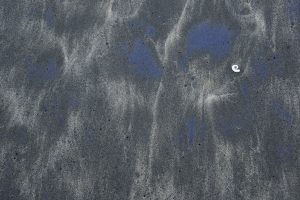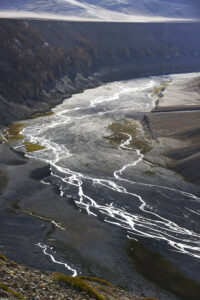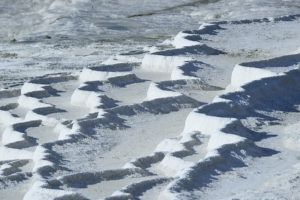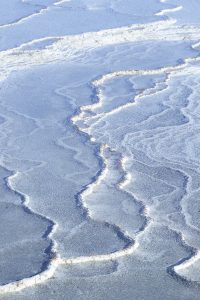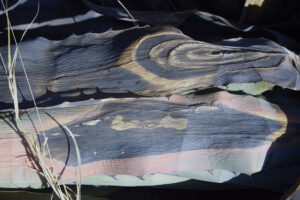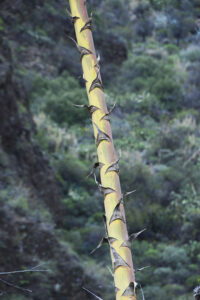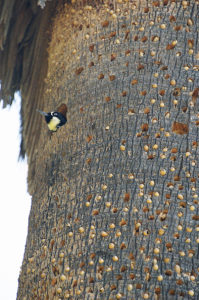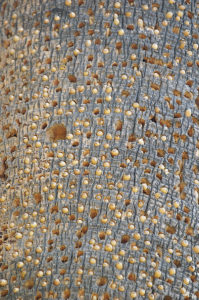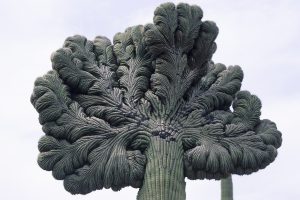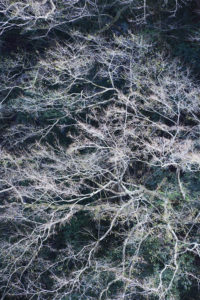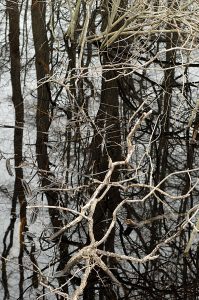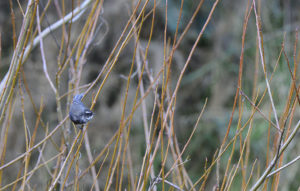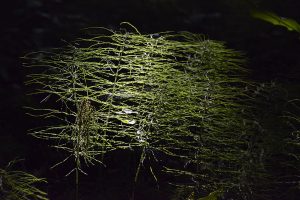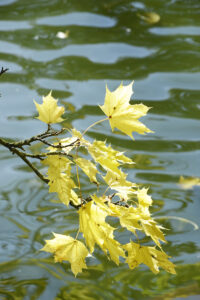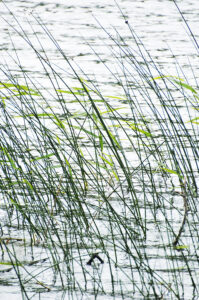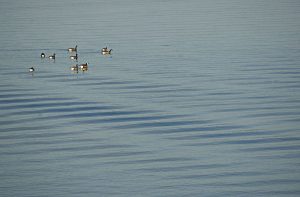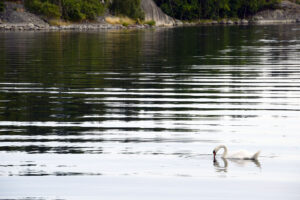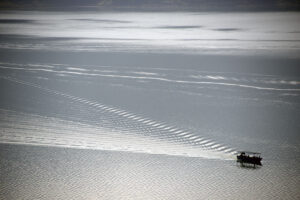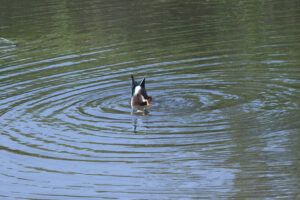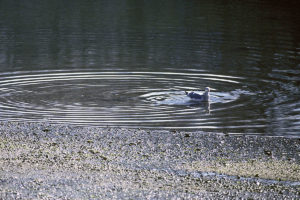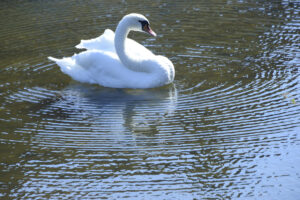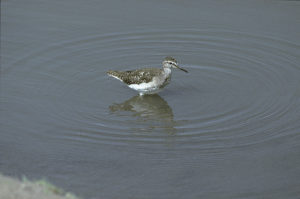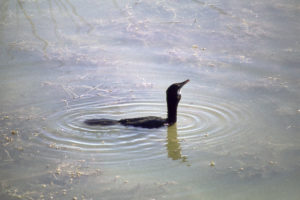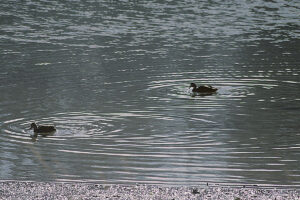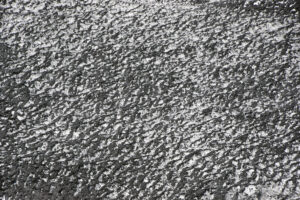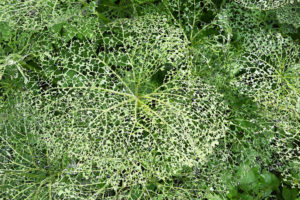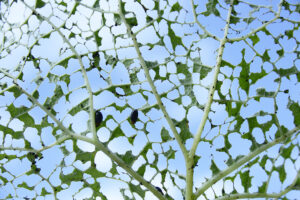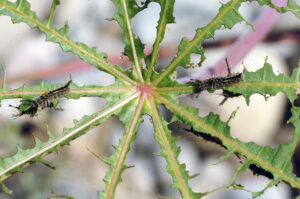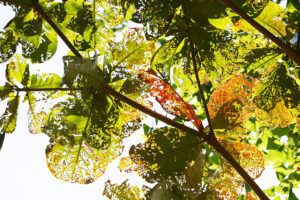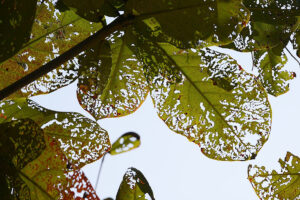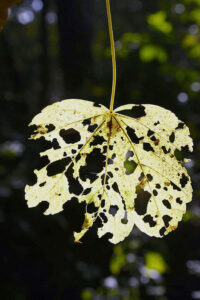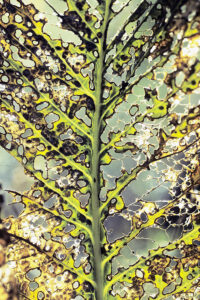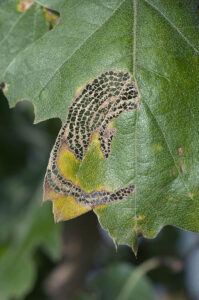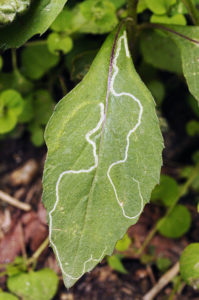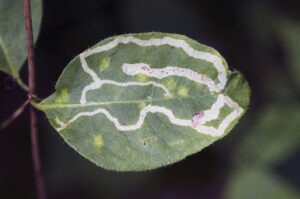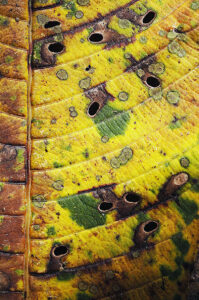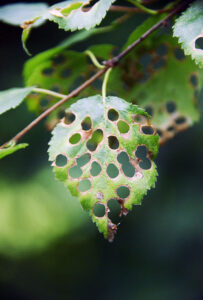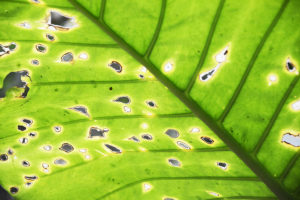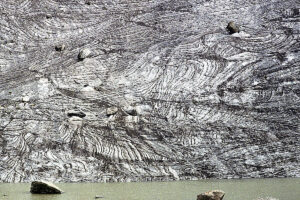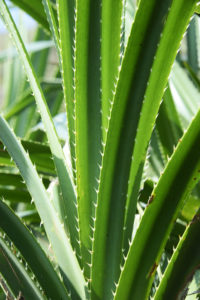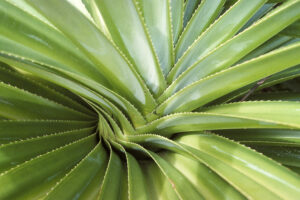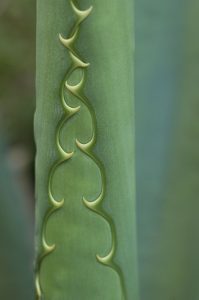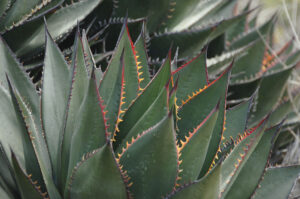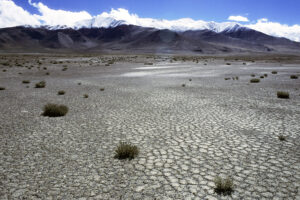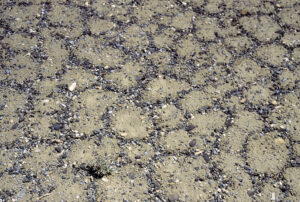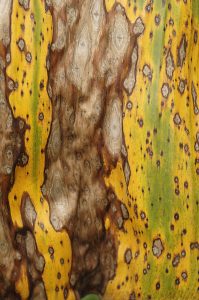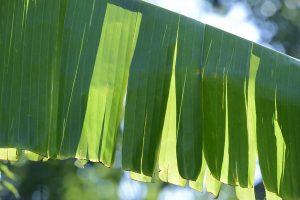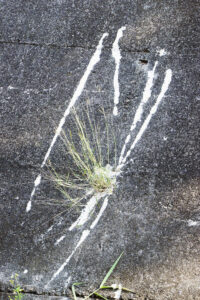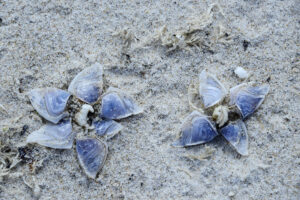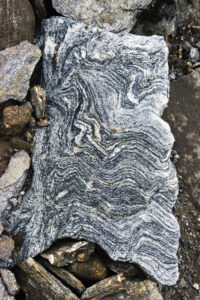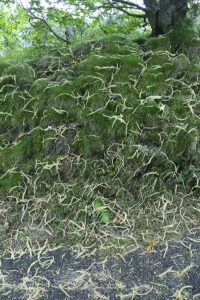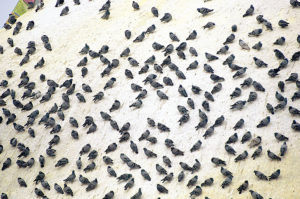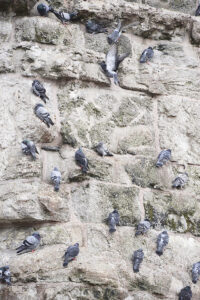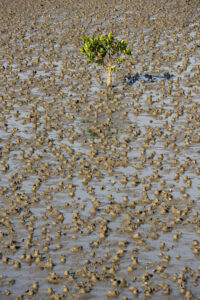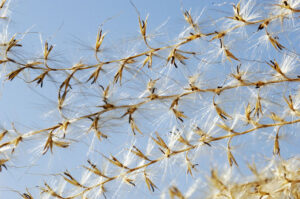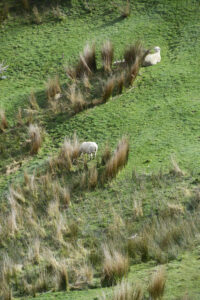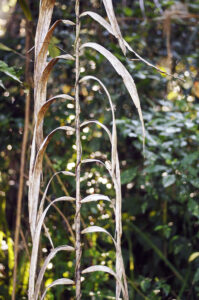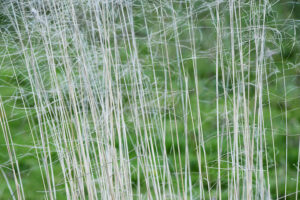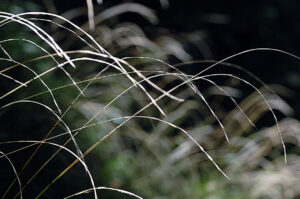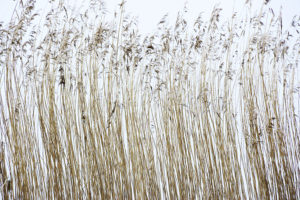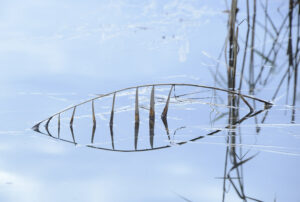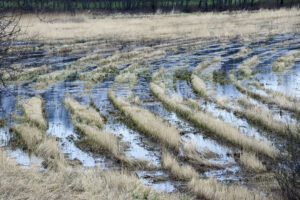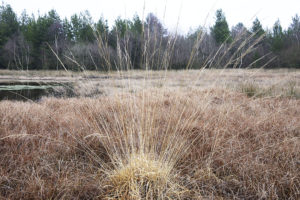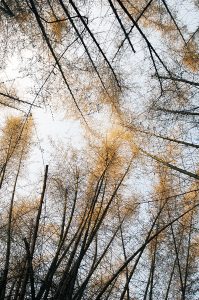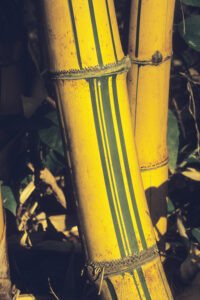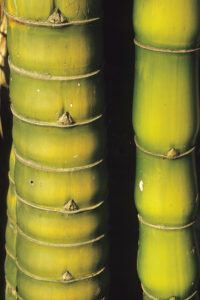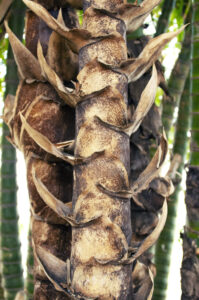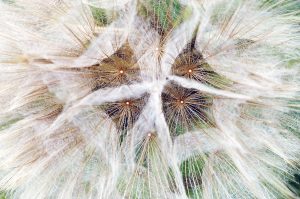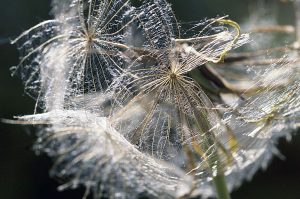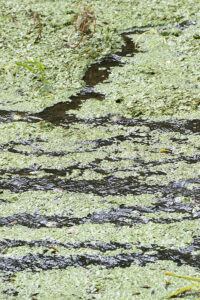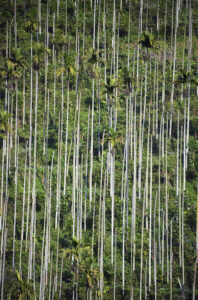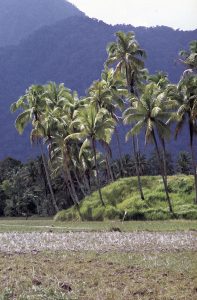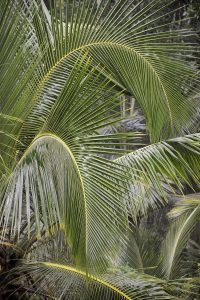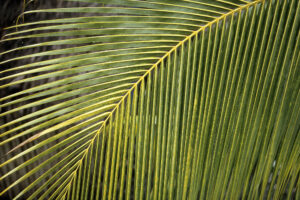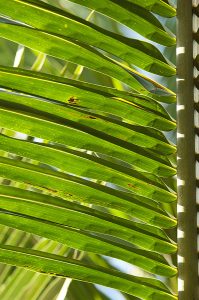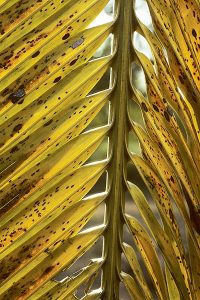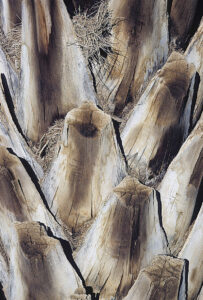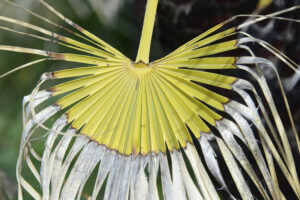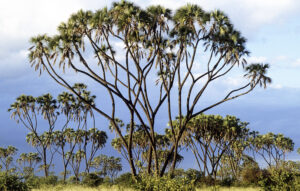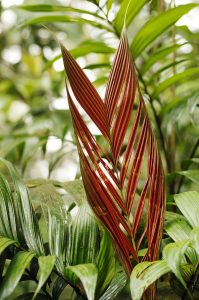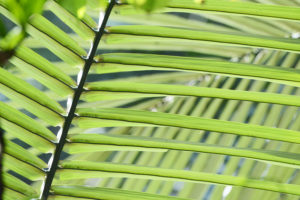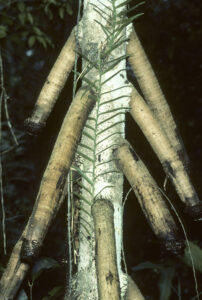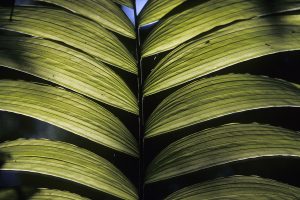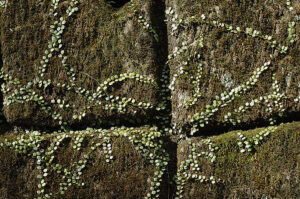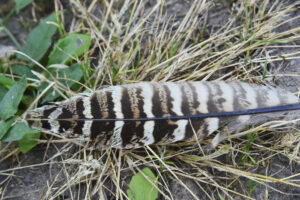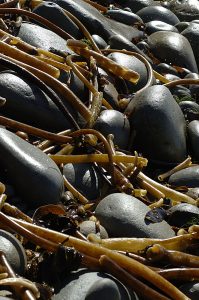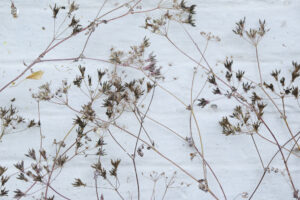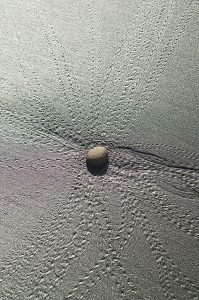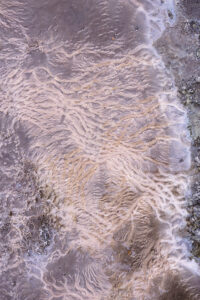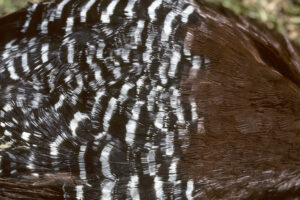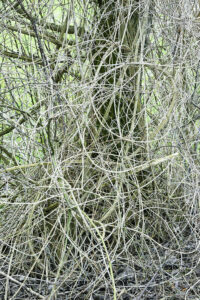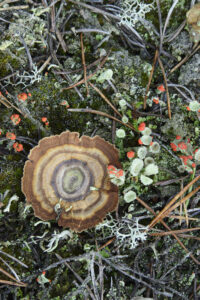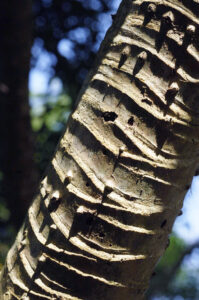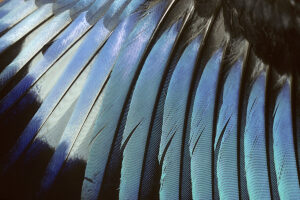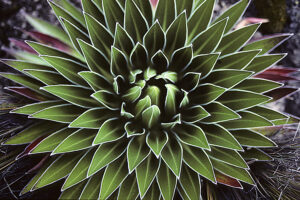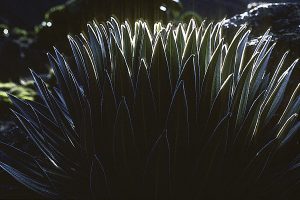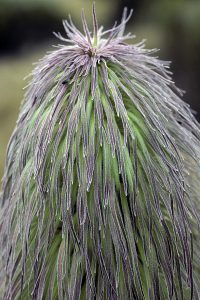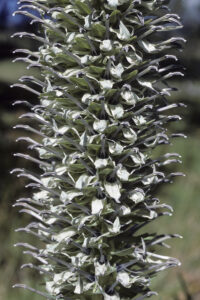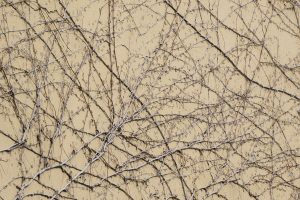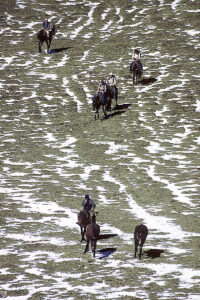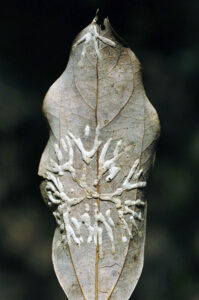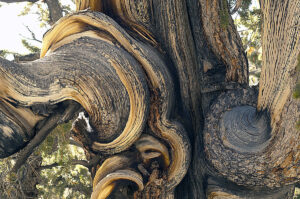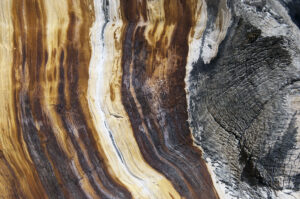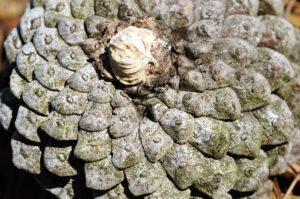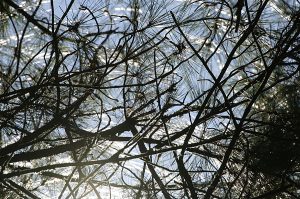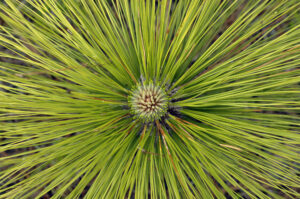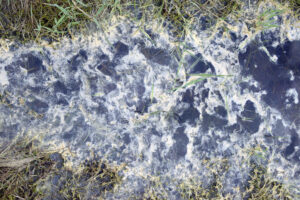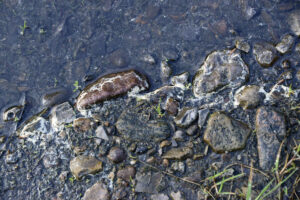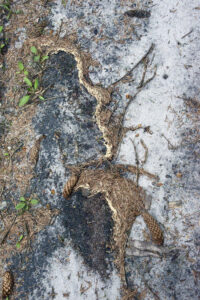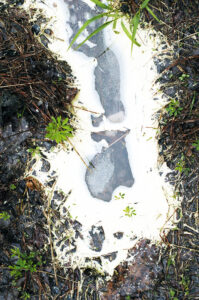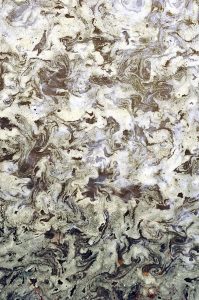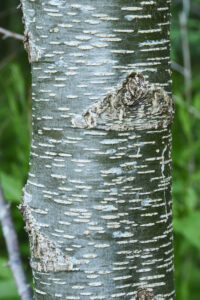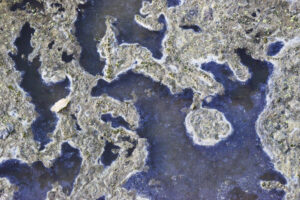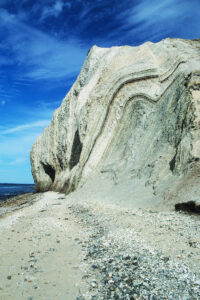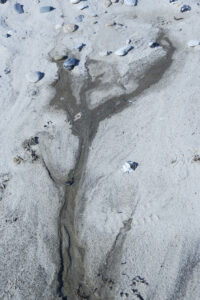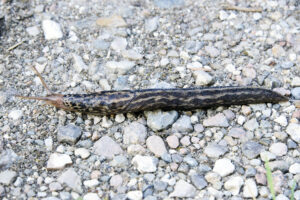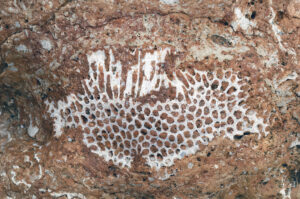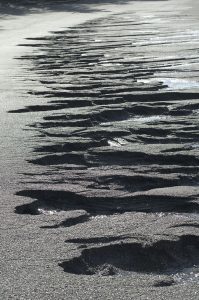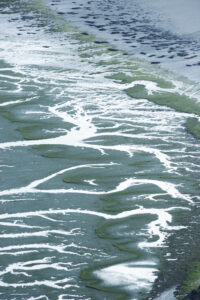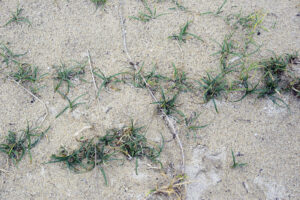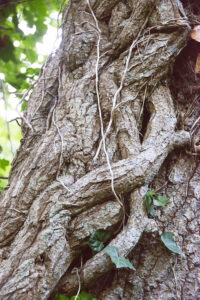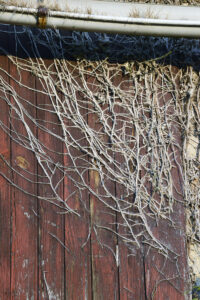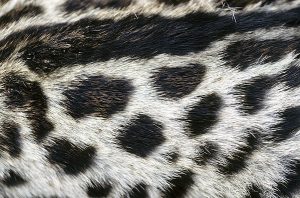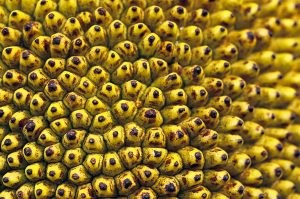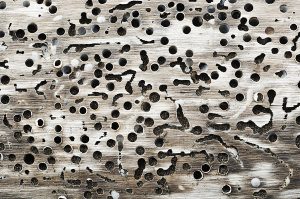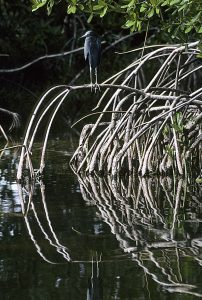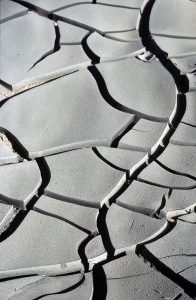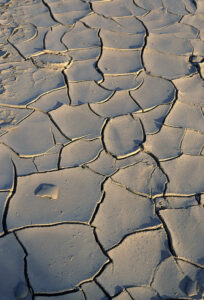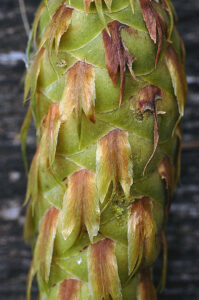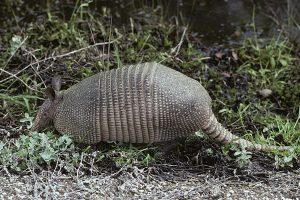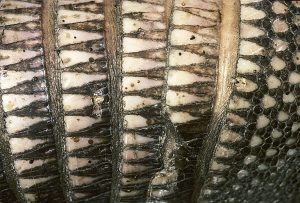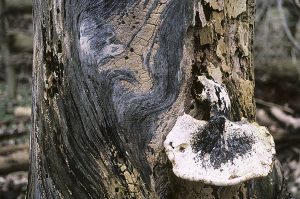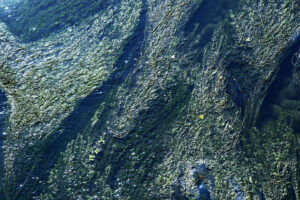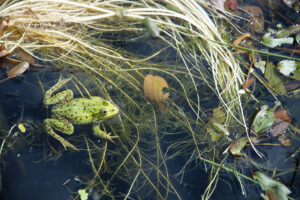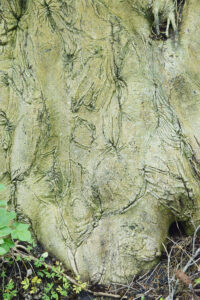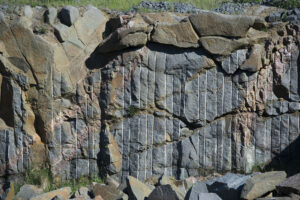Nature’s patterns
A beautiful pattern is created by these eroded rock formations, consisting of volcanic tuff, Göreme, central Turkey. (Photo copyright © by Kaj Halberg)
Light and shadows on a wall along a canal, overgrown by green algae, Taichung, Taiwan. (Photo copyright © by Kaj Halberg)
Flowers and leaves, which have been brought as an offering to the Hindu Water Temple near Ubud, Bali, Indonesia, are now floating on the surface of a pond. (Photo copyright © by Kaj Halberg)
Patterns in a withered leaf, Basianshan National Forest, Taiwan. (Photo copyright © by Kaj Halberg)
“(…) in every case it was the northern face [of the dune], which was steep. On this side, the sand fell away from beneath the summit in an unbroken wall, set at as steep an angle as the grains of sand would lie. Down this face small avalanches constantly subsided, each fall leaving a temporary, light-coloured smear upon the surface of the sand. On either side of this face, sharp-crested ridges swept down in undulating curves, and behind them were other alternating ridges and troughs, smaller and more involved, as they became farther from the main face. The sand on the lower slopes at the back of the dune was firm, and rose and fell in broad sinuous trenches, or was dimpled with shallow holes. The surface of the sand was marked with diminutive ripples, of which the ridges were built from the heavier and darker grains, while the hollows were filled with the smaller paler-coloured stuff. Continuously, the wind shifted the sand, separating the heavier from the lighter grains, which are always of different colour. Only once did I notice sands, where the large were paler than the small. Although they are the least numerous, it is the large grains which give the prevailing hue to the landscape. Disturb the surface of the sand, and the underlying paleness is immediately revealed. It is this blending of two colours, which gives such depth and richness of the Sands: gold with silver, orange with cream, brick-red with white, burnt-brown with pink, yellow with grey – they have an infinite variety of shades and colours.”
British explorer and author Wilfred Thesiger (1910-2003) in his book Arabian Sands, Longmans 1959.
Ripples on a reddish sand dune, Sossusvlei, Namib Desert, western Namibia. These dunes and other natural phenomena in Namibia are described on the page Countries and places: Namibia – a desert country. (Photo copyright © by Kaj Halberg)
Ripples on another sand dune in Namibia, near Swakopmund. Darker grains have gathered in the grooves. (Photo copyright © by Kaj Halberg)
Ripples on a dune near Rabaa, Egypt. A species of tamarisk, Tamarix africana, is silhouetted against the dune. (Photo copyright © by Kaj Halberg)
Patterns in dunes, Maspalomas, Gran Canaria. (Photos copyright © by Kaj Halberg)
Patterns in a wandering dune, Råbjerg Mile, Jutland, Denmark. (Photos copyright © by Kaj Halberg)
The kittiwake (Rissa tridactyla) is a small gull, which is widely distributed in Arctic seas, breeding in colonies on steep rocks or cliffs, where each pair builds a nest, consisting of plants and seaweeds, on a narrow ledge. As a breeding bird, this species is found southwards to the Kuril Islands, southern Alaska, Newfoundland, the British Isles, and France, with scattered colonies in Portugal and Spain. In winter, it disperses to a huge area in subarctic and temperate seas.
The generic name is derived from the Icelandic name of the bird, rita, whereas the English name was given in allusion to its call. The specific name is from the Greek tridaktylos (‘three toes’), referring to the fact that this species is missing the small, back-pointing fourth toe, which most other gull species possess.
In North America, this species is called black-legged kittiwake to differentiate it from its near relative, the red-legged kittiwake (Rissa brevirostris), which breeds on small islands in the far northern Pacific.
White kittiwakes, breeding on a dark rock monolith, off Rauðanupur (‘Red Cliff’), northern Iceland. (Photos copyright © by Kaj Halberg)
Resting kittiwakes, creating patterns in the Denmark Strait, between Greenland and Iceland. (Photos copyright © by Kaj Halberg)
The giraffe (Giraffa camelopardalis) is one of only two living genera of the family Giraffidae, the other being the okapi (Okapia johnstoni) in Zaire.
The tall and seemingly ungainly giraffe was once distributed throughout Africa, except in rainforest. However, it has diminished alarmingly, and today there may be less than 100,000 individuals.
According to the International Union for Conservation of Nature (IUCN), only one species of giraffe exists, divided into nine subspecies, whereas other authorities recognize up to eight separate species.
The generic name was derived from the Arabic zarafah, ultimately from Persian sotorgavpalang (‘camel-ox-leopard’), whereas the specific name is derived from the Greek kamelos (‘camel’) and pardos (‘leopard’), and the Latin alis (‘resembling’), alluding to its camel-like shape and leopard-like pattern.
This map shows the distribution of the nine subspecies of the giraffe. (Borrowed from Wikipedia)
The Masai giraffe, subspecies tippelskirchi, lives in Kenya and Tanzania. It has a jagged pattern.
Masai giraffe, feeding on acacia leaves, Lake Manyara National Park, Tanzania. (Photo copyright © by Kaj Halberg)
Two bulls of Masai giraffe, engaged in dominance display. In turn they bang their head against the other bull’s neck. Afterwards, the dominant bull mounts its opponent. – Serengeti National Park, Tanzania. (Photos copyright © by Kaj Halberg)
The reticulated giraffe, subspecies reticulata, is native to southern Ethiopia, Somalia, and north-eastern Kenya. It has a reddish-brown rhombic pattern with narrow white stripes.
In Arusha National Park, northern Tanzania, the pattern of the local giraffes is quite unique, a mixture of reticulated and Masai giraffes. Some authorities regard them as hybrids between these two subspecies, naming them Galana giraffes.
Bulls of reticulated giraffe, engaged in dominance display, Meru National Park, Kenya. (Photos copyright © by Kaj Halberg)
Reticulated giraffe, feeding on acacia leaves, Buffalo Springs National Park, Kenya. (Photo copyright © by Kaj Halberg)
A so-called Galana giraffe, maybe a hybrid between reticulated giraffe and Masai giraffe, Arusha National Park, Tanzania. (Photo copyright © by Kaj Halberg)
The Kordofan giraffe, subspecies antiquorum, is distributed in southern Chad, the Central African Republic, northern Cameroun, and north-eastern Zaire. Formerly, it was believed that populations in Cameroun belonged to subspecies peralta, but genetic research has shown that this is incorrect. The pattern somewhat resembles that of the reticulated giraffe, but is much paler.
This subspecies is highly endangered, as only about 400 individuals survive in fragmented populations.
Kordofan giraffe, Waza National Park, Cameroun. (Photo copyright © by Kaj Halberg)
The southern giraffe, subspecies giraffa, lives in Botswana, northern South Africa, and south-western Mozambique. Its pattern is somewhat rhombic, pale brown with a darker centre.
The giraffe is a tall animal. Bulls can reach a height of almost 6 m, cows 5 m. – Southern giraffe, Krüger National Park, South Africa. (Photo copyright © by Kaj Halberg)
Feeding southern giraffe, Krüger National Park. (Photo copyright © by Kaj Halberg)
The Angolan giraffe, subspecies angolensis, is found in south-western Zambia, central Botswana, Zimbabwe, and northern Namibia. The pattern resembles that of the southern giraffe, but is usually much paler.
Angolan giraffes, Hwange National Park, Zimbabwe. (Photo copyright © by Kaj Halberg)
Young Angolan giraffes, Chief’s Island, Okawango, Botswana. (Photo copyright © by Kaj Halberg)
Angolan giraffe, drinking from a waterhole, Etosha National Park, Namibia. The bird is a blacksmith lapwing (Vanellus armatus). (Photo copyright © by Kaj Halberg)
Strangler figs are a group of fig trees that often begin their life as an epiphyte in another tree, where the seed often sprouts in a pile of bird dung, delivered by the bird that ate the fig fruit. Over the years, aerial roots of the strangler fig wrap around the host tree, growing down to the ground, where they take root. Eventually, the host tree is strangled to death, and as its trunk decays, it leaves the strangler fig standing as a hollow cylinder of aerial roots.
Other fig trees are presented on the page Plants: Ancient and huge trees.
As the trunk of the host tree decays, it leaves the strangler fig tree as a hollow cylinder of aerial roots, here in the town of Ubud, Bali, Indonesia. (Photo copyright © by Kaj Halberg)
One strangler fig is pipal (Ficus religiosa), also called sacred fig tree, as it is sacred to Buddhists. It is described in depth on the page Plants: Pipal and banyan – two sacred fig trees. Most pipals begin their life as epiphytes, but also often grows in cracks on buildings. If left alone, its aerial roots will envelop the building and, over time, destroy it.
Morning light is reddening this row of pipal trees in the city of Taichung, Taiwan. This species is widely planted on the island. (Photo copyright © by Kaj Halberg)
Pipal may be identified by the broad, heart-shaped leaves, ending in a long, tapering point. This fallen leaf has been attacked by fungi. – Taichung. (Photo copyright © by Kaj Halberg)
The large-leaved fig tree (Ficus superba) is another strangler fig, which is distributed in China, Japan, and parts of Southeast Asia, southwards to Indonesia. Like pipal, it readily grows on buildings, and it is also able to thrive as a normal free-standing tree.
Aerial roots of a giant large-leaved fig, climbing over the remains of a former warehouse of Tait & Co., in the town of Anping, Taiwan. Today, the building is called Anping Tree House. (Photos copyright © by Kaj Halberg)
Leaves of floating sweetgrass (Glyceria fluitans), eastern Jutland, Denmark. This species is described on the page Plants: Grasses. (Photo copyright © by Kaj Halberg)
Cycads are ancient gymnosperms, which flourished during the late Triassic and the Jurassic, app. 225-150 million years ago. They have a woody trunk with a crown of large, stiff, evergreen, palm-like leaves, and plants are either male or female, both having a cone-like flowering club at the end of the trunk. Most species grow very slowly, and some specimens may be as much as a thousand years old.
Cycas rumphii is a small tree, growing to about 10 m tall, with a trunk to 40 cm across. The bright green leaves, to 2.5 m long, is divided into 150-200 leaflets. The species is native to Indonesia, New Guinea and Christmas Island, but is widely cultivated elsewhere.
The specific name was given in honour of Dutch naturalist Georg Eberhard Rumphius (1628-1702), who served as a military officer with the Dutch East India Company.
Cone of Cycas rumphii with seeds, Mayabunder, Andaman Islands, India. (Photo copyright © by Kaj Halberg)
A cultivated cycad, Encephalartos friederici-guilielmi, Botanical Garden, Cape Town, South Africa. (Photo copyright © by Kaj Halberg)
Stone with patterns, Lyø, Funen, Denmark. (Photo copyright © by Kaj Halberg)
A jumble of of rosebay willowherb (Chamaenerion angustifolium) create a complicated pattern, Öland, Sweden. The upper ones are still unripe, whereas the lower ones have already spread their seeds. This species is described in depth on the page Nature Reserve Vorsø: Expanding wilderness. (Photo copyright © by Kaj Halberg)
Green algae, growing on hairy bracket (Trametes hirsuta), a member of the polypore family (Polyporaceae), Funen, Denmark. (Photos copyright © by Kaj Halberg)
A close relative is Trametes versicolor, here photographed in Velling Skov, Jutland, Denmark. One of its common names is turkey-tail, given due to its shape and multiple colors, which resemble those of the tail of the wild turkey (Meleagris gallopavo). (Photo copyright © by Kaj Halberg)
Yet another member of Polyporaceae, growing on a rotten stick in Sinharaja Forest Reserve, Sri Lanka. (Photo copyright © by Kaj Halberg)
Knot in the trunk of a Norway maple (Acer platanoides), Funen, Denmark. This species is described on the page Plants: Ancient and huge trees. (Photo copyright © by Kaj Halberg)
Spruces (Picea), a genus with about 35 species of conifers, are native to temperate areas of the northern hemisphere. Some species grow to a very large size, up to 60 m tall.
Resin, creating patterns on a spruce trunk, Gludsted Plantation, Jutland, Denmark. (Photo copyright © by Kaj Halberg)
Red campion (Silene dioica) in front of stacked spruce trunks, Plan de Gralba, Val Gardena, Dolomites, Italy. The red campion is described on the page In praise of the colour red. (Photo copyright © by Kaj Halberg)
Black-spotted longhorn beetle (Rhagium mordax) on a sawn spruce log, Jutland, Denmark. This beetle of the family Cerambycidae grows to about 2.3 cm long. It is found in the entire Europe, eastwards to Kazakhstan. (Photo copyright © by Kaj Halberg)
The Norway spruce (Picea abies) is native from Scandinavia and the Alps, southwards to the Balkans and eastwards to somewhere in Russia. Its eastern limit is very difficult to define, as it hybridizes freely with the Siberian spruce (P. obovata), which is distributed from western Russia and eastern Finland eastwards across Siberia. Norway spruce is widely planted elsewhere for its wood. The specific name abies is the Latin generic name of firs. This name was given in allusion to the fact that Norway spruce, at some distance, often resembles the common fir (Abies alba).
Stacked trunks of Norway spruce, Zealand, Denmark. (Photo copyright © by Kaj Halberg)
Stacked trunks of Norway spruce, Store Hjøllund Plantation, Jutland, Denmark. A polyporous fungus, Ischnoderma benzoinum, is seen above. (Photo copyright © by Kaj Halberg)
Patterns in a sawn trunk of Norway spruce, Store Hjøllund Plantation. (Photo copyright © by Kaj Halberg)
Sitka spruce (Picea sitchensis) is a huge conifer, which may sometimes grow to almost 100 m tall, with a trunk diameter over 5 m. It is by far the largest species of spruce and among the 5 largest conifers in the world, and the third-tallest.
It is a native along the American Pacific coast, from southern Alaska southwards to northern California. However, it is widely cultivated elsewhere in cooler regions around the globe.
The specific and common names refer to the community of Sitka in south-eastern Alaska, where it is common.
Patterns on a fallen trunk of Sitka spruce, Vrads Sande, Jutland, Denmark. (Photos copyright © by Kaj Halberg)
Schrenk’s spruce (Picea schrenkiana) can grow to a large tree, to 50 m tall and with a trunk diameter up to 2 m. It is restricted to the Tien Shan Mountains in Xinjiang, Kazakhstan, and Kyrgyzstan, usually forming pure forests at altitudes between 1,200 and 3,500 m. Two subspecies are found, schrenkiana in Kazakhstan and Xinjiang, and tianshanica in Kyrgyzstan.
It was named in honour of Baltic-German naturalist Alexander von Schrenk (1816-1876), known for his expeditions to Central Asia and northern Russia, and author of Reise nach dem Nordosten des europäischen Rußlands, durch die Tundren der Samojeden, zum arktischen Uralgebirge (1848).
Early morning light on tall and slender Schrenk’s spruces, Arashan Valley, Kyrgyzstan. (Photo copyright © by Kaj Halberg)
Patterns in a cut red cabbage (Brassica oleracea var. capitata f. rubra), Denmark. (Photo copyright © by Kaj Halberg)
A fungus, Monilia fructigena, creates patterns on a rotten apple, Jutland, Denmark. (Photo copyright © by Kaj Halberg)
Vegetation, creating patterns in an old lava flow from the Batur Volcano, Kintamani, Bali, Indonesia. (Photo copyright © by Kaj Halberg)
Firs (Abies), a genus with about 50 species of conifers, are mainly found in montane areas across Eurasia, North Africa, and much of North and Central America.
The Himalayan silver fir (Abies spectabilis) can grow to very large proportions, to 50 m tall, with a trunk up to 1.5 m across. This species is very common in the Himalaya, found from Afghanistan eastwards to Myanmar. It is widely used locally, its wood for construction, carpentry, furniture, paper-making, and firewood. The foliage is utilized medicinally for asthma, bronchitis, colds, and rheumatism, and is also burned as incense.
Patterns on the trunk of a burned Himalayan silver fir, encountered on the Lamjura La Pass (3530 m), Solu, eastern Nepal. The yellow fungus in the lower left part of the picture is a species of stagshorn (Calocera). (Photo copyright © by Kaj Halberg)
Ponds, alternating with vegetation, creates a pattern, Izvilistaya River, Chukotka, eastern Siberia. (Photo copyright © by Kaj Halberg)
Arisaema is a large genus in the arum family (Araceae), comprising about 200 species, distributed in southern and eastern Asia, southwards to Indonesia, and also in eastern Africa, southern Arabia, eastern North America, and Mexico. The largest concentration of species is in eastern Asia.
The inflorescence is very distinctive, with a large, often brightly coloured blade, the spathe, which encircles a central club-shaped axis, the spadix, on which numerous tiny flowers are clustered, male flowers above, females below. The tip of the spadix often has a flowerless part, the appendage. In many species, the flowers are foul-smelling, attracting flies that pollinate the flowers. The fruit is a club-like cluster of red berries, remaining on the spadix when the spathe has withered.
A common name of these plants is Jack-in-the-pulpit. It seems that to some people the flower resembles a person in a pulpit: ‘Jack’ is the flowering club, and the ‘pulpit’ is the spathe. Another name is cobra plant, referring to the cobra-like spathe on some species. The Nepalese name of the genus is sarpa ko makai (‘snake maize’), likewise alluding to the cobra-like spathe, and to the cluster of fruits, which resembles a maize cob.
The generic name is derived from the Greek arisamos (‘conspicuous’, ‘distinguished’), naturally alluding to the spectacular appearance of these plants. In some species, spathe and spadix have a thread-like tip, which is sometimes up to 1 m long.
Strikingly patterned spathe and spadix of Arisaema triphyllum, Meadow Brook Conservation Area, Haverhill, Massachusetts. This species is common in eastern North America, found from Manitoba eastwards to Nova Scotia, southwards to Texas and Florida. (Photo copyright © by Kaj Halberg)
The fly amanita (Amanita muscaria) is described in depth on the page In praise of the colour red.
Cap of a fly amanita with white warts, remnants of the universal veil, Jutland, Denmark. (Photo copyright © by Kaj Halberg)
The Gaboon viper (Bitis gabonica) is an extremely poisonous viper, which lives in forests and savannas of sub-Saharan Africa. It has the longest fangs of any venomous snake, up to 5 cm long. Some authorities regard the western populations as a distinct species, named B. rhinoceros.
The specific and common names refer to Gabon, an area in Equatorial West Africa, named Gabão by the Portuguese, which was originally much larger than the present-day country of Gabon.
The diamond pattern down the back of the Gaboon viper is very beautiful. This one is lying on a sandy road in the Rondo Forest, southern Tanzania. (Photo copyright © by Kaj Halberg)
The origin of the narrow-leaved primrose-willowherb (Ludwigia hyssopifolia), of the evening-primrose family (Onagraceae), is not clear. Today, this plant, which grows to 2 m, sometimes 3 m tall, is a very widespread weed of rice fields and wetlands in tropical and subtropical areas around the world. The upper stem is ribbed, and the leaves are lanceolate, to 10 cm long and 1-2 cm wide, with a short stalk.
The specific name refers to the likeness of its leaves to those of hyssop (Hyssopus officinalis), of the mint family (Lamiaceae).
In the picture below, it is growing up a wall along a drainage canal in the city of Taichung, Taiwan. The wind has created a pattern by moving the plants back and forth, hereby scraping dust and dirt off the wall. The plant with white flowers is downy bur-marigold (Bidens pilosa), presented on the page Nature: Invasive species.
(Photo copyright © by Kaj Halberg)
In one of his Just So Stories, English author Rudyard Kipling (1865-1936) describes how the zebra got its stripes by standing half in the shade and half out, “with the slippery-slidy shadows of the trees” falling on its body.
But what is the true reason for these stripes, when, in other members of the genus Equus (horses and asses), the striping is limited to the lower legs, or entirely lacking?
Recent research has suggested that the stripes are a defence mechanism against blood-sucking flies, such as horseflies and tsetseflies, which transmit diseases like sleeping sickness, African horse sickness, and the potentially fatal equine influenza.
The thin coat of zebras does not give much protection against biting flies. However, analyses of the diet of tsetseflies have shown no trace of zebra blood. Research has shown that flies tend to avoid striped surfaces. Horseflies would hover in equal numbers around zebras and horses in the same enclosure, where some of the latter had been covered by black-and-white striped blankets. Far fewer flies would land on zebras or horses with striped blankets than on the horses without blankets. They would try to land on the stripes, but would then bounce off. (Source: bbc.com)
Three species of zebra live in Africa. The commonest and most widespread is the plains zebra (Equus quagga, previously known as E. burchellii). It was formerly far more widespread, but today the range is fragmented, with scattered populations of 5-6 subspecies found from southern Ethiopia southwards through eastern Africa to northern Namibia and north-eastern South Africa.
Plains zebras, subspecies boehmi, standing in front of basalt columns, Hell’s Gate, Kenya. (Photo copyright © by Kaj Halberg)
Plains zebras, subspecies chapmani, Hwange National Park, Zimbabwe. This subspecies may, or may not, have faint ‘shadow’ stripes in the white stripes. The bird in the lower picture is a yellow-billed oxpecker (Buphagus africanus), described on the page Animals – Birds: Birds in Africa. (Photos copyright © by Kaj Halberg)
Previously, plains zebras in Namibia were regarded as a distinct subspecies, antiquorum. However, recent studies have revealed that it is genetically identical to Burchell’s zebra, subspecies burchelli, which was once regarded as extinct. As subspecies burchelli was described prior to antiquorum, the former name takes precedence. Thus, the plains zebras of Namibia are now called E. quagga ssp. burchelli.
Following the extermination of the quagga, ssp. quagga, in the late 1800s, Burchell’s zebra is today the least striped surviving subspecies. It is also characterized by having many faint ‘shadow’ stripes in the white stripes.
Burchell’s zebras, Etosha National Park, Namibia. (Photos copyright © by Kaj Halberg)
Grevy’s zebra (Equus grevyi), which is slightly larger than the plains zebra, has a very limited distribution, found only in scattered grasslands in northern Kenya and eastern Ethiopia. It is a highly endangered species, whose population since the 1970s has dropped from c. 15,000 to only about 3,000. However, this number now seems to be fairly stable.
This zebra was described in 1882 by French naturalist Jean-Frédéric Émile Oustalet (1844-1905), who named it after Jules Grévy (1807-1891), president of France, who received a Grevy’s zebra as a gift by the government of Ethiopia.
Grevy’s zebra is beautifully patterned, as is evident from these pictures from Buffalo Springs National Park, Kenya. In the upper picture, beisa oryx (Oryx beisa) is also seen. This large antelope is described on the page Animals – Mammals: Antelopes. (Photos copyright © by Kaj Halberg)
This Grevy’s zebra in Buffalo Springs National Park shows the distinct rump pattern of this species. The tail is squirting water drops up to the right. (Photo copyright © by Kaj Halberg)
The third species is the mountain zebra (Equus zebra), which is divided into two subspecies, the Cape mountain zebra, subspecies zebra, which is restricted to a few scattered herds in southern South Africa, and Hartmann’s mountain zebra, subspecies hartmannae, which lives several places in western Namibia and extreme south-western Angola. They differ from the plains zebra in being slightly smaller and by having stripes all the way down the legs.
By the 1930s, the Cape mountain zebra had been hunted to near extinction, and only about 100 individuals survived. Since then, strict conservation measures have had the effect that the population has increased to more than 2,700.
In 1998, the population of Hartmann’s mountain zebra was estimated at about 25,000 individuals, whereas recent estimates say around 33,000.
Cape mountain zebras, De Hoop Nature Reserve, South Africa. (Photo copyright © by Kaj Halberg)
Hartmann’s mountain zebra, Daan Viljoen National Park, Namibia. (Photo copyright © by Kaj Halberg)
The common ragwort (Senecio jacobaea, also known as tansy ragwort, and in Latin Jacobaea vulgaris), is very common in open places, distributed in the entire Europe and northern Asia, southwards to northern Africa, Turkey, Tibet, and northern China. It has also become widely naturalized in many other places.
Leaf rosette of common ragwort, central Jutland, Denmark. (Photo copyright © by Kaj Halberg)
The tufted duck (Aythya fuligula) is a small diving duck, widely distributed as a breeding bird in northern Eurasia. The northernmost populations are migratory, spending the winter as far south as tropical Africa, India, and the Philippines.
Swimming tufted ducks create patterns in a moat, surrounding Nyborg Castle, Funen, Denmark. (Photo copyright © by Kaj Halberg)
Planted trees create an intricate pattern, Huoyan Mountains (’99 Peaks’), Pinglin, Taiwan. (Photo copyright © by Kaj Halberg)
The striated swallow (Cecropis striolata, previously known as Hirundo striolata) is distributed from north-eastern India, south-western China, and Taiwan southwards through Southeast Asia and the Philippines to the major part of Indonesia.
Formerly, this bird was regarded as a subspecies of the widespread red-rumped swallow (C. daurica). The nominate subspecies is extremely similar to race japonica of the red-rumped swallow, which breeds in eastern China, Korea, and Japan. Striated tends to be a little larger and with less rufous on crown and cheeks, but the two species are very difficult to separate in the field. To me, it is a bit of a mystery why they are not regarded as a single species.
Other pictures, depicting striated swallows, may be seen on the page Animals – Birds: Birds in Taiwan.
These striated swallows form ‘nodes’ on electrical wires, Taichung, Taiwan. (Photo copyright © by Kaj Halberg)
These flat coastal rocks at Laomei, near Cape Fugueijiao, northern Taiwan, have been eroded into wedge-shaped, more or less parallel rocks, covered in a species of sea lettuce, Ulva compressa. (Photo copyright © by Kaj Halberg)
In recent years, most populations of vultures, living in the Indian Subcontinent, have diminished alarmingly due to poisoning from diclofenac, a veterinary drug widely used to treat diseases in livestock. Research has shown that when these vultures feed on cattle carcasses, diclofenac will destroy their livers. The Himalayan griffon vulture (Gyps himalayensis), however, is still fairly common, as it lives in the high Himalaya, where cattle cannot thrive.
Symmetry. – Two slender-billed vultures (Gyps tenuirostris) dry their wings by spreading them out, facing the sun, near Pokhara, Nepal. (Photo copyright © by Kaj Halberg)
Lichens often form intricate and beautiful patterns on trees, rocks, and house walls.
The orange-yellow common orange lichen (Xanthoria parietina), also called yellow scale or shore lichen, is widespread and common, distributed in most of Europe, Africa, Asia, Australia, and North America. This species is one of the few lichens, which is favoured by eutrophication.
Other pictures, depicting orange lichens, are presented on the page In praise of the colour orange.
Common orange lichen, creating concentric rings on a stone wall, Hammershus, Bornholm, Denmark. (Photo copyright © by Kaj Halberg)
Another species of orange lichen, Xanthoria aureola, grows on coastal rocks. The picture below shows cracked rocks on the coast near Simrishamn, Skåne, Sweden. The green plants are thrift (Armeria maritima), which is described on the page Plants: Urban plant life.
(Photo copyright © by Kaj Halberg)
Lichens, growing on rocks of volcanic origin, Tongariro National Park, New Zealand. (Photos copyright © by Kaj Halberg)
Lichens, forming patterns on an overturned stelae from the Khmer culture, Ta Prohm, Angkor Wat, Cambodia. (Photo copyright © by Kaj Halberg)
Climbers, algae, and lichens create complicated patterns on the wall of an abandoned building, near Puli, Taiwan. (Photo copyright © by Kaj Halberg)
Ring-shaped lichens on a tree trunk, Sun-Moon Lake, Taiwan. (Photo copyright © by Kaj Halberg)
Grey lichens create patterns on the trunk of this European beech (Fagus sylvatica), growing at a lakeside in central Jutland, Denmark. This tree is described elsewhere on this page. (Photo copyright © by Kaj Halberg)
Lichens, forming concentric rings on a rock, near Lake Tunnhovd, Norway. (Photo copyright © by Kaj Halberg)
Furrowed bark and pale green lichens create a pattern on the trunk of this European larch (Larix decidua), Valsaparence, Gran Paradiso National Park, Italy. (Photo copyright © by Kaj Halberg)
On the trunk of this old European ash (Fraxinus excelsior), encountered on Funen, Denmark, lichens create a pattern on the bark, which in itself forms a pattern. Ash is presented in depth elsewhere on this page. (Photo copyright © by Kaj Halberg)
Wolf lichens (Letharia), of the family Parmeliaceae, are widely distributed in North America, Siberia, and Europe. In the old days, the common wolf lichen (L. vulpina) was utilized by the Norwegians to kill wolves and foxes. Its toxic foliage was mixed with crushed glass, and then stuffed into a carcass on frozen ground. (The specific name refers to foxes, in Latin Vulpes.)
This species, and the brown-eyed wolf lichen (L. columbiana), are both found in California, where many native peoples formerly utilized them for a variety of purposes. Their foliage was used to produce arrow poison. Klamath people would soak porcupine quills in an extract of the plants, which dyed them yellow. They were then woven into baskets to make patterns. The Okanagan-Colville tribe used these lichens medicinally, internally for stomach problems, externally for wounds.
This picture shows an unidentified species of wolf lichen, growing in concentric rings around the trunk of a white fir (Abies concolor), Sequoia National Park, California. (Photo copyright © by Kaj Halberg)
The common garter snake (Thamnophis sirtalis), of the colubrid family (Colubridae), is widely distributed in North America, divided into c. 13 subspecies. The generic name is from the Greek thamnos (‘bush’) and ophis (‘snake’), whereas the specific name is from the Latin siratalis (‘resembling a garter’), in allusion to the stripes along its body.
The eastern garter snake, subspecies sirtalis, is found from southern Ontario and Quebec southwards to the Gulf of Mexico, and from the east coast to the Mississippi River.
Eastern garter snake, creeping by a fallen leaf of red maple (Acer rubrum), Caleb Smith State Park, Long Island. (Photos copyright © by Kaj Halberg)
Downy birch (Betula pubescens) and silver birch (B. pendula) are both widespread and common in Europe, in the Caucasus, and eastwards across Siberia to the Pacific, and silver birch is also found in China and Japan. The name birch is derived from Proto-Germanic berko, in all probability rooted in Sanskrit bhurja, the name of a species of birch.
These species are presented in depth on the page Plants: Ancient and huge trees.
Misty birch forest, near Moscow. (Photo copyright © by Kaj Halberg)
In tidal areas, ripples are created by continuous beating of waves.
Ripples in a tidal area, Mols, Denmark. (Photo copyright © by Kaj Halberg)
Ripples in a tidal area, Ras Murundo, Tanzania. (Photo copyright © by Kaj Halberg)
Ripples in a tidal area, Fanø, Denmark. The shells are of an American razor clam (Ensis americanus). (Photo copyright © by Kaj Halberg)
Ripples in a tidal area, Muriwai Beach, New Zealand. The birds are variable oystercatchers (Haematopus unicolor). (Photo copyright © by Kaj Halberg)
Petrified tidal ripples in Nexø sandstone, Gadeby, Bornholm, Denmark. (Photo copyright © by Kaj Halberg)
Leaf nerves often create very beautiful patterns.
The native area of the beach almond (Terminalia catappa), also known as country almond, Indian almond, Talisay tree, or umbrella tree, is unknown. Today, this species is widely distributed in most tropical and some subtropical areas of the world, growing in a wide range of habitats. Three of its popular names stem from the similarity of its fruits to those of the true almond (Prunus amygdalus), but the two species are not at all related, the true almond belonging to the rose family (Rosaceae), whereas beach almond belongs to the family Combretaceae.
Other pictures, depicting beach almond, are presented elsewhere on this page, and on the page Autumn.
Bright red winter leaf of beach almond, Taiwan. On this island, this species is widely planted as an ornamental tree. (Photo copyright © by Kaj Halberg)
Cecropia is a genus, comprising about 63 species of trees of the nettle family (Urticaceae), ranging in height from 5 to 40 m. They are easily identified by their large circular leaves, to 40 cm in diameter, and deeply divided into 7-11 lobes. They are native from Mexico southwards to Tropical America, the majority growing in disturbed areas, including forest edges, roadsides, and landslides. For centuries, several species have been utilized medicinally for treatment of asthma.
The generic name refers to the Greek King Cecrops, who, according to legend, was the first king of Athens.
Cecropia angustifolia, previously known as C. polyphlebia, occurs in cloud forests from Puebla in Mexico southwards to Venezuela and Bolivia.
Leaf of Cecropia angustifolia, Monteverde Cloud Forest, Cordillera de Tilarán, Costa Rica. (Photo copyright © by Kaj Halberg)
The common oak (Quercus robur) is described on the page Plants: Plants in folklore and poetry.
Fallen leaf of common oak with dew drops, Jutland, Denmark. (Photo copyright © by Kaj Halberg)
The giant taro, or giant elephant’s ear (Alocasia macrorrhizos), which grows to a height of 5 m, is native from Malaysia south through Indonesia to northern Australia, but has been introduced to many other tropical and subtropical areas as an ornamental, food crop, or animal feed. It is listed as an invasive species in Cuba, New Zealand, and several Pacific islands.
The gigantic leaves of this plant are often used as umbrellas. Its rhizome is edible when cooked for a long time, but the sap irritates the skin in your mouth, as it contains needle-like calcium oxalate crystals. In Hawaii, this plant is called ʻape, and they have a saying, Ai no i kaʻape he maneʻo no ka nuku. (’The one who eats ʻape, will have an itchy mouth’), meaning ’There will be consequences for partaking of something bad.’ (Sources: S. Scott & T. Craig, 2009. Poisonous Plants of Paradise: First Aid and Medical Treatment of Injuries from Hawaii’s Plants. University of Hawaii Press; and M.K. Pukui, 1986. ‘Ōlelo No’eau, Hawaiian Proverbs and Sayings. Bishop Museum Press, Honolulu)
Underside of a leaf of giant taro, Taiwan. On this island, this species is ubiquitous in the lowland. (Photo copyright © by Kaj Halberg)
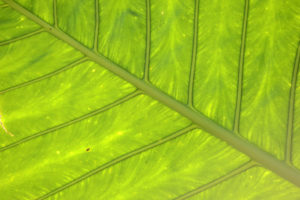 Close-up of the leaf nerves, Cuc Phuong National Park, Vietnam. (Photo copyright © by Kaj Halberg)
Close-up of the leaf nerves, Cuc Phuong National Park, Vietnam. (Photo copyright © by Kaj Halberg)
Design on a withering leaf of a close relative, Alocasia odora, Jiali Shan, Lion’s Head National Scenic Area, northern Taiwan. (Photo copyright © by Kaj Halberg)
Wet rainforest leaf, seen from below, Sepilok, Sabah, Borneo. (Photo copyright © by Kaj Halberg)
The parasol-leaf tree (Macaranga tanarius), also called heart leaf or nasturtium tree, belongs to the spurge family (Euphorbiaceae). It is native to eastern China, Taiwan, Southeast Asia, Indonesia, the Philippines, New Guinea, and eastern Australia.
The nerves on these leaves of the parasol-leaf tree create beautiful patterns against the light. These pictures are from Taiwan, where this species is very common. (Photos copyright © by Kaj Halberg)
Dipterocarpus alatus is a large evergreen forest tree, which can grow to a height of 40 m, sometimes up to 55 m. It is found in tropical Asia, from Bangladesh eastwards through Southeast Asia to the Philippines. It is one of the most important timber species in this region, and wild populations are highly threatened by habitat loss. It is listed as Endangered in the IUCN Red List of Threatened Species.
The generic name is derived from the Greek words di (‘two’), pteron (‘wing’), and karpos (‘fruit’). The fruits of this genus have two large wings, an adaptation to wind dispersal. A picture, depicting a fruit, is shown on the page Plants: Ancient and huge trees.
These leaves of Dipterocarpus alatus have fallen among ruins in Angkor Thom, Cambodia. Micro-organisms have eaten most of the leaf in the lower picture. (Photos copyright © by Kaj Halberg)
Turkish warty-cabbage (Bunias orientalis) is a member of the cabbage family (Brassicaceae), named after its warty siliques (fruits). This species is probably native to the Caucasus, central and southern Russia, western Siberia, and south-eastern Europe, north to Slovakia and Hungary. Today, however, it is very widespread in Asia, Europe, and North America, in some places regarded as an invasive.
On the island of Bornholm, Denmark, Turkish warty-cabbage is a common escape, here photographed north of the town of Gudhjem. (Photos copyright © by Kaj Halberg)
The genus Coccoloba, comprising between 120 and 150 species of shrubs, trees, and lianas, belong to the knotweed family (Polygonaceae). Members occur from Florida southwards through the Caribbean to tropical areas of Central and South America.
C. uvifera is native to coastal areas of Tropical America, the Caribbean, Florida, the Bahamas, and Bermuda. A popular name of this plant is seagrape, alluding to its grape-like clusters of green fruits, each to 2 cm across.
Underside of a leaf of Coccoloba uvifera with numerous galls, Tortuguero, Limón, Costa Rica. (Photo copyright © by Kaj Halberg)
Multi-coloured leaf of a member of the arum family (Araceae), Parque Nacional de Cahuita, Limón, Costa Rica. (Photo copyright © by Kaj Halberg)
The rice-paper plant (Tetrapanax papyrifer), of the ivy family (Araliaceae), is endemic to Taiwan, but is widely cultivated in East Asia for production of the so-called rice paper, for usage in traditional Chinese medicine, and as an ornamental. It is a large shrub, growing to 7 m tall, its large leaves measuring up to 50 cm across.
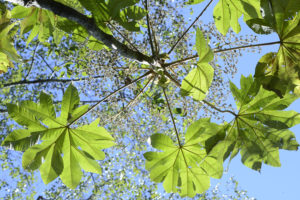 Rice-paper plant, seen from below, Wushe, central Taiwan. (Photo copyright © by Kaj Halberg)
Rice-paper plant, seen from below, Wushe, central Taiwan. (Photo copyright © by Kaj Halberg)
The broad-ribbed limpet (Patelloida saccharina) is a species of sea snail of the family Lottiidae. In China, it is known as chicken-footed limpet, due to the characteristic pattern on the shell. It is attached to exposed coastal rocks, found from India and Sri Lanka eastwards to the western Pacific, from Japan southwards via Melanesia to southern Queensland.
Broad-ribbed limpet, attached to a coastal rock at Jialeshuei, Kenting National Park, Taiwan. (Photo copyright © by Kaj Halberg)
Gullies, eroded by rainwater, often form beautiful patterns.
Eroded gullies, Death Valley, California. (Photo copyright © by Kaj Halberg)
Over the years, these gullies at the foot of the mountain Fornastaðafjall, near Akureyri, Iceland, have been clad in forest of arctic downy birch (Betula pubescens var. pumila). (Photo copyright © by Kaj Halberg)
Mustang is a very dry area in central Nepal, which, however, receives enough precipitation to create gullies, such as these, encountered in a bluff along the Jhong Khola River. (Photo copyright © by Kaj Halberg)
Eroded gullies east of Fès, Morocco. (Photo copyright © by Kaj Halberg)
Erosion from rainwater has cut deep gullies into this slope near Çankiri, north of Ankara, Turkey. (Photo copyright © by Kaj Halberg)
Eroded mountain slope and grazing horses, near the reservoir Embalse El Yeso (2560 m), Andes, central Chile. (Photo copyright © by Kaj Halberg)
Near Hinju, Markha Valley, Ladakh, northern India, snow-melt has created this rhombic-shaped gully. (Photo copyright © by Kaj Halberg)
Gullies in eroded mountains, Sarchu, Ladakh. (Photo copyright © by Kaj Halberg)
Gullies in eroded sedimentary rocks, Badlands National Park, South Dakota, United States. (Photo copyright © by Kaj Halberg)
These patterns on a sandy beach at Vangså, Thy, Denmark, have been created by waves, parting larger, darker sand grains from smaller, lighter ones. (Photo copyright © by Kaj Halberg)
Young fern leaves, which are still not unfolded, are often very beautiful. Their rolled-up shape has been likened to the scroll, or head, of a fiddle, or violin, hence the popular name fiddleheads. Below, a selection of pictures show such ‘fiddleheads’ from around the world.
The common male fern (Dryopteris filix-mas) is widely distributed in temperate areas in the Northern Hemisphere.
As far back as the time of Greek scholar and botanist Theophrastos (c. 371 – c. 287 B.C.), and physician, pharmacologist, and botanist Pedanius Dioscorides (died 90 A.D.), who was the author of De Materia Medica (five volumes dealing with herbal medicine), it was known that the rhizome of this species would expel intestinal worms.
English Medieval herbalist John Gerard (c. 1545-1612) writes: “The roots of the male fern, being taken in the weight of half an ounce, driveth forth long flat worms, as Dioscorides writeth, being drunke in mede or honied water, and more effectually if it be given with two scruples, or two third parts of a dram of scammonie, or of black hellebore: they that will use it, must first eat garlicke.”
Nowadays, herbalists do not recommend the rhizome of common male fern, as it is very poisonous.
‘Fiddleheads’ of common male fern, Jutland, Denmark. (Photo copyright © by Kaj Halberg)
The habitat of the cinnamon fern (Osmundastrum cinnamomeum) is moist woodlands and swamps. This spectacular fern is widely distributed, found in the eastern half of North America, Mexico, Central America, the Caribbean, and South America, southwards to Paraguay. It also occurs in eastern Asia, from south-eastern Siberia southwards through Japan, Korea, eastern China, and Taiwan to the northern part of Indochina.
‘Fiddleheads’ of cinnamon fern, Shu Swamp, Long Island, United States. In the background leaves of eastern skunk cabbage (Symplocarpus foetidus). (Photos copyright © by Kaj Halberg)
Cleared areas in the Himalaya, which lie fallow, are often invaded by large growths of a huge species of fern, Diplopterygium giganteum (formerly Gleichenia gigantea), which belongs to the family Gleicheniaceae, a group often called forked ferns. This species is distributed from Nepal eastwards to China and Southeast Asia.
‘Fiddleheads’ of Diplopterygium giganteum, Annapurna, central Nepal. (Photo copyright © by Kaj Halberg)
Dicranopteris taiwanensis is a species of forked fern, which grows in forests of Taiwan, Malaysia, Indonesia, India, and Sri Lanka.
‘Fiddleheads’ of Dicranopteris taiwanensis, Lugu, Taiwan. (Photos copyright © by Kaj Halberg)
‘Fiddleheads’, Cordillera de Tilarán, Costa Rica. (Photo copyright © by Kaj Halberg)
‘Fiddleheads’, Great Himalayan National Park, Himachal Pradesh, India. (Photo copyright © by Kaj Halberg)
‘Fiddleheads’, Dasyueshan National Forest, Taiwan. (Photo copyright © by Kaj Halberg)
Grown ferns may also often create beautiful patterns.
Leaves of a tree fern, seen from below, Bedugul Botanical Garden, Bali, Indonesia. (Photo copyright © by Kaj Halberg)
The underside of leaves of western sword fern (Polystichum munitum) with sporangies, North Umpqua River, Umpqua National Forest, Oregon (top), and Fern Canyon, Van Damme State Park, California. (Photos copyright © by Kaj Halberg)
Fern leaf, Dasyueshan National Forest, central Taiwan. (Photo copyright © by Kaj Halberg)
Common male fern (Dryopteris filix-mas), central Jutland, Denmark. This species is described above. (Photo copyright © by Kaj Halberg)
Fern leaf, Santa Elena Cloud Forest, Cordillera de Tilarán, Costa Rica. (Photo copyright © by Kaj Halberg)
The underside of a fern leaf with sporangia, Malabang National Forest, Hsinshu, Taiwan. (Photo copyright © by Kaj Halberg)
Winter leaves of bracken (Pteridium aquilinum), Caldera Marteles, Gran Canaria. This species is described on the page Nature: Invasive species. (Photo copyright © by Kaj Halberg)
These moss cushions form a distinctive pattern around leaf scars on the trunk of a tree fern, Trounson Kauri Park, New Zealand. (Photo copyright © by Kaj Halberg)
An epiphytic fern, growing on a slender tree trunk in a rainforest, is illuminated by a patch of sunshine, Sepilok, Sabah, Borneo. (Photo copyright © by Kaj Halberg)
Most members of the hard-fern genus, Blechnum, have rather short and rather stiff leaflets, but, as its name implies, the leaves of the palm-leaf fern (Blechnum novae-zelandiae) are larger, up to 2 m long and 50 cm wide, somewhat resembling palm leaves. This species, which is very common in New Zealand, may also be identified by its sporangies, forming at the tip of the leaves, which turn black when ripe.
Detail of a leaf of palm-leaf fern, Rotokura Lake, New Zealand. (Photos copyright © by Kaj Halberg)
Young leaflet of a fern, unfolding, Parque Nacional Volcán Poás, Cordillera Central, Costa Rica. (Photo copyright © by Kaj Halberg)
Shadows of serrated leaflets on this fern create zigzag patterns on other leaflets, El Yunque, Puerto Rico. (Photo copyright © by Kaj Halberg)
This climber grows out of a hole in the wall along a drainage canal, Taichung, Taiwan. The wind has been moving the plant back and forth, hereby scraping dirt off the wall in concentric circles. (Photo copyright © by Kaj Halberg)
Snow-bordered trail, leading up through a lava field on the slopes of Etna, Sicily. (Photo copyright © by Kaj Halberg)
Dandelion (Taraxacum officinale), also known by about a hundred other names, including lion’s tooth, cankerwort, milk-witch, Irish daisy, monks-head, priest’s-crown, blowball, puff-ball, face-clock, pee-a-bed, wet-a-bed, and swine’s snout, is native to the Northern Hemisphere, but has been introduced to most other parts of the world, where it has often become naturalized.
This species is described in depth on the page Plants: Plants in folklore and poetry.
Leaf rosette of a dandelion, Funen, Denmark. (Photo copyright © by Kaj Halberg)
On sandy beaches in tropical and subtropical areas you often come across patterns, consisting of tiny sand balls, which have been brought up and deposited by small crabs after each tide, which flushes sand into their dens. The pictures below show such patterns.
Cibu Wetlands, southern Taiwan. Patterns of ribs, created by waves, and washed-up foam, are also seen. (Photos copyright © by Kaj Halberg)
Sipitang, Sabah, Borneo. (Photo copyright © by Kaj Halberg)
Near Tongxiao, western Taiwan. (Photos copyright © by Kaj Halberg)
On the islet Pulau Gaya, Sabah, Borneo. (Photo copyright © by Kaj Halberg)
Alexanders (Smyrnium olusatrum) is a stout umbellifer of the Mediterranean region, growing to about 1.8 m tall. In former days, it was much utilized as a pot herb, but has now largely gone out of use. The leaves are large, with rounded leaflets and a large, fleshy, boat-shaped leaf-stalk, yellowish with purple stripes.
The generic name is derived from the Greek smyrna (‘myrrh’) and ion, a diminutive suffix, stemming from the scent of the plant’s juice. The specific name is derived from the classical Roman name of the plant, olus ater (‘black herb’), referring to the colour of the seeds. The English name is a corruption of the Roman name, dating back to the Middle Ages.
The fleshy, purple-striped leaf-stalk of alexanders, Parco delle Madonie, Sicily. (Photo copyright © by Kaj Halberg)
The hollow bolete (Suillus cavipes) may be identified by its hollow lower stem, and also by the pattern created by the pores, not unlike the spokes on a bicycle wheel. It is widely distributed, found in temperate areas of Eurasia and North America.
The generic name is derived from the Latin sus (‘pig’), thus ‘pig-like’, according to some sources alluding to the greasy caps of most species of the genus. I find this allusion strange, as pigs are not greasy, unless they have been rolling in mud. The specific name is from the Latin cavus (‘hollow’, ‘hole’), originally from Proto-Indo-European kowos (‘hollow’).
Pores on a hollow bolete, Nørlund Plantation, Jutland, Denmark. (Photo copyright © by Kaj Halberg)
In Norse religion, yellow bedstraw (Galium verum) was dedicated to Frigg, goddess of knowledge, love, and marriage, who was also protector of women giving birth. It was a custom to line the childbed with this fragrant herb. When Christianity was introduced, this heathen habit was banned, but as it persisted, the Church decided to dedicate yellow bedstraw to Virgin Mary instead, claiming that this herb was lining the crib of the newborn Jesus, hence the folk name of the species, Our Lady’s bedstraw.
Yellow bedstraw is described in depth on the page Plants: Plants in folklore and poetry.
At the edge of a gravel road in Småland, Sweden, the wind has been moving this yellow bedstraw back and forth, hereby creating a pattern of concentric circles in the sand. (Photo copyright © by Kaj Halberg)
Rainforest tree with buttresses, Corcovado National Park, Peninsula de Osa, Costa Rica. This interesting area is presented on the page Travel episodes – Costa Rica 2012: Coastal hike to Corcovado. (Photo copyright © by Kaj Halberg)
The aardwolf (Proteles cristata) is a small relative of the hyaenas. It is fairly common in eastern and southern Africa, but is rarely seen due to its nocturnal habits. The name aardwolf is Afrikaans (the language spoken by immigrating Dutch Boers to South Africa), meaning ‘earth wolf’, relating to the fact that it lives in underground burrows.
Back pattern of an aardwolf, killed by a car, South Africa. (Photo copyright © by Kaj Halberg)
As trees age, beautiful patterns are often created by the texture of the bark. Lichens, growing on the bark, also often create decorative patterns.
Bark of an unidentified tree with lichens, Sanyi, Taiwan. (Photo copyright © by Kaj Halberg)
The flamboyant tree (Delonix regia), also called flame tree, is a huge tree of the pea family (Fabaceae), named for its gorgeous flowers. It is native to Madagascar, but is cultivated as an ornamental in almost all warmer countries.
A picture, depicting its huge, flat pods, which can grow to 60 cm long and 5 cm wide, may be seen on the page Plants: Ancient and huge trees.
Bark pattern of a flamboyant tree. This species is widely planted in Taiwan, where this picture was taken. (Photo copyright © by Kaj Halberg)
Crepe-myrtles (Lagerstroemia), comprising about 50 species of trees and shrubs, are native from the Indian Subcontinent eastwards to China, Taiwan, and Japan, and thence southwards through Indochina, Indonesia, the Philippines, and New Guinea to northern Australia, and some islands in the Pacific Ocean. Due to their beautiful flowers, many species are cultivated in numerous warmer areas.
The generic name was applied by Swedish naturalist Carl Linnaeus (1707-1778) in honour of a Swedish merchant, Magnus von Lagerström (1696-1759), who was director of the Swedish East India Company. Lagerström was a keen naturalist, and despite never visiting Asia, he was able to procure many specimens from India and China, which he presented to Linnaeus. (Source: E. Bretschneider 1898. History of European Botanical Discoveries in China)
The Chinese crepe-myrtle (Lagerstroemia subcostata) is a smallish tree, to 14 m tall, with a characteristic smooth, pale or multi-coloured bark. It is native to Japan, Taiwan, China, and the Philippines, growing in forests and along streams, from low to medium elevations.
Multi-coloured bark on a Chinese crepe-myrtle, Sheding Nature Park, Kenting National Park, Taiwan. (Photo copyright © by Kaj Halberg)
Alligator juniper (Juniperus deppeana), also known as checkerbark juniper, has very distinctive bark, which cracks into small, square plates, thus resembling alligator skin. It is native from Arizona, New Mexico, and western Texas southwards through Mexico to Oaxaca, growing at altitudes between 750 and 2,700 m.
The distinctive bark of alligator juniper, Chiricahua National Monument, Arizona.
The sycamore maple (Acer pseudoplatanus) is a native of Central Europe. It was introduced to Britain around 1500, and has also become naturalized in other parts of Europe, and in Australia, New Zealand, and North America. In many places, it has become invasive, easily spreading by its winged seeds, which are produced in the tens of thousands on a single large tree. An example of this invasiveness is described on the page Nature Reserve Vorsø: Expanding wilderness.
Bark on an old sycamore maple, Funen, Denmark. (Photo copyright © by Kaj Halberg)
Peeling bark creates patterns on a sycamore maple, Hareskoven, Zealand, Denmark. (Photo copyright © by Kaj Halberg)
Concentric circles in the bark of a sycamore maple, presumably formed around a knot, Funen, Denmark. (Photo copyright © by Kaj Halberg)
Paperbark maple (Acer griseum), also known as blood-bark marple, is a small tree, to 9 m tall, characterized by its flaking, often reddish bark. It is native to montane areas of central China, growing at altitudes between 1,500 and 2,000 m.
Bark of paperbark maple, Edinburgh Botanical Garden, Scotland. (Photo copyright © by Kaj Halberg)
Pattern on a tree trunk, Shyabru, Langtang National Park, Nepal. (Photo copyright © by Kaj Halberg)
Canary Islands pine (Pinus canariensis) is described on the page Plants: Ancient and huge trees.
Canary Islands pine, Plateau Presa de las Niñas, Gran Canaria. (Photo copyright © by Kaj Halberg)
Aloidendron is a genus with 7 species of succulent shrubs and trees in the asphodel family (Asphodelaceae), distributed in arid areas of southern Africa, Somalia, and the Arabian Peninsula. These plants were formerly included in the huge genus Aloe, but, following genetic studies, they were moved to a separate genus in 2013.
The quiver tree (Aloidendron dichotomum, previously Aloe dichotoma), which grows to 6 m tall, is native to southern Namibia and the northern part of the Cape region of South Africa. It is also known as kokerboom, Afrikaans for ’quiver tree’. Boers who settled in the area noticed that the San people used the bark of this tree to make quivers for their hunting arrows.
Bark of the quiver tree is unique. – Keetmanshoop, Namibia. (Photo copyright © by Kaj Halberg)
Paper mulberry (Broussonetia papyrifera) is described in depth on the pages Natur: Invasive species, and Plants: Urban plant life.
Pattern in the bark of a young paper mulberry, Taichung, Taiwan. (Photo copyright © by Kaj Halberg)
The rainbow eucalyptus (Eucalyptus deglupta) is characterized by its multi-coloured bark. It is the only species of eucalyptus growing in rainforests, native to the Philippines, Indonesia, and New Guinea, but widely cultivated elsewhere in tropical areas. It is one of the 4 eucalyptus species, out of more than 700, that do not occur in Australia.
Peeling bark of rainbow eucalyptus, Cordillera de Tilarán, Costa Rica. (Photos copyright © by Kaj Halberg)
Common, or European, ash (Fraxinus excelsior), of the olive family (Oleaceae), is a native of Europe, eastwards to the Caucasus and the Alborz Mountains in northern Iran. It has also become naturalized a few places in New Zealand, the United States, and Canada.
In later years, populations of ash have been much reduced by ash dieback, a disease caused by a fungus, Hymenoscyphus fraxineus, previously called Chalara fraxinea. Most trees that contract this disease die after a few years. However, research has shown that some trees have resistance to it.
Patterns in the bark of an old ash, nature reserve Vorsø, Horsens Fjord, Denmark. A twig of cherry plum (Prunus cerasifera) is seen to the right. (Photo copyright © by Kaj Halberg)
The bark on this old ash has fallen off, revealing tunnels in the wood, made by the ash bark-beetle (Hylesinus fraxini). From the female’s egg-laying tunnel, the feeding tunnels of the larvae spread out like a fan. – Öland, Sweden. (Photo copyright © by Kaj Halberg)
The native area of the wild cherry (Prunus avium) was probably from France across central Europe to the Caucasus. At an early stage, however, it was cultivated throughout northern Europe, at least since the Viking Age, and today it is widely naturalized.
This species is described in depth on the page Plants: Plants in folklore and poetry.
Narrow cork stripes create patterns on the bark of a wild cherry, eastern Jutland, Denmark. (Photo copyright © by Kaj Halberg)
Horizontal cork stripes as well as vertical cracks are present on yhis old wild cherry, eastern Jutland, Denmark. (Photo copyright © by Kaj Halberg)
Fallen petals of wild cherry, eastern Funen, Denmark. (Photo copyright © by Kaj Halberg)
Cherry plum (Prunus cerasifera), also known as myrobalan plum, is a close relative of the cherry. This small tree, sometimes reaching a height of 12 m, is a native of south-eastern Europe and western Asia. Due to its edible fruits, which taste somewhat like plums, it was introduced to most parts of Europe and North America at an early stage, and has become widely naturalized there.
The fruits occur in a wide variety of colours: yellow, pink, and numerous shades of red and purple, often produced abundantly. If they are not picked by people, they remain on the tree, until they are over-ripe and fall to the ground. Wild birds are not at all able to eat all these berries, which often lie almost in layers on the ground beneath the tree. Rotting cherry plums are much praised by butterflies and wasps. Pictures, depicting the fruits, are shown on the page Autumn.
The specific name is derived from Ancient Greek kerasos (‘cherry’), and the Latin ferus (‘wild’).
Patterns on the trunk of an ancient, gnarled cherry plum, central Jutland, Denmark. (Photo copyright © by Kaj Halberg)
Patterns in the stump of a logged cherry plum, Nature Reserve Vorsø, Horsens Fjord, Denmark. (Photo copyright © by Kaj Halberg)
Despite its name, the Taiwanese cherry (Prunus campanulata) is also found in Japan, southern and eastern China, and Vietnam. It is a small tree, growing to 8 m tall. Due to its gorgeous bell-shaped flowers, this species is widely cultivated. When flowering, its nectar is a very popular food source for many bird species. On the page Animals – Birds: Birds in Taiwan, numerous pictures depict birds feeding in these flowers.
Patterns in the bark of a young Taiwanese cherry, Basianshan National Forest, Taiwan. The pink colour in the background stems from flowers of this species. (Photo copyright © by Kaj Halberg)
The paperbark corkwood tree (Commiphora marlothii) is a small tree, to 9 m tall, native to rocky areas of central southern Africa, from southern Zaire southwards through Zambia, Zimbabwe, and Botswana to northern South Africa. It is characterized by the bark, which peels off in yellowish, paper-like strips, exposing a green layer beneath. In the past, the bark of this tree was used by natives as writing paper.
The bark of the paperbark corkwood tree is highly distinctive, here photographed in Matobo National Park, Zimbabwe. (Photo copyright © by Kaj Halberg)
Persian lilac, or Chinaberry (Melia azedarach), is probably native to Iran and the Indian Subcontinent. However, due to its beautiful flowers and fruits, it is widely planted elsewhere. It readily becomes naturalized and is now regarded as an invasive in several regions, including North America, East Africa, some Pacific Islands, New Zealand, and Australia.
The bark of old Persian lilac trees often forms cross-like patterns, like on this one in Taitung Ecological Park, Taiwan. (Photo copyright © by Kaj Halberg)
As silver birches (Betula pendula) age, the colour of the bark on the lower part of the trunk changes from almost pure white to blackish. This species is described in depth on the page Plants: Ancient and huge trees.
Patterns in the bark of a younger (top) and an older silver birch, Jutland, Denmark. (Photos copyright © by Kaj Halberg)
The cross-striped bark on this over-turned trunk of a silver birch contrasts greatly with the luminous moss, central Jutland, Denmark. (Photo copyright © by Kaj Halberg)
The kauri tree (Agathis australis), or, to be more precise, the southern kauri tree, is a conifer of the family Araucariaceae, which is restricted to the northernmost part of New Zealand’s North Island. This species is among the world’s largest trees, growing to over 50 m tall, with trunk girths up to 16 m. Although their age is difficult to estimate, it is believed that they may live for more than 2,000 years. They are out of an ancient group of trees, which first appeared during the Jurassic period (190 to 135 million years ago).
The sad fate of the kauri is described on the page Plants: Ancient and huge trees.
Bark of a kauri, Trounson Kauri Park, New Zealand. (Photo copyright © by Kaj Halberg)
The yellow-poplar (Liriodendron tulipifera), also called tulip tree, whitewood, or fiddle-tree, belongs to the magnolia family (Magnoliaceae). It is one of the largest eastern American trees, sometimes reaching a height of 58 m, with a trunk diameter up to 3 m. It is distributed from southern Ontario and Vermont southwards to northern Florida, westwards to Illinois, Missouri, Arkansas, and Louisiana. This popular tree is the state tree of Indiana, Kentucky, and Tennessee.
The generic name, derived from Ancient Greek leirion (‘lily’) and dendron (‘tree’), the specific name, derived from tulip and the Latin fer (‘bearing’), as well as the common name tulip tree, all refer to the large flowers, which superficially resemble lilies or tulips. The popular name fiddle-tree refers to the peculiar shape of the leaves, which sometimes resemble small violins.
The characteristic furrowed bark of yellow-poplar often creates beautiful patterns. – Caumsett State Park, Long Island, United States. (Photo copyright © by Kaj Halberg)
Shadows from leaves of an American beech (Fagus grandifolia) are cast on the trunk of a yellow-poplar, Long Island. (Photo copyright © by Kaj Halberg)
Japanese zelkova (Zelkova serrata), of the elm family (Ulmaceae), is distributed in Japan, Korea, eastern China, and Taiwan. Leaves of the variety tarokoensis in Taiwan are smaller than in the nominate subspecies, and the teeth along the margin are also smaller.
Pattern in the bark of a Taiwan zelkova, var. tarokoensis, Malabang National Forest. (Photo copyright © by Kaj Halberg)
The European, or common, hornbeam (Carpinus betulus), of the birch family (Betulaceae), is native to Europe and south-western Asia, from southern Scandinavia southwards to Italy and Greece, and from southern England and France eastwards to Ukraine, Turkey, the Caucasus, and the Alborz Mountains of northern Iran.
A twig of an ivy (Hedera helix) clings to the trunk of a common hornbeam, Møn, Denmark. (Photo copyright © by Kaj Halberg)
Pattern on the underside of fallen bark, Haverhill, Massachusetts, United States. (Photo copyright © by Kaj Halberg)
Colourful bug, Reserva Nacional Hacienda Baru, Costa Rica. Other true bugs are presented on the page In praise of the colour red. (Photo copyright © by Kaj Halberg)
Rushing water from sudden outbursts of rainfall has created a complicated pattern in the river bed of the Kali Gandaki River, near Larjung, Annapurna, Nepal. (Photo copyright © by Kaj Halberg)
Diploderma is a large genus of lizards in the family Agamidae, comprising about 46 species, which were previously included in the genus Japalura. They are native from Indochina eastwards across China to Taiwan and Japan, with the greatest diversity in China.
These animals are often perched on trees, especially in patches of sunlight. They feed on arthropods and other small invertebrates.
Swinhoe’s japalure (Diploderma swinhonis), also known as Taiwan japalure, is native to Taiwan. It is quite common, living in forests, shrubberies, and city parks. It was named in honour of British biologist Robert Swinhoe (1836-1877) who, in 1860, became the first European consular representative to Taiwan. He discovered many new animal species, and 4 mammals and 15 birds are named after him.
Swinhoe’s japalure males have a conspicuous pattern on their dewlap. – Chingshuian Recreation Area, Taiwan. (Photos copyright © by Kaj Halberg)
The short-legged japalure (Diploderma brevipes) is another japalure endemic to Taiwan, living in forests at elevations between 1,100 and 2,200 m. It grows to 25 cm long, of which the tail constitures about 15 cm. Males are strikingly patterned, with a yellowish or green back with large, dark brown patches, whereas the female is mainly green.
Male short-legged japalure, Malabang National Forest, Hsinshu, Taiwan. (Photos copyright © by Kaj Halberg)
Popular names of the genus Heliconia include lobster-claw, toucan beak, wild plantain, and false bird-of-paradise. Formerly, this genus, comprising about 200 species, was included in the banana family (Musaceae), but is now forming a separate family, Heliconiaceae. These plants are found mainly in Central and South America, with a few species on some Pacific Islands and in Indonesia.
Inflorescence of Heliconia wagneriana, Cahuita, Limón, Costa Rica. The native range of this species is from Chiapas, Mexico, southwards to Ecuador. (Photo copyright © by Kaj Halberg)
Even though you can hardly call fields nature, a few weeds always take root, a mole and a mouse or two may also live here, and an occasional deer or hare may be roaming. Under all circumstances, even modern large-scale fields hold a peculiar beauty in their broad outline, or in the patterns created by the harvesting of the crops.
The northern part of the island Luzon, Philippines, is inhabited by tribal peoples of Malayan origin. At least 2,000 years ago, they constructed fantastic terraced fields, irrigated through an advanced system of canals. On these terraces, they grow their main staple, rice, supplied with sweet potatoes, taro, and various vegetables.
Terraced fields, Banawe, Luzon, Philippines. Bundles of rice seedlings are placed in the fields, ready to be planted. (Photos copyright © by Kaj Halberg)
Paddy fields with newly planted rice plants, near Longluan Lake, southern Taiwan (upper two pictures), and near Taichung, Taiwan. The bird in the centre picture is a cattle egret (Bubulcus ibis). (Photos copyright © by Kaj Halberg)
Terraced fields, lying fallow, near Chowki, eastern Nepal (top), and near Pokhara, central Nepal. (Photos copyright © by Kaj Halberg)
Terraced fields, some lying fallow, others with yellow-flowered leaf mustard (Brassica juncea), Pharping, Kathmandu Valley, Nepal. This species is presented on the page In praise of the colour yellow. (Photo copyright © by Kaj Halberg)
Terraced fields, enclosed by stone walls, Dingboche, Khumbu, eastern Nepal. (Photo copyright © by Kaj Halberg)
Terraced fields, some lying fallow, Ilam, eastern Nepal. One field has been inundated to plant rice, and others are covered in leaf mustard. (Photo copyright © by Kaj Halberg)
Terraced fields with newly planted rice, near Lake Begnas Tal, Nepal. (Photo copyright © by Kaj Halberg)
Harvested fields, Funen, Denmark. (Photos copyright © by Kaj Halberg)
Onion fields on the lower slopes of Gunung Bromo Volcano, Java, Indonesia. (Photo copyright © by Kaj Halberg)
Rows of cultivated dog roses (Rosa canina) on a hill, Funen, Denmark. The picture was taken with a 600 mm tele lens, causing the hill to look steeper than it is. (Photo copyright © by Kaj Halberg)
Harvested paddy field, Taichung, Taiwan. Some of the plants have sprouted anew. (Photos copyright © by Kaj Halberg)
Stubble of harvested maize create a pattern, which merges into a pattern of trunks in a spruce plantation, Jutland, Denmark. (Photo copyright © by Kaj Halberg)
Newly sprouted winter crop, eastern Funen, Denmark. (Photo copyright © by Kaj Halberg)
Paddy fields, viewed from the hill Phnom Krom, near Siem Reap, Cambodia. In the lower picture, impressions from ox-cart wheels create patterns. (Photos copyright © by Kaj Halberg)
Seemingly endless rows of cultivated currant bushes (Ribes nigrum), Funen, Denmark. (Photo copyright © by Kaj Halberg)
Irregular patterns in rows of densely cut tea bushes (Camellia sinensis), near Alishan, Taiwan. – The origin of tea brewing is described on the page Plants: Plants in folklore and poetry. (Photos copyright © by Kaj Halberg)
Tractor tracks in a grass field, eastern Funen, Denmark. (Photo copyright © by Kaj Halberg)
Newly sprouted corn, north of Aarhus, Denmark. (Photo copyright © by Kaj Halberg)
Field of cereals with tracks from spraying, Djursland, Denmark. (Photo copyright © by Kaj Halberg)
Early in the morning, a patch of sunshine illuminates people, harvesting rice on terraced fields in the Trisuli Valley, central Nepal. (Photo copyright © by Kaj Halberg)
Farmers, picking weeds in a wheat field, Sissu, Lahaul, Himachal Pradesh, India. (Photo copyright © by Kaj Halberg)
As far back as Ancient Egypt, papyrus (Cyperus papyrus), of the sedge family (Cyperaceae), has been utilized by humans for production of paper – one of the first types of paper to be made. The stems were tied together to make reed boats – a production which still takes place several places on the planet (see page Culture: Boats). Mats, baskets, hats, fish traps, trays, and rope are also produced from them, and parts of the plant are edible.
The natural habitats of papyrus are swamps and lake margins, from Egypt southwards through the entire eastern Africa to South Africa, in some areas in western Africa, on Madagascar, and in Jordan and Israel.
Papyrus, Bangweulu Swamps, northern Zambia. (Photos copyright © by Kaj Halberg)
Patterns on a nest of a species of giant hornet, Vespa, hanging down from a branch, Wufong, Taiwan. (Photo copyright © by Kaj Halberg)
Beeches (Fagus), comprising 10 to 13 species of trees, are native to temperate and subtropical areas of Europe, Asia, and North America.
The European beech (Fagus sylvatica) is largely restricted to Europe, occurring from England and the Pyrenees eastwards to Poland and Ukraine, and from southern Sweden southwards to Italy and the Balkans, with a patchy occurrence in southern Norway, central Spain, and Turkey. In the Balkans, it hybridizes with the oriental beech (Fagus orientalis), which is found in Bulgaria, Greece, Turkey, the Caucasus, and the Alborz Mountains in northern Iran.
Other pictures, depicting European beech, may be seen on the pages Plants: Ancient and huge trees, and Autumn.
Trunks of young beech trees cast shadows, which form patterns on the forest floor, Jutland, Denmark. (Photo copyright © by Kaj Halberg)
Beech logs, lined up along a forest road, Funen, Denmark. (Photo copyright © by Kaj Halberg)
The colourful Luna moth (Actias luna), of the family Saturniidae, is found in North America, distributed from Saskatchewan eastwards to Nova Scotia, and in the eastern half of the United States, southwards to Florida. It has been observed a few times in western Europe.
The specific name was applied by Swedish naturalist Carl Linnaeus (1707-78), referring to Luna, the Roman moon goddess.
Fern-like antennae of a luna moth, Pawtuckaway State Park, New Hampshire. (Photo copyright © by Kaj Halberg)
Patterns in algae, growing in a polluted stream, Taichung, Taiwan. (Photo copyright © by Kaj Halberg)
Foam, creating patterns on the surface of polluted streams, near Trounson Kauri Park, New Zealand (top), and Suei Wei River, Taichung, Taiwan. (Photos copyright © by Kaj Halberg)
Flower-like pattern on the skeleton of a washed-up sea urchin, popularly known as a ‘sand dollar’ due to its coin-like shape. – Yeliou Geopark, northern Taiwan. (Photo copyright © by Kaj Halberg)
Stevns Klint, eastern Zealand, Denmark, is a white limestone cliff, 17 km long and a maximum of 41 m high. This cliff is of great importance due to a 5 to 20 cm thick layer of so-called fiskeler (‘fish clay’), a 65 million-year-old layer on the Cretaceous-Tertiary boundary. This ash layer marks the time, when an enormous meteor impact in Mexico caused widespread disasters across the globe and probably was the cause of mass extinction, including the dinosaurs. The reason that this layer of fiskeler is proof of the meteor impact is that it has a high content of a rare metal, iridium, which occurs in meteors.
Stevns Klint with black layers of flint. (Photos copyright © by Kaj Halberg)
Hvideklint, on the island of Møn, Denmark, is a cliff, consisting of white chalk, with deposits of brown soil above. Rain has caused mud to run down the white chalk, creating a streaked pattern. The deposit of rust to the right indicates the presence of iron ore in the cliff. (Photo copyright © by Kaj Halberg)
The common whitetail (Plathemis lydia), also known as long-tailed skimmer, is a striking dragonfly of the family Libellulidae, which is widespread in North America. The male, to about 5 cm long, has a broad white abdomen and blackish-brown bands on the translucent wings. Females are a bit smaller, with a different wing pattern of brown spots, and a brown abdomen with white zigzag stripes on the sides. Immature males resemble females, but have the wing pattern of adult males.
Immature male common whitetail, Mystery Hill, New Hampshire. (Photo copyright © by Kaj Halberg)
Lesser bulrush (Typha angustifolia) is characterized by its very narrow leaves, to 1.5 cm wide. It is widely distributed in wetlands in temperate and subtropical areas of the Northern Hemisphere.
Moved by the wind, leaves of lesser bulrush create a pattern, Langeland, Funen, Denmark. (Photo copyright © by Kaj Halberg)
The barn owl (Tyto alba) is distributed in Europe, from England and Denmark southwards, and from Ireland and Portugal eastwards to Belarus and Ukraine, in the entire Africa (except certain areas of the Sahara), on Madagascar, and on the Arabian Peninsula. Previously, it was believed that it had an almost global distribution, but the former Asian, Australian, and American subspecies have now been upgraded to a number of separate species.
Pattern on the upper wing of a barn owl, which was killed by a car, France. (Photo copyright © by Kaj Halberg)
The long-eared owl (Asio otus) is a widespread and common owl, breeding in subalpine, temperate and subtropical areas of the Northern Hemisphere, southwards to the Mexican border, northern Africa, Turkey, Afghanistan, northern China, and southern Japan. Northernmost populations are migratory, wintering as far south as central Mexico, Egypt, Pakistan, and southern China.
Primary flight-feathers of a long-eared owl, Nature Reserve Vorsø, Horsens Fjord, Denmark. (Photo copyright © by Kaj Halberg)
Patterns in a sawed trunk, eastern Funen, Denmark. (Photo copyright © by Kaj Halberg)
Large honey bush (Melianthus major), of the family Francoaceae, is an evergreen shrub, which is endemic to South Africa, but has become naturalised elsewhere, including in India, Australia, and New Zealand. All parts of the plants are poisonous. The generic name is from the Greek meli (‘honey’) and anthos (‘flower’). Various birds, including sunbirds of the family Nectariniidae, often feed in the flowers.
Leaves of large honey bush are very distinctive. – Doubtless Bay, Karikari Peninsula, New Zealand. (Photo copyright © by Kaj Halberg)
Reflections of sunlight create patterns in a rocky lake-bed, Lake Femunden, Hedmark, Norway. (Photo copyright © by Kaj Halberg)
Rushes (Juncus) are a huge genus of grass-like plants, comprising about 300 species. They are found throughout the world, with the exception of Antarctica. Historically, these plants received little attention from botanists. In 1819, British botanist James Ebenezer Bicheno (1785-1851), who was colonial secretary of Tasmania from 1842 until his death in 1851, described the genus as “obscure and uninviting”. (Source: J.E. Bicheno 1819. Observations on the Linnean genus Juncus, with the characters of those species, which have been found growing wild in Great Britain. Transactions of the Linnean Society of London 12 (2): 291-337)
Saltmarsh rush (Juncus gerardii) is mainly a coastal species, occurring on coasts of Europe and eastern North America, and also on saline soils inland, in western and central Asia and central North America.
These tufts of saltmarsh rush, which have sprouted between large specimens of sea plantain (Plantago maritima), create patterns in a littoral meadow, Horsens Fjord, Denmark. A littoral pond with vegetation of common cordgrass (Spartina anglica) is seen in the background. The greyish plants are sea wormwood (Artemisia maritima). (Photo copyright © by Kaj Halberg)
The small toad rush (Juncus bufonius) is distributed over most of the world, restricted to humid areas.
In this picture, toad rush grows only in the deepest, most humid grooves of a tractor track, central Jutland, Denmark. (Photo copyright © by Kaj Halberg)
Cracked moss cushion, Harrild Moor, Jutland, Denmark. (Photo copyright © by Kaj Halberg)
Smilax is the sole genus in the catbrier or greenbrier family (Smilacaceae), comprising about 260 species of woody climbers. These plants are distributed across the globe, except in the polar regions, northern Eurasia, Arabia, southern South America, and New Zealand. The fruit is a berry, bright red in most species.
The generic name is the Ancient Greek name of an unknown plant. The common names are derived from Old English brer, the term for thorny bushes.
These plants vary significantly, making them notoriously difficult to distinguish.
Young leaves of a species of catbrier, Yeliou Geopark, Taiwan. (Photo copyright © by Kaj Halberg)
Tree roots, which have been exposed due to rain water erosion, often create beautiful patterns on the forest floor.
Exposed roots on a hiking trail, Gunung Rinjani Volcano, Lombok, Indonesia. (Photo copyright © by Kaj Halberg)
Exposed roots of a huge banyan, or Bengal fig (Ficus benghalensis), Mount Abu, Rajasthan, India. – This species is described on the page Plants: Pipal and banyan – two sacred fig trees. (Photo copyright © by Kaj Halberg)
Exposed roots of a benjamin fig (Ficus benjamina) at the Hindu temple Pura Ulun Danu Bratan, Lake Bratan, Bali, Indonesia. (Photo copyright © by Kaj Halberg)
Exposed roots on a hiking trail in a beech forest near Kranjska Gora, Slovenia. (Photo copyright © by Kaj Halberg)
Exposed roots of a Taiwan red cypress (Chamaecyparis formosana) on a hiking trail, Alishan National Forest, central Taiwan. These magnificent trees are presented on the page Plants: Ancient and giant trees. (Photo copyright © by Kaj Halberg)
Pattern on a mountain slope, created by eroded material, near Kyimshung Glacier, Langtang National Park, Nepal. (Photo copyright © by Kaj Halberg)
Black and purple volcanic sand with various sea shells, including that of a ram’s horn squid (Spirula spirula), Muriwai Beach, New Zealand. (Photos copyright © by Kaj Halberg)
Rivulets create patterns in a river bed, near Pang, Ladakh, India. (Photo copyright © by Kaj Halberg)
At Pamukkale, western Turkey, water, containing dissolved calcium bicarbonate, is seeping down a slope over a wide area, where the mineral is deposited, and, over time, has formed numerous bluish-white terraces, some dry, some containing ponds with shallow water.
Patterns in calcium bicarbonate terraces, Pamukkale. (Photos copyright © by Kaj Halberg)
The genus Agave, comprising about 270 species, is native to warmer areas of the Americas. Some species grow very large, typically forming large rosettes of strong, fleshy leaves, with very sharp spines along the margin. After a number of years, the plant produces a flower stalk, which may be up to 12 m tall in some species.
A. americana, a native of tropical America, is known as ‘the century plant’, as it grows for many years before it blooms, produces seeds, and then dies.
Colourful patterns in a fallen agave leaf, near Vega de Acusa, Gran Canaria. (Photo copyright © by Kaj Halberg)
Pattern on the flower stalk of an agave, Barranco de Guayadeque, Gran Canaria. (Photo copyright © by Kaj Halberg)
As its name implies, the most important food item of the acorn woodpecker (Melanerpes formicivorus) is acorns. It has an interesting habit of storing acorns as a winter supply in small holes, which the bird chisels into the bark of living or dead trees. This bird is common from California through Mexico and Central America to northern Columbia.
This acorn woodpecker has chiseled its nesting hole in the trunk of a palm tree in Santa Rosa Plateau Ecological Reserve, California, and around the nesting hole, it has made numerous small holes for storage of acorns. (Photos copyright © by Kaj Halberg)
A cristate, or crested, saguaro cactus (Carnegiea gigantea) forms, when the cells in the growing stem begin to divide outward, rather than in the circular pattern of a normal cactus. This mutation results in the growth of a large fan-shaped crest at the growing tip of a saguaro’s main stem or ‘arms’.
Several pictures, depicting normal saguaros, as well as pictures of many other cactus species, may be seen on the page Plants: Cacti.
Crested saguaro cactus, Organ Pipe Cactus National Monument, Arizona, United States. (Photo copyright © by Kaj Halberg)
Shambles of branches often form beautiful or complicated patterns.
Pale branches seen against a dark rock wall, Tacijili River, Taroko Gorge, Taiwan. (Photo copyright © by Kaj Halberg)
Fallen branches create patterns in a vernal pool, Parker River Wildlife Refuge, Massachusetts, United States. (Photo copyright © by Kaj Halberg)
As its name implies, the New Zealand fantail (Rhipidura fuliginosa) is restricted to New Zealand, where it is common in many places. This species is very confiding and will often flit about in front of your face, catching insects. It is very variable, being mainly grey, white, and pale brown, and it also occurs in a dark morph, which is sometimes called black fantail.
In the Maori language, the New Zealand fantail is known as piwakawaka. It is a messenger, bringing death or news of death from the gods to the people. Its bulbous eyes and erratic flying behaviour is attributed to it being squeezed by the hero Maui, because it would not reveal the whereabouts of his ancestress Mahuika, the fire deity.
New Zealand fantail among willow branches, Trounson Kauri Park, New Zealand. (Photo copyright © by Kaj Halberg)
Wood horsetail (Equisetum sylvaticum) often resembles a tiny spruce tree. This attractive species is distributed in the northern temperate and arctic zones of Eurasia and North America. The generic name is from the Latin equus (‘horse’), and seta, which has several meanings, including ‘rough’, ‘brush’, or ‘hair’. Seta can refer to the rough, silica-containing stems of these plants, but together with equus, the word means ’horse hair’. With a bit of imagination, a bunch of drying stems do resemble a horsetail. The specific name means ‘growing in forests’, from the Latin silva (‘forest’).
Other species of horsetail are described on the page Plants: Plants in folklore and poetry.
These wood horsetails, growing in a dark forest on the island of Møn, Denmark, are illuminated by a patch of sunshine. (Photo copyright © by Kaj Halberg)
Ripples in water are created by various means, including wind, moving objects like boats, or feeding birds.
Ripples in a pond behind autumn foliage of Norway maple (Acer platanoides), Funen, Denmark. Norway maple is described on the page Plants: Ancient and huge trees. (Photo copyright © by Kaj Halberg)
A friendly boy, collecting edible waterlilies (Nymphaea) in the moat around the ruins of Angkor Wat, Cambodia. (Photo copyright © by Kaj Halberg)
Ripples on a lake surface with growths of common club-rush (Schoenoplectus lacustris) and reed (Phragmites australis), Jutland, Denmark. (Photo copyright © by Kaj Halberg)
Seven subspecies of the Canada goose (Branta canadensis) breed in North America, from Alaska and northern Canada southwards to the northern third of the United States. It has also been introduced to Britain, Sweden, New Zealand, Argentina, and other places. This species is very bold and has been able to establish populations in urban areas, where it has no natural predators. In many areas, it has been declared a pest because of its noise, droppings, and aggressive behaviour.
A slight puff of wind creates ripples in a calm Pacific Ocean, in which a flock of Canada geese are resting. – Coos Bay, Oregon. (Photo copyright © by Kaj Halberg)
Ripples in the Baltic Sea, with a feeding mute swan (Cygnus olor), Eriksberg Stränder Nature Reserve, Blekinge, Sweden. (Photo copyright © by Kaj Halberg)
The aftermath of this ferry, sailing across a huge reservoir near Bilaspur, Himachal Pradesh, India, creates a pretty pattern. (Photo copyright © by Kaj Halberg)
As a breeding bird, the northern shoveler (Spatula clypeata) is widely distributed across the northern hemisphere, avoiding the harshest areas of the Arctic. It is found from Iceland, the British Isles, Spain, and Morocco eastwards across the taiga belt to the Pacific, and also in Alaska and the western part of North America, southwards almost to the Mexican border.
The winter months are spent in the southern half of North America, in Central America and the Caribbean, in the major part of Europe and the Middle East, in northern and eastern Africa, and in the Indian Subcontinent, Southeast Asia, southern China, Korea, Japan, Taiwan, and the northern Philippines.
Male northern shoveler, Aogu Wetlands, Taiwan. (Photo copyright © by Kaj Halberg)
The medium-sized ring-billed gull (Larus delawarensis) has a very wide distribution, breeding across North America, from the northern prairie states of Canada southwards to northern California and the U.S. prairie states, and eastwards to Newfoundland. It winters in the U.S., Mexico, and the Greater and Lesser Antilles.
The specific name refers to the Delaware River, where it was first collected. It was described by American naturalist George Ord (1781-1866), who, incidentally, also described several specimens, brought back by the Lewis and Clark expedition (1804-1806), which is dealt with on the page Animals – Mammals: Squirrels.
This young ring-billed gull has just landed in Mill Neck Creek, Long Island, hereby creating concentric circles on the surface. (Photo copyright © by Kaj Halberg)
The mute swan (Cygnus olor) is presented in depth on the page Animals: Urban animal life.
Mute swan in the moat around Nyborg Castle, Denmark. (Photo copyright © by Kaj Halberg)
The wood sandpiper (Tringa glareola) is a smallish wader, which breeds in marshes of subarctic and northern temperate areas of Europe and Asia, wintering in Africa, South Asia, and Australia.
The generic name Tringa was given to a near relative, the green sandpiper (Tringa ochropus), by Italian naturalist Ulisse Aldrovandi (1522-1599), who was the founder of the botanical garden of Bologna – one of the first of its kind. The name is derived from the Greek trungas, a thrush-sized, tail-bobbing wading bird, mentioned by Greek scientist and philosopher Aristotle (384-322 B.C.). (Source: J.A. Jobling 2010. The Helm Dictionary of Scientific Bird Names)
Feeding in a river in Hwange National Park, Zimbabwe, this wood sandpiper creates concentric circles on the surface. (Photo copyright © by Kaj Halberg)
The little cormorant (Microcarbo niger) is widely distributed, found from the Indian Subcontinent eastwards to Southeast Asia, with an isolated population on the Indonesian island of Java.
This little cormorant has just surfaced and is now swallowing a fish, Lake Haleji Bird Sanctuary, Pakistan. (Photo copyright © by Kaj Halberg)
The American black duck (Anas rubripes) is found in eastern North America, from eastern Manitoba eastwards to New Foundland, southwards to the Great Lakes and New Jersey, and thence along the coast to North Carolina. Northern populations are migratory, wintering from the Great Lakes and south-eastern Canada southwards to Mississippi and northern Florida.
It is a close relative of the widespread mallard (A. platyrhynchos), and the two species often interbreed, which can make identification of pure black ducks difficult.
Feeding American black ducks, creating concentric circles on the surface, Mill Neck Creek, Long Island. (Photo copyright © by Kaj Halberg)
Pattern in snow, created by lava dust, Etna, Sicily. (Photo copyright © by Kaj Halberg)
Beautiful patterns are often created on leaves, which have been partly eaten by insects. A selection is seen below.
Common adenostyles (Adenostyles alliariae), also called hedge-leaved adenostyle, is a composite, native to the major part of southern Europe, from Spain eastwards across the Alps to the Carpathians, the Balkans, and Turkey. It is very common in the Alps, growing at altitudes between 1,300 and 2,400 m, in shrubberies, meadows, and rocky areas.
You often come across a growth of common adenostyles, whose leaves have been almost completely eaten by larvae of a metallic, bluish or greenish beetle, Oreina cacaliae, which belongs to the family broad-shouldered leaf beetles (Chrysomelidae). This species is partial to common adenostyles, as well as alpine butterbur (Petasites paradoxus).
Leaves of common adenostyles, almost completely eaten by larvae of Oreina cacaliae, Grossglockner area, Austria. (Photos copyright © by Kaj Halberg)
Angled castor (Ariadne ariadne) is a butterfly of the brushfoot family (Nymphalidae), distributed from the Indian Subcontinent eastwards to southern China and Taiwan, and thence southwards through Southeast Asia to Indonesia. It lives in disturbed habitats, including roadsides, abandoned fields, and forest glades, where its most common host plant, the castor oil plant (Ricinus communis), is growing. Other host plants include Tragia species, likewise of the spurge family (Euphorbiaceae).
Caterpillars of this butterfly are very spiny indeed, deterring birds from eating them. They may also be poisonous, due to the toxic leaves they eat.
Caterpillars of angled castor have eaten most of a leaf of castor oil plant, leaving only the nerves, Fazi River, Taichung, Taiwan. (Photo copyright © by Kaj Halberg)
Leaves of beach almond (Terminalia catappa), partly eaten by insects, Taiwan. This species is described above. (Photos copyright © by Kaj Halberg)
The sycamore maple is dealt with above.
Leaf of sycamore maple, partly eaten by insects, Nature Reserve Vorsø, Denmark. (Photo copyright © by Kaj Halberg)
Horseradish (Armoracia rusticana) is a member of the cabbage family (Brassicaceae), growing to about 1.5 m tall. It probably originates in south-eastern Europe or western Asia, but is cultivated around the world as a vegetable and a spice. Today, it is often utilized for production of the potent Japanese paste wasabi, although true wasabi is made from the plant Wasabia japonica, likewise a member of the cabbage family.
Leaf of horseradish, partly eaten by insects, Jutland, Denmark. (Photo copyright © by Kaj Halberg)
California black oak (Quercus kelloggii) is mainly a tree of northern California and western Oregon, where it grows in foothills and lower mountains. Its occurrence in southern California and Baja California is patchy, but it is common in the Sierras. Most trees live between 100 and 200 years, but some specimens are known to be almost 500 years old.
This species is adapted to fire, protected from smaller fires by its thick bark. It is killed by larger fires, but easily sprouts again from the roots. Acorns mainly sprout, when a fire has cleared an area of leaf litter. This was known by several indigenous peoples, who purposely lit fires to renew growths of this tree, whose acorns was a staple food source to them.
Feeding tunnels of a species of leaf miner moth create patterns in a leaf of California black oak, Sequoia National Forest, Sierra Nevada, California. (Photo copyright © by Kaj Halberg)
Redflower ragleaf (Crassocephalum crepidioides) is a member of the composite family, growing to about 1.8 m tall. It stems from tropical Africa, but has become naturalized in most tropical and subtropical regions of the world.
Other pictures, depicting this species, are found on the page Plants: Himalayan flora.
Leaf of redflower ragleaf (Crassocephalum crepidioides) with feeding tunnels of a species of leaf miner moth, Tamur Valley, eastern Nepal. (Photo copyright © by Kaj Halberg)
Yet another example of leaf miner moth feeding tunnels, here in a leaf of common honeysuckle (Lonicera periclymenum), Jutland, Denmark. This species is described elsewhere on this page. (Photo copyright © by Kaj Halberg)
Saurauia napaulensis, in Nepali called gogon, is a tree of the family Actinidiaceae, growing to 20 m tall. It is distributed in the Himalaya, from Uttarakhand eastwards to Myanmar, at elevations between 750 and 2,100 m. It also grows in Southeast Asia and western China. In local traditional medicine, the bark is crushed together with Lecanthus peduncularis of the nettle family (Urticaceae), and the juice is taken against fever.
Withered leaf of Saurauia napaulensis, partly eaten by insects, Ghunsa Valley, eastern Nepal. (Photo copyright © by Kaj Halberg)
Leaf of downy birch (Betula pubescens), partly eaten by insects, Mols, Jutland, Denmark. This species is described on the page Plants: Ancient and huge trees. (Photo copyright © by Kaj Halberg)
This leaf of giant taro (Alocasia macrorhiza) has been partly eaten by insects, Wufong, Taiwan. This species is described above. (Photo copyright © by Kaj Halberg)
Deposits of moraine often create beautiful patterns in glaciers.
This iceberg, partly covered in moraine, is stranded in a glacial lake, Jökulsárlon, beneath Vatnajökul Glacier, southern Iceland. (Photo copyright © by Kaj Halberg)
Glacier with patterns, created by deposited moraine, Yrdyk Valley, Kyrgyzstan. (Photo copyright © by Kaj Halberg)
The common stray dogs of Taiwan, sometimes called Takasago dogs, are a result of the indigenous Formosan hunting dogs interbreeding with imported dog types. Taiwan dogs are usually black or brown, or a mixture of the two.
The domestication of the dog is described on the page Animals: Animals as servants of Man.
Hair pattern on the rump of a Taiwan dog. (Photo copyright © by Kaj Halberg)
Spiny plants often form beautiful patterns.
Screw palms (Pandanus) are a genus of monocots with 700-750 species. The name palm refers to their palm-like appearance, whereas the prefix screw alludes to its leaves, which are arranged in a swirly pattern, with old leaf scars encircling the stem. Another name of these plants is screwpine, alluding to the edible fruit, which resembles a pineapple.
The Chinese screw palm (Pandanus tectorius, formerly known as P. odoratissimus var. sinensis), is a small tree, to 10 m tall, distinguished by its numerous spiny leaves, which may grow to 1.8 m long. it is distributed along seashores, from eastern China and Taiwan southwards through Southeast Asia to northern Australia and many Pacific islands. It is sometimes planted as a living fence, and the leaves are used for weaving.
Chinese screw palm, Bitou Cape Trail, northern Taiwan. (Photo copyright © by Kaj Halberg)
Pandanus kirkii, previously called P. platycarpus, is native to coastal areas of eastern Africa, from southern Somalia southwards to Tanzania.
The specific name was given in honour of English physician John Kirk (1832-1922), who was British administrator in Zanzibar. He was also a keen naturalist who collected numerous previously unknown plants and animals on several trips.
Spiralled leaf of Pandanus kirkii, Bwejuu Beach, Zanzibar. (Photo copyright © by Kaj Halberg)
If you have once stepped barefoot on the leaf rosette of a spear thistle, or bull thistle (Cirsium vulgare), you need no further introduction to it, and you will always avoid it in the future. This species, with its intensely spiny leaves, is widely distributed in the major part of Europe, North Africa, and western Asia, eastwards to the Yenisei River. It has also been accidentally introduced to many other places, including North America and Australia, where it is often regarded as an invasive weed.
Spear thistle is biennial. During the first year, it produces a leaf rosette, which overwinters and grows into a stem, up to 1.5 m tall, the following summer, displaying an abundance of beautiful red flowerheads. Despite its formidable armour of spines, this plant has been elected as the national flower of Scotland, hence another common name, Scottish thistle. Other lovers of the spear thistle include honey bees, bumble bees, and butterflies, which feed on the nectar, and various finches, including goldfinch (Carduelis carduelis), linnet (Carduelis cannabina), and greenfinch (Chloris chloris), which greatly appreciate the seeds.
Rime covers an overwintering leaf rosette of spear thistle, Jutland, Denmark. (Photo copyright © by Kaj Halberg)
Agave leaf, still not fully opened, Parque Nacional Rincon de la Vieja, Cordillera de Guanacaste, Costa Rica. The agave genus is presented elsewhere on this page. (Photo copyright © by Kaj Halberg)
Spiny leaves of Shaw’s agave (Agave shawii), Torrey Pines State Beach, California. This species is native to the coasts of south-western California and Baja California. (Photo copyright © by Kaj Halberg)
In areas affected by seasonal frost, repeated freezing and thawing of groundwater forces larger pebbles toward the surface, and smaller pebbles flow and settle underneath larger ones. At the surface, areas that are rich in larger stones contain much less water than the porous areas of finer-grained sediments, which have a much greater ability to expand and contract, as freezing and thawing occur. This will ultimately lead to the larger pebbles piling into clusters, forming polygons, circles, and stripes. (Source: D.J. Easterbrook 1999. Surface processes and landforms. Prentice Hall)
Polygons, created by repeated freezing and thawing, Tso Kar, Ladakh, India. (Photos copyright © by Kaj Halberg)
Bananas are described on a separate page, see Plants: Bananas.
Patterns on a withering banana leaf, Lugu, Taiwan. (Photo copyright © by Kaj Halberg)
Banana leaf, torn by the wind, Taiwan. (Photo copyright © by Kaj Halberg)
Grass stems and cracked concrete create a pattern on the wall along a drainage canal, Taichung, Taiwan. (Photo copyright © by Kaj Halberg)
The buoy barnacle (Dosima fascicularis) is a crustacean, which, like mussles, has two shells. It eats plankton and other small animals, which it sieves from the water, using its hairy legs. As an adult, the buoy barnacle often attaches itself to floatsam, including seaweed, tar pellets, plastic, driftwood, and styrofoam, but it is the only species, which is able to produce its own float by excreting a foamy mass of protein (the whitish lump between the animals on the picture), which becomes stiff, but is lighter than water and carries the animal along on ocean currents. Often several animals are attached to the same lump.
Buoy barnacles, washed up on Vangså Beach, Thy, Denmark. Several animals are attached to the same protein lump, forming a star-shaped pattern. (Photo copyright © by Kaj Halberg)
Pattern on a stone, near Tharepati, Langtang National Park, Nepal. (Photo copyright © by Kaj Halberg)
Sweet chestnut (Castanea sativa) is native to the Mediterranean region, eastwards to the Alborz and Zagros mountains of Iran. This large tree, growing to 35 m tall, may live for 500 or 600 years, and cultivated specimens are reputedly 1000 years old.
Sweet chestnut is widely cultivated for its edible nuts and for its wood. Raw chestnuts are covered by a tough skin, which has an unpleasant, astringent taste. They are usually roasted, which makes it easier to remove the skin. Chestnut orchards are commonly found in Spain, Portugal, France, Switzerland, Italy, Greece, and elsewhere.
During my stay in the Zagros Mountains in south-western Iran (see Travel episodes – Iran 1973: In the mountains of Luristan), I was told that fruits of sweet chestnut, which is common in these mountains, were an important food item, when the wheat crop failed.
In his book Flora Danica, from 1648, Danish physician and herbalist Simon Paulli (1603-1680) says: ”Galenus [Claudius Galenus (130-210 A.D.), Greek-Roman physician and philosopher] praises the fruits of sweet chestnut above all other kinds of acorns, which are good to eat. We must point out that we do not agree with Johan Bodæo à Stapel, who, with beautiful and learned comments, has illustrated Theophrastum Eresium [a work by Greek scholar and botanist Theophrastos (c. 371 – c. 287 B.C.), called ‘The Father of Botany’]; because he claims that sweet chestnuts are a kind of nuts. However, to us it seems more appropriate to regard them as a kind of acorns, but we do not want to go into detail here. (…)
Those, who hold their health in high esteem, should take care that they do not eat too many sweet chestnuts, because the above-mentioned Galenus also says this about them: (…) Sweet chestnuts, cooked or fried or dried over a fire, are always evil, but above all when they are eaten raw.”
Fallen inflorescences of a sweet chestnut tree create patterns at a roadside, Bühlertal, Schwarzwald, southern Germany. (Photo copyright © by Kaj Halberg)
Huge flocks of feral pigeons, descended from the rock pigeon (Columba livia), are found in countless cities sround the world. As many people are fond of feeding them, they multiply profusely. They often become a menace through their guano which, presumably, spreads diseases to people.
Every morning, devout Buddhists feed feral pigeons around the great Buddhist Bodhnath Stupa in Kathmandu, Nepal. This stupa is presented in depth on the page Religion: Buddhism.
After being fed, feral pigeons rest on the dome of the Bodhnath Stupa in Kathmandu, Nepal, contrasting sharply with the yellowish-white dome. Tibetan prayer flags can be glimpsed in the upper left corner. (Photo copyright © by Kaj Halberg)
In Turkish, the Column of Constantine, Istanbul, Turkey, is called Çemberlitaş Sütunu, from çemberli (‘hooped’) and taş (‘stone’). This column, also known as The Burnt Pillar, was constructed on the orders of the Roman emperor Constantine the Great in 330 A.D., commemorating the declaration of Byzantium, renamed by Constantine as Nova Roma (’New Rome’), as the new capital of the Roman Empire. Later, the name of the city was changed to Constantinople, and, following the conquest by the Ottomans in 1453, to Istanbul.
Resting feral pigeons create patterns on the base of The Column of Constantine, Istanbul, Turkey. (Photo copyright © by Kaj Halberg)
Lone mangrove tree on a mudflat with numerous heaps, made by fiddler crabs, Fangyuan, western Taiwan. (Photo copyright © by Kaj Halberg)
Grasses (Poaceae) are a very successful family of plants, distributed in all corners of the globe. They often create very beautiful patterns. Numerous grass species are presented on the page Plants: Grasses.
White seed heads of the grass species Miscanthus floridulus, Taichung, Taiwan. (Photo copyright © by Kaj Halberg)
Grass, growing on this slope between Kakatahi and Upokongaro, New Zealand, creates a beautiful pattern. (Photo copyright © by Kaj Halberg)
Withering grass leaves, Lugu, Taiwan. (Photo copyright © by Kaj Halberg)
The tufted hairgrass (Deschampsia cespitosa), also known as tussock grass, is very widespread, found in the major parts of Eurasia and North America, and in certain areas of Africa and Australia.
Withering stems of tufted hairgrass create a pattern, Funen, Denmark. (Photo copyright © by Kaj Halberg)
Slender grass stems, Shei-pa National Park, Taiwan. (Photo copyright © by Kaj Halberg)
Common reed (Phragmites australis) is almost cosmopolitan. This large grass species, which occasionally can grow to almost 10 m tall, is often spreading by its creeping rhizomes, and stands can cover many square kilometres.
This plant has been utilized by Man for thousands of years, especially for thatching, house-making, and production of mats and baskets. A recent usage is for so-called phytoremediation water treatment. Sewage water trickles through an artificial reed bed, where bacteria on the rhizomes remove most of the nutrients.
Young stems and rhizomes can be dried and ground into flour, and the rhizomes are also utilized in traditional Chinese medicine for ailments like cough, phlegm, etc.
In the former marshland between rivers Euphrates and Tigris, southern Iraq, reed was extensively used for house construction and mat-making. This interesting wetland is described on the pages Travel episodes – Iraq 1973: The hospitable mudir, and Iraq 1973: Dust storm and sheep’s head.
Winter stems of reed, Lake Brassø, central Jutland, Denmark. (Photo copyright © by Kaj Halberg)
A bent-down stem of reed is reflected in Lake Knudsø, central Jutland, Denmark. (Photo copyright © by Kaj Halberg)
Pattern in a flooded reed bed, created by harvesting the reeds with a machine, eastern Funen, Denmark. (Photo copyright © by Kaj Halberg)
Purple moor-grass (Molinia caerulea) is native to all of Europe, except Iceland, eastwards to the Ural Mountains and Kazakhstan, southwards to northern Africa and Syria, with an isolated population in Ethiopia. It has also become naturalized in North America.
This tussock-forming grass grows in heathland, marshes, and moorland, with many stems to 1.2 m tall, leaves bluish-green, to 45 cm long and 6 mm broad, ligule a ring of hairs. The inflorescence is a panicle, to 20 cm long, spikelets dark purple.
Due to the dense tussocks, it is very resistant to heath fires, and it is quite an aggressive species, often expelling other species. For this reason, it is an unwanted plant in many moorlands, but once established it is very difficult to get rid of.
This tuft of purple moor grass is spreading its stems fan-like, creating a nice pattern. It grows in a marsh in central Jutland, Denmark, surrounded by a species of sedge (Carex). (Photo copyright © by Kaj Halberg)
Bamboo is a term applied to various types of grasses, mostly found in warmer regions of the world. This group, comprising about 1,400 species in 115 genera, is divided into three tribes, tropical woody bamboos (Bambuseae), temperate woody bamboos (Arundinarieae), and herbaceous bamboos (Olyreae). They vary enormously in size, from less than 1 m to over 30 m tall.
Most bamboo species rarely blossom, some only flowering at intervals of 65 to 120 years. Mass-flowering is common in many species, and once flowering has taken place, the plants spread the seeds, wither, and die.
Numerous pictures, depicting various bamboo species, are presented in the gallery at Plants: Bamboo.
These bamboo plants, which have just flowered, are now dying, stretching their withering stems towards the sky, Dandeli Wildlife Sanctuary, Karnataka, India. (Photo copyright © by Kaj Halberg)
Green-striped variety of common bamboo (Bambusa vulgaris var. striata), Botanical Garden, Dehra Dun, Uttarakhand, India. (Photo copyright © by Kaj Halberg)
Bambusa ventricosa, Botanical Garden, Dehra Dun. (Photo copyright © by Kaj Halberg)
Withered bracts on this dead bamboo stem create a nice pattern, Wufong, Taiwan. (Photo copyright © by Kaj Halberg)
Detail of a weather-beaten beam in a house, which was formerly used as storage hut for harvested flax (Linum usitatissimum), Lerkaka, Öland, Sweden. (Photo copyright © by Kaj Halberg)
Common goat’s-beard (Tragopogon pratensis) is native to Europe and northern Asia, and has also become widely naturalized in North America. The sepal-like bracts, which surround the flowerhead, contract before noon, closing it, which has given rise to a popular name of the plant, Jack-go-to-bed-by-noon. During this contraction, the seeds protrude from the flowerhead, hereby resembling a goat’s beard.
Close views of seeds of common goat’s-beard, Denmark. (Photos copyright © by Kaj Halberg)
Lesser duckweed (Lemna aequinoctialis) is a tiny water plant, whose floating leaves are pale green, up to 6 mm long. This species is very widespread in tropical and subtropical regions, often covering the surface of quiet waters.
Flowing water, making its way through a carpet of lesser duckweed, which covers a stream in Tunghai University Park, Taichung, Taiwan. (Photo copyright © by Kaj Halberg)
Palms constitute a huge family, Arecaceae, of trees (some almost stemless), shrubs, and climbers, numbering around 180 genera with altogether c. 2,600 species, most of which are restricted to tropical and subtropical areas. Their compound leaves are often very large and decorative.
The areca palm, or betel palm (Areca catechu), is the type species of the entire palm family. The generic name is derived from a local South Indian name of this palm, either from the Tamil areec, or from the Malayalam atekka. The specific name catechu is from a Malayan name of the species, caccu.
This palm is believed to have originated in the Philippines, but is widely cultivated elsewhere in Tropical and Subtropical Asia, New Guinea, the West Indies, and on many Pacific Ocean islands.
Its nut, called betel nut, is an ingredient in betel, a mild intoxicant, consisting of a leaf from the betel bush (Piper betle), which is wrapped around bits of areca nut and, according to your taste, tobacco or spices, taken with a small amount of lime. Chewing this mixture increases your spit production, and your saliva turns brick-red. Blotches of betel spit are ubiquitous in many Asian countries – on streets, house walls, stairs, and elsewhere.
In Taiwan, where this picture was taken, areca palms are cultivated by the millions, as about every other man is chewing the intoxicant. (Photo copyright © by Kaj Halberg)
The place of origin of the coconut palm (Cocos nucifera) is unknown, and today it is found everywhere along tropical coasts, in some areas also inland. This species is utilized for countless purposes. Oil from the nuts, and also dried copra, is used in cooking and in lamps. Mats, weaved from the leaves, are used as walls and roofs in houses, and mats and rope are produced from the fibres in the husk. Charcoal is made from the shells, and the trunk is utilized as timber and firewood.
Coconut palms, standing out against a bluish mountain slope, Kotubaru, Sumatra, Indonesia. (Photo copyright © by Kaj Halberg)
Leaves of a coconut palm, waving in the wind, Sinharaja Forest Reserve, Sri Lanka. (Photo copyright © by Kaj Halberg)
Leaf of a coconut palm, Moroni, Grande Comore, Comoro Islands. (Photo copyright © by Kaj Halberg)
Close-up of leaves, Siem Reap, Cambodia (top), and Tanga, northern Tanzania. (Photos copyright © by Kaj Halberg)
As early as c. 3000 B.C., the date palm (Phoenix dactylifera) was cultivated in Mesopotamia, between the rivers Euphrates and Tigris, and it was sacred in Ancient Egypt. This is not very odd, its overwhelming production of dates taken into consideration. Not only the fruits are edible – the young and tender leaves are eaten as cabbage. Juice is extracted from the young shoots at the top of the trunk to produce alcohol, and when the tree dies, the trunk is utilized as excellent timber.
The bases of chopped-off leaves create patterns on the trunk of this date palm in the Nefta Oasis, Tunisia. (Photo copyright © by Kaj Halberg)
The Mediterranean dwarf palm (Chamaerops humilis), also known as the European fan palm, is one of the few truly wild palms of Europe, distributed in Italy, southern France, Spain, Portugal, Morocco, Algeria, Tunisia, and Libya. As its name implies, it is a small species, growing to 5 m tall, with a trunk diameter up to 25 cm. The leaves are fan-shaped, to 1.5 m long, with 10-20 leaflets, to 80 cm long. The leaf-stalks are armed with numerous sharp spines, presumably to prevent animals browsing on them.
Withering leaf of Mediterranean dwarf palm, Riserva Naturale dello Zingaro, Sicily. (Photo copyright © by Kaj Halberg)
The doum palm (Hyphaene thebaica) differs from most other palms by its divided trunk, with leaves at the end of each branch. It is distributed across the African Sahel zone, and in East Africa, from northern Tanzania northwards to Egypt, and also in Israel, Jordan, and the Arabian Peninsula.
Rain clouds behind doum palms, Meru National Park, Kenya. (Photo copyright © by Kaj Halberg)
Young leaf of a species of bamboo palm (Chamaedorea), in Spanish pacaya, Parque Nacional Volcán Arenal, Cordillera de Tilarán, Costa Rica. (Photo copyright © by Kaj Halberg)
Leaf of an unidentified palm species, Cuc Phuong National Park, Vietnam. (Photo copyright © by Kaj Halberg)
Palm leaf, climbing between aerial roots of a screw palm (Pandanus), Bicol National Park, Luzon, Philippines. (Photo copyright © by Kaj Halberg)
Detail of a palm leaf, Tikal National Park, Guatemala. (Photo copyright © by Kaj Halberg)
Plant, clinging to a stone wall, Jiali Shan, Lion’s Head National Scenic Area, Taiwan. (Photo copyright © by Kaj Halberg)
Originally, the ring-necked pheasant (Phasianus colchicus) was native to Asia, from the Caucasus eastwards to China and Taiwan. However, it was introduced in Europe as a hunting object, maybe as early as around year 1000, and in North America in 1773. Today, it is firmly established as a feral bird in major parts of both continents.
Feather of ring-necked pheasant, Funen, Denmark. (Photo copyright © by Kaj Halberg)
Bull kelp Nereocystis luetkeana forms dense growths, which constitute an important part of the kelp forests along the American Pacific Coast, from the Aleutian Islands southwards to southern California, attached to stones and rocks. It has a tubular stem up to 36 m long, ending in a dense cluster of leaves, which may be up to 10 m long and 15 cm wide.
The generic name is derived from the Greek Nereis (originally a sea god, but in Latin meaning ‘mermaid’), and cystis (‘bladder’), thus ‘mermaid bladder’.
Washed-up bull kelp creates patterns on a stony beach, Salt Point State Park, California, United States. (Photo copyright © by Kaj Halberg)
The rough chervil (Chaerophyllum temulum) is an umbellifer found across Europe, from Ireland eastwards to Russia and the Caucasus, and from Scandinavia southwards to North Africa and Turkey. As opposed to other members of the genus, it is slightly poisonous.
Rough chervil with fruits, growing up a house wall, Funen, Denmark. (Photo copyright © by Kaj Halberg)
Tracks of numerous hermit crabs create patterns around a fallen fruit on a sandy beach, Corcovado National Park, Osa Peninsula, Costa Rica. This interesting rainforest area is presented on the page Travel episodes – Costa Rica 2012: Coastal hike to Corcovado. (Photo copyright © by Kaj Halberg)
Deposited minerals at the Strokkur geyser, Iceland. (Photo copyright © by Kaj Halberg)
As its name implies, the colourful Andaman crake (Rallina canningi) is endemic to the Andaman Islands, situated in the Bay of Bengal, in the eastern part of the Indian Ocean.
Feather pattern of an Andaman crake, shot by a poacher, Mount Harriet National Park, Andaman Islands. (Photo copyright © by Kaj Halberg)
Honeysuckles (Lonicera), comprising about 180 species of shrubs or climbers in the honeysuckle family (Caprifoliaceae), are native to the Northern Hemisphere.
The generic name was given in honour of German botanist Adam Lonicer (1528-1586), whereas the name honeysuckle stems from the sweet nectar in the flowers of this genus. Some species are indeed fragrant, and several are cultivated as ornamentals.
The common honeysuckle (Lonicera periclymenum), or woodbine, is a deciduous twining climber, which can grow to 7 m long. This species is found in woodland, hedgerows, and scrubland, avoiding calcareous soils. It is native to the major part of Europe, from southern Scandinavia southwards to the Mediterranean, and from Britain eastwards to Turkey and the Caucasus.
The creamy-white or yellowish flowers, often flushed with pink or red on the outside, emit a wonderful fragrance at night, which attracts a multitude of moths and long-tongued bees that pollinate them. They develop into bright red berries, which are much favoured by various birds. In the old days, children would suck the nectar from the base of the flowers.
In his play A Midsummer Night’s Dream, William Shakespeare (1564-1616) refers once or twice to the honeysuckle:
“Quite overcanopied with luscious woodbine.”
“So doth the woodbine the sweet honeysuckle gently entwine.”
In the second quotation, the word woodbine probably refers to the vigorous hedge bindweed (Calystegia sepium), which may in those days have been known as woodbine. In fact, this may also be the species mentioned in the first quotation!
At a roadside on the island of Funen, Denmark, I came across this jumble of stems of common honeysuckle. (Photo copyright © by Kaj Halberg)
Tiger’s eye fungus (Coltricia perennis) is a beautiful polyporous fungus of the family Hymenochaetaceae, which is widely distributed around the world. It grows in sandy and poor soils, preferably in coniferous forests.
Concentric circles on a tiger’s eye fungus, Harrild Moor, Jutland, Denmark. Devil’s matchstick (Cladonia floerkeana) is also seen. This colourful lichen is described on the page In praise of the colour red. (Photo copyright © by Kaj Halberg)
In Caumsett State Park, Long Island, United States, one liana is constricting another liana, hereby creating a beautiful pattern. They bring a Scottish proverb to mind: “Friends agree best at a distance.” (Photo copyright © by Kaj Halberg)
Trunk of a Chinese screw palm (Pandanus tectorius), Sheding Nature Park, Kenting National Park, Taiwan. This species is described elsewhere on this page. (Photo copyright © by Kaj Halberg)
The grey-headed kingfisher (Halcyon leucocephala) is widely distributed in Africa, from Mauritania eastwards to Ethiopia and Somalia, and thence southwards to South Africa. It is also found on the southern tip of the Arabian Peninsula. This species belongs to a group of kingfishers, which are not closely connected with water, mainly feeding on larger insects, lizards etc.
Patterns on the underside of a wing of a grey-headed kingfisher, Tanzania. (Photo copyright © by Kaj Halberg)
Lobelia is a genus of the bellflower family (Campanulaceae), comprising about 415 species, primarily found in tropical and subtropical areas around the world, with a few species extending into cooler temperate regions.
Lobelia telekii is a very tall member of the genus, which is restricted to mountains in Kenya (Mount Kenya, Mount Elgon, and the Aberdares), and to Mount Kilimanjaro in northern Tanzania. It grows at altitudes between 3,000 and 5,000 m. The flowers are hidden among long, hairy bracts, giving the plant an extremely hairy appearance. They are pollinated by birds, especially the scarlet-tufted sunbird (Nectarinia johnstoni).
This species was named in honour of Count Samuel Teleki de Szék (1845-1916), a Hungarian explorer, who led the first expedition to the northern parts of Kenya 1887-1888.
Morning light on a leaf rosette of Lobelia telekii, Makinder Valley, Mount Kenya. (Photos copyright © by Kaj Halberg)
This picture from Makinder Valley shows the hairy bracts of Lobelia telekii. (Photo copyright © by Kaj Halberg)
Lobelia aberdarica is restricted to montane areas of Kenya and Uganda, at elevations between 1,850 and 3,350 m. Its natural habitats include swamps and meadows.
Lobelia aberdarica, Kapsangar, Cherangani Hills, Kenya. (Photo copyright © by Kaj Halberg)
Dead stems of a vine create patterns on a wall, Istanbul, Turkey. (Photo copyright © by Kaj Halberg)
As a close acolyte of Man for thousands of years, the horse, which in the wild state once roamed grass steppes of Europe and Asia, is today found in most parts of the globe. Its domestication is described on the page Animals: Animals as servants of Man.
Horse riders in a snow-covered landscape, Arashan Valley, Kyrgyzstan. (Photo copyright © by Kaj Halberg)
Horses in a snow-covered field, Manang, Upper Marsyangdi Valley, Annapurna, central Nepal. (Photo copyright © by Kaj Halberg)
Fungi on a withered leaf, creating a beautiful design, Basianshan National Forest, Taiwan. (Photo copyright © by Kaj Halberg)
Pines (Pinus) constitute a huge genus of conifers with around 125 species. They are distributed in arctic, temperate and subtropical areas of almost the entire Northern Hemisphere.
One day, towards the end of April 1992, I was hiking up a slope in Inyo National Forest, White Mountains, eastern California. In front of me were the most remarkable trees I have ever seen. At a distance, they appeared completely dead, with twisted, naked branches, stretching from a yellowish trunk towards the blue sky. But then – at closer quarters I noticed a narrow strip of bark on the side of the trunk, which pointed away from the direction of the prevailing wind. This strip of bark was leading up to one or two branches, densely covered in green needles, and from the tip of these branches, small cones were hanging down, their scales equipped with bristle-like appendages.
These peculiar trees were Great Basin bristlecone pines (Pinus longaeva), which is restricted to high-altitude areas in eastern California, Nevada, and Utah. Apart from certain clones, including a creosote (Larrea tridentata) in the Mohave Desert, whose age is estimated at c. 9,400 years, this pine is the oldest living organism on Earth, a few of them being around 5,000 years old.
Other pictures, depicting these remarkable trees, are presented on the pages Plants: Ancient and huge trees, and Plants: Plants of the Sierra Nevada.
Twisted trunks of ancient Great Basin bristlecone pines, White Mountains, California. (Photos copyright © by Kaj Halberg)
The pitch pine (Pinus rigida) is native to eastern North America, found from extreme southern Ontario and Quebec southwards through New England to Kentucky and the northern tip of Georgia. It is irregular in shape, with twisted branches, but may occasionally grow to 30 m tall. It has been known to reach an age of more than 200 years.
The common name refers to the resin, which is extracted from it.
Fallen cone of pitch pine, Maudslay State Park, Massachusetts, United States. (Photo copyright © by Kaj Halberg)
The Taiwan red pine (Pinus taiwanensis) is endemic to Taiwan, common in the mountains at altitudes between 750 and 3,000 m. It is closely related to Pinus luchuensis of Japan, and some authorities regard it as a subspecies of that species. Taiwan red pine can grow to about 35 m tall, with a trunk diameter of up to 0.8 m.
Branches and needles of Taiwan red pine, Shei-pa National Park, Taiwan. (Photo copyright © by Kaj Halberg)
The longleaf pine (Pinus palustris) is found on coastal plains of south-eastern United States, from southern Virginia southwards to northern and central Florida, and thence westwards to eastern Texas. It usually grows to about 35 m tall, with a trunk diameter of 0.7 m. However, prior to extensive logging, specimens up to 47 m tall with a diameter of 1.2 m have been reported. This species is the official state tree of Alabama.
Needles on a young longleaf pine, Green Swamp Preserve, North Carolina. (Photo copyright © by Kaj Halberg)
Fallen pollen often creates beautiful patterns.
Spruce pollen in a pond, and around stones and plants in rainwater puddles, Store Hjøllund Plantation, central Jutland, Denmark. (Photos copyright © by Kaj Halberg)
Fallen spruce needles, mixed with pollen, Store Hjøllund Plantation. (Photos copyright © by Kaj Halberg)
Pine pollen creates patterns on the surface of rainwater puddles, Pine Barrens, New Jersey, United States. This area was named for its extensive pine forests. (Photos copyright © by Kaj Halberg)
Common alder (Alnus glutinosa), also known as black alder, is native to the major part of Europe, south-western Asia, and northern Africa. It thrives in wet locations, living in symbiosis with a nitrogen-fixing actinomycete bacterium, Frankia alni. These bacteria cause the growth of coral-like nodules on the roots of the trees, inside which thick-walled cells are formed, housing the bacteria. Protected here against the harmful oxygen of the air, the bacteria change nitrogen into nitrates, which can be utilized by the alder trees. This is the reason that these trees are able to grow in oxygen-poor soils. The nitrates enrich the soil, making it possible for other plants to grow in these poor soils.
The generic name is the classical Latin name of alders. Some authorities connect the name with High German elo (’greyish-yellow’), and with Sanskrit aruna (’reddish-yellow’), referring to the fact that the wood, when cut, assumes a bright reddish-brown colour. The specific name is derived from the Latin gluten (’glue’), alluding to the glutinous leaf buds and newly opened leaves. The common name evolved from the Old English word for these trees, alor, which in turn derived from Proto-Germanic aliso.
Pattern in the bark of a young common alder, Nature Reserve Vorsø, Horsens Fjord, Denmark. (Photo copyright © by Kaj Halberg)
Algae in a pond, north of Aarhus, Denmark. (Photo copyright © by Kaj Halberg)
Knudshoved, on the northern coast of the island of Fur, northern Jutland, Denmark, are cliffs, up to 30 m high, with layers of so-called mo clay, or diatomite, a nearly white, compact sort of clay, consisting of diatom-shells, with a large number of ash layers in between. Some of the layers are vertical, others are folded. In the layers are blocks of limestone, which are very rich in well-preserved fossils.
Knudshoved cliffs with mo clay and ash layers, Fur. (Photo copyright © by Kaj Halberg)
Water from a spring enters a beach and disappears into the sand, Lyø, Funen, Denmark. (Photo copyright © by Kaj Halberg)
The name of the leopard slug (Limax maximus), also called great grey slug, stems from the varied pattern on its body. It belongs to the keel-backed slugs of the family Limacidae, which contains about 13 genera with c. 28 species, distributed in Europe, northern Africa, and western Asia. The leopard slug is native to Europe and northern Africa, but has been accidentally introduced to many other places.
Leopard slug, Funen, Denmark. (Photo copyright © by Kaj Halberg)
Rock wall with a pattern, created by marine animals, Siao Liouchou Island, southern Taiwan. (Photo copyright © by Kaj Halberg)
The eternal shift between high and low tide often creates beautiful tiny channels in tidal areas.
Small channels on a sandy beach, created by receding water at low tide, Corcovado National Park, Osa Peninsula, Costa Rica. This interesting rainforest area is presented on the page Travel episodes – Costa Rica 2012: Coastal hike to Corcovado. (Photo copyright © by Kaj Halberg)
Small channels in a tidal area, Le Grand Rocher, Plestin les Greves, Brittany. (Photo copyright © by Kaj Halberg)
Sand sedge (Carex arenarius) has a long subterranean stem, which at every fourth ‘knee’ produces a green shoot above ground, hereby often creating a straight row of shoots. As its name implies, it grows in sand, in dunes as well as inland areas. The specific name is Latin, meaning ‘grows in sand’.
Sand sedge, Pointe du Toulinguet, Brittany. (Photo copyright © by Kaj Halberg)
Ivys (Hedera) are a genus with 12-15 species of evergreen woody climbers in the ginseng family (Araliaceae), native from the major part of Europe, Turkey, and the Caucasus eastwards to the Himalaya, China, Taiwan, and Japan, and also in North Africa, the Canary Islands, and Madeira. Several species have become invasive, especially in North America and Australia.
The generic name is the classical Latin name of the common, or English, ivy (Hedera helix), which is distributed in most of Europe and western Asia. The specific name is Greek, meaning ‘twisted’ or ‘spiralled’, which of course refers to its climbing habit. The common name ivy is derived from Old English ifig, originally from German Efeu, which is of unknown origin.
Thick stems of common ivy, climbing up a tree, Pont L’Abbé, Brittany. (Photo copyright © by Kaj Halberg)
Withered ivy suckers on a wooden fence, Malestroit, Brittany. (Photo copyright © by Kaj Halberg)
The spotted genet (Genetta genetta) is a small viverrid, native to most of Africa and along the southern coast of the Arabian Peninsula. At an early stage, it was introduced to Spain, where it quickly formed a wild population. It has since spread north and east through France, into Switzerland, Belgium, and southern Germany.
Pattern on the coat of a spotted genet, Kenya. (Photo copyright © by Kaj Halberg)
Artocarpus, popularly called breadfruit, is a genus with about 60 trees and shrubs of the fig family (Moraceae). Most species are indigenous to Southeast Asia, a few to the Pacific.
The numerous flowers grow into a so-called syncarpous fruit, i.e. a fruit with numerous carpels, packed closely together. In many species, the fruit can grow to a very large size.
The generic name is derived from the Greek artos (‘bread’) and karpos (‘fruit’), a name given by Scottish-German botanist Johann Reinhold Forster (1729-1798) and his son Johann Georg Forster (1754-1794), who participated as botanists during the second voyage of James Cook (1728-1779), which took place 1772-1775.
The native area of the jackfruit tree (Artocarpus heterophyllus) is unknown, but is thought to be somewhere in Tropical Asia. Today, it is only known as a cultivated species. Its fruit, comprising hundreds, or even thousands, of individual flowers, may reach a length of 90 cm and weigh as much as 50 kilos. It grows directly on the trunk, and a mature tree can produce 100 to 200 fruits a year. Below the knobbly outer layer of the fruit is a whitish mass, surrounding the nut-like seeds. Both are delicious when boiled. A slightly acid layer around the nuts can be eaten raw.
The word jackfruit is from the Portuguese jaca, which is thought to be derived from a South Indian Malayalam term, chakka pazham, which is again derived from the ancient Dravidian root ka or kay (‘fruit’ or ‘vegetable’). (Source: Franklin Southworth 2005. Linguistic Archaeology of South Asia. Routledge-Curzon)
Pattern of the knobbly outer layer of a jackfruit, Bali, Indonesia. (Photo copyright © by Kaj Halberg)
Driftwood with numerous holes, made by shipworms, Tortuguero National Park, Limón, Costa Rica. (Photo copyright © by Kaj Halberg)
The little blue heron (Egretta caerulea) has a very wide distribution, found from south-central and south-eastern United States, south through Mexico and Central America to coastal areas of South America, southwards to Peru and southern Brazil. The generic name is from the French word aigrette, meaning ‘little heron’.
Another picture, depicting this species, is shown on the page In praise of the colour blue.
This little blue heron is resting on aerial roots of red mangrove (Rhizophora mangle), J. N. Darling National Wildlife Refuge, Florida. (Photo copyright © by Kaj Halberg)
When muddy areas dry out, the surface cracks into beautiful patterns.
Cracked mud in a dried-out wadi (desert wash), Metlaoui, Tunisia. (Photo copyright © by Kaj Halberg)
Dried-out, cracked mud, Namib Desert, Swakopmund, Namibia. (Photo copyright © by Kaj Halberg)
The Douglas-fir (Pseudotsuga menziesii) is native to western North America, with two varieties, one coastal, growing from British Columbia southwards to central California, and one montane, found in the Rocky Mountains from British Columbia southwards to Mexico. Today, however, it is cultivated almost worldwide for its excellent timber.
The specific name was given in honour of Scottish naturalist Archibald Menzies (1754-1842), who participated, as surgeon and botanist, in an expedition around the world on board HMS Discovery, under the leadership of Captain George Vancouver (1757-1798).
The English name honours Scottish botanist and plant collector David Douglas (1799-1834), who first reported this species. His short, but interesting life is described on the page Plants: Ancient and huge trees.
Unripe cone of Douglas-fir, showing the characteristic three-pronged bracts of this species, Funen, Denmark. (Photo copyright © by Kaj Halberg)
All but one of the 21 extant armadillo species live in Central and South America, and only one, the nine-banded armadillo (Dasypus novemcinctus), reaches North America. Since its arrival in Texas in the 1880s and in Florida in the 1920s, this species has spread northwards to North Carolina, Illinois, Indiana, Kansas, and Missouri. Climate change is the likely explanation to its occurrence in southern states like Georgia, South Carolina, and Oklahoma. However, biologists never thought that the winters of North Carolina, Indiana, or Missouri were mild enough to support an armadillo population, and a harsh winter or two would undoubtedly knock them back. (Source: scientificamerican.com/article/armadillo-moves-north-across-warmer-north-america)
In Spanish, armadillo means ‘the little armoured one’, referring to the ‘armour’ of these animals, consisting of overlapping scales, called scutes, which are composed of bone with a covering of horn.
These pictures of nine-banded armadillo are from Louisiana, the lower one showing details of its armour plates. (Photos copyright © by Kaj Halberg)
The common elm (Ulmus glabra), also called wych elm or Scots elm, is a large tree, sometimes growing to 40 m tall. It is found in the major part of Europe, eastwards to the Ural Mountains, the Caucasus, and the Alborz (Elburz) Mountains of northern Iran. The name wych is from an Old English word, wice, meaning ‘pliable’. The specific name, glabra, means ’smooth’ in Latin, referring to the smooth branches on younger trees.
In Europe, the populations of this elm have been drastically reduced by Dutch elm disease, caused by sac fungi, belonging to the genus Ophiostoma (formerly called Ceratocystis). These fungi are natives of Asia, where local elm species are resistant to the disease. However, this is not the case in Europe and North America, where the disease is epidemic.
Dutch elm disease is described in depth on the page Nature Reserve Vorsø: Dutch elm disease on Vorsø.
This common elm, growing in nature reserve Vorsø, Denmark, was killed by Dutch elm disease. A dried-out polypore fungus is seen on the trunk. (Photo copyright © by Kaj Halberg)
Patterns in floating vegetation, Fazi River, Taichung, Taiwan. (Photo copyright © by Kaj Halberg)
The edible frog (Pelophylax esculentus) and the marsh frog (P. ridibundus) both occur on the islet Christiansø near Bornholm, Denmark. The genetics of these two species is a complicated matter. On Christiansø, the female frogs are all marsh frogs. They mate with the males, all edible frogs – which, incidentally, quack like marsh frogs! Female offspring are all marsh frogs, whereas as the male offspring are all edible frogs.
Water plants create a pattern around a marsh frog/edible frog, Christiansø. (Photo copyright © by Kaj Halberg)
Patterns on a monstrous growth on an exposed root of common ash (Fraxinus excelsior), Funen, Denmark. This tree is described elsewhere on this page. (Photo copyright © by Kaj Halberg)
Stubbeløkken, a quarry, with vertical drill holes for blasting, Bornholm, Denmark. (Photo copyright © by Kaj Halberg)
Rocks often form beautiful and complicated patterns, and other patterns may be displayed in rock walls. A selection of pictures are shown on the page Nature: Rocks and boulders.
On this page, the word nature also includes certain man-made habitats, such as hedges, stone fences, fields, and reservoirs.
(Uploaded June 2017)
(Latest update April 2025)
